RICKY RUDD’S
TEXT FROM THE HALL EVOLUTION OF THE NASCAR HAULER

NASCAR Xfinity Series on The CW Network



TEXT FROM THE HALL EVOLUTION OF THE NASCAR HAULER

NASCAR Xfinity Series on The CW Network


Driven By Performance
RTIC - NASCAR’s official Cooler & Drinkware sponsor.


Let’s Go Racing
Join the race with the Losi NASCAR RC Race Car.




Discover North Carolina’s NEW Moonshine and Motorsports Trail and experience our state’s history of perseverance and innovation like never before.





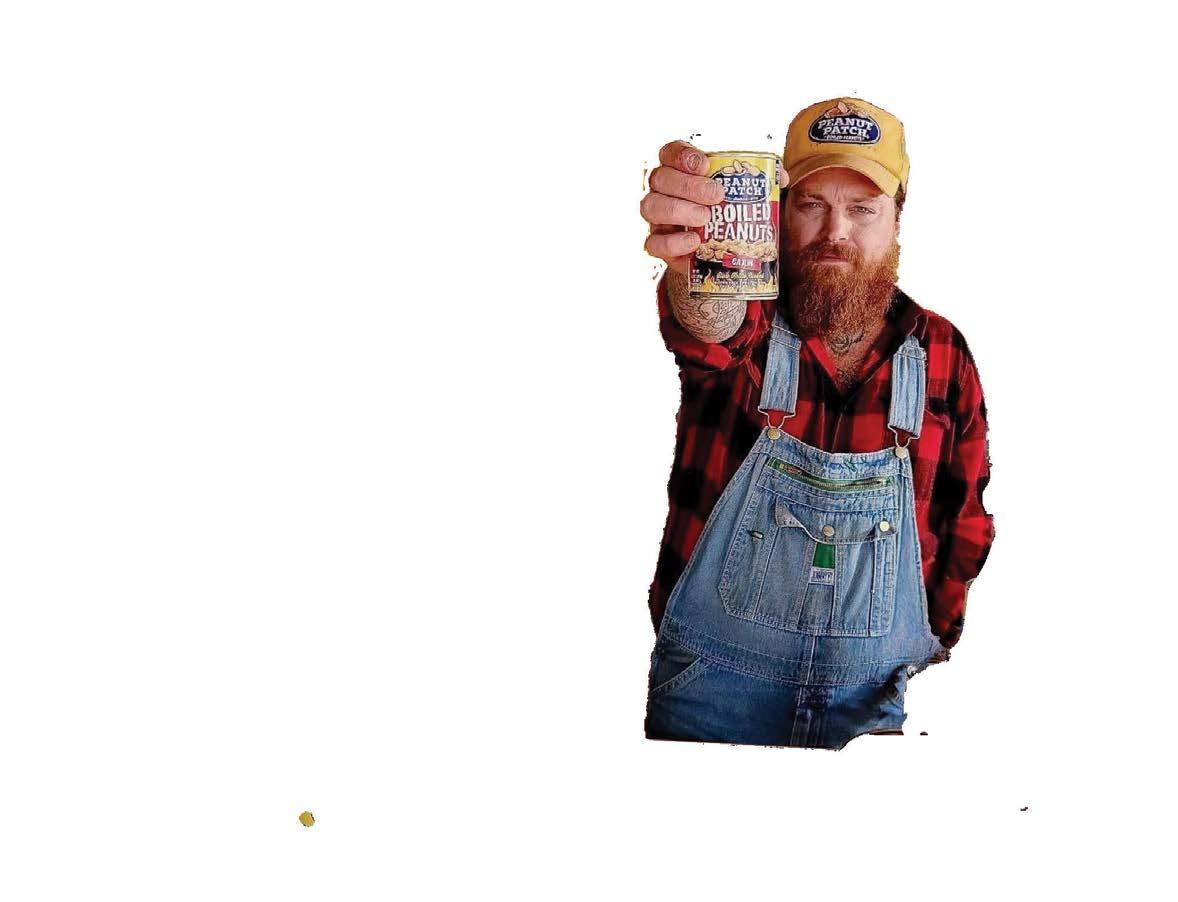





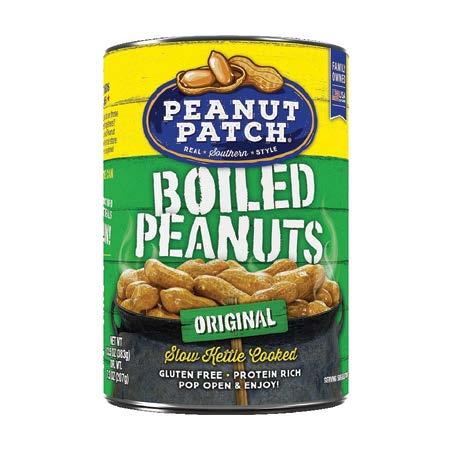
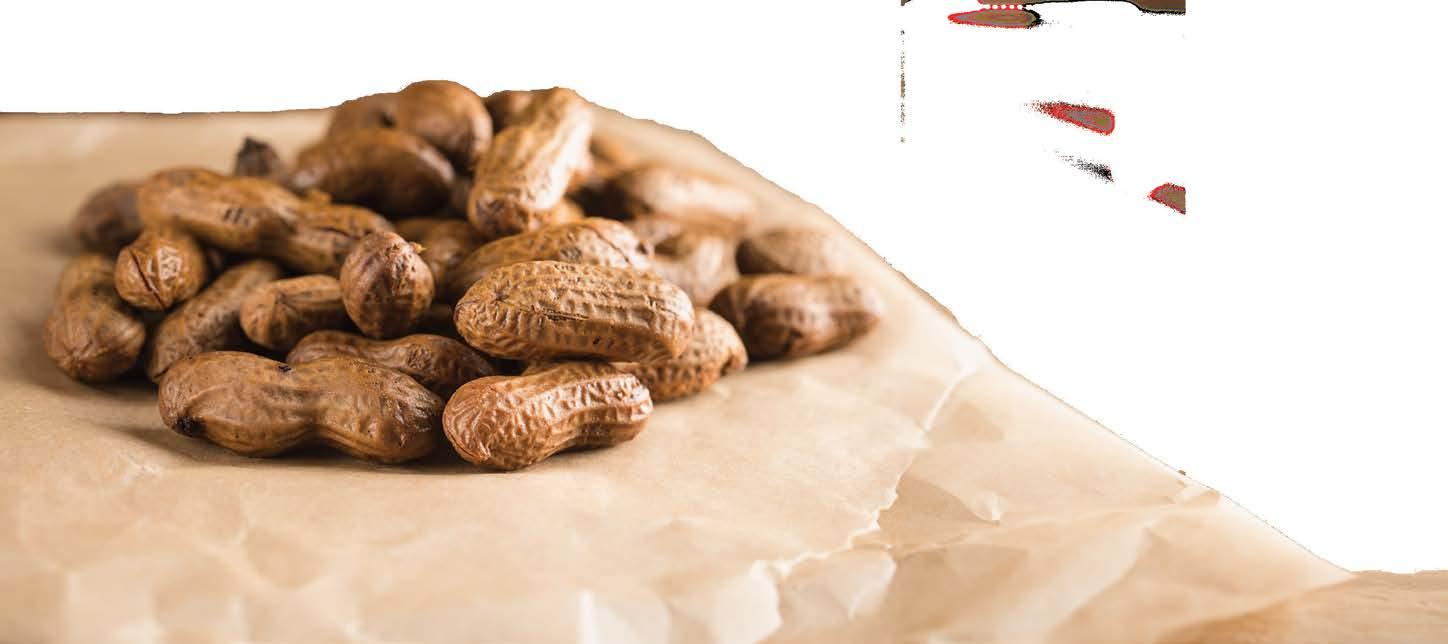


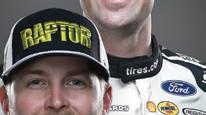













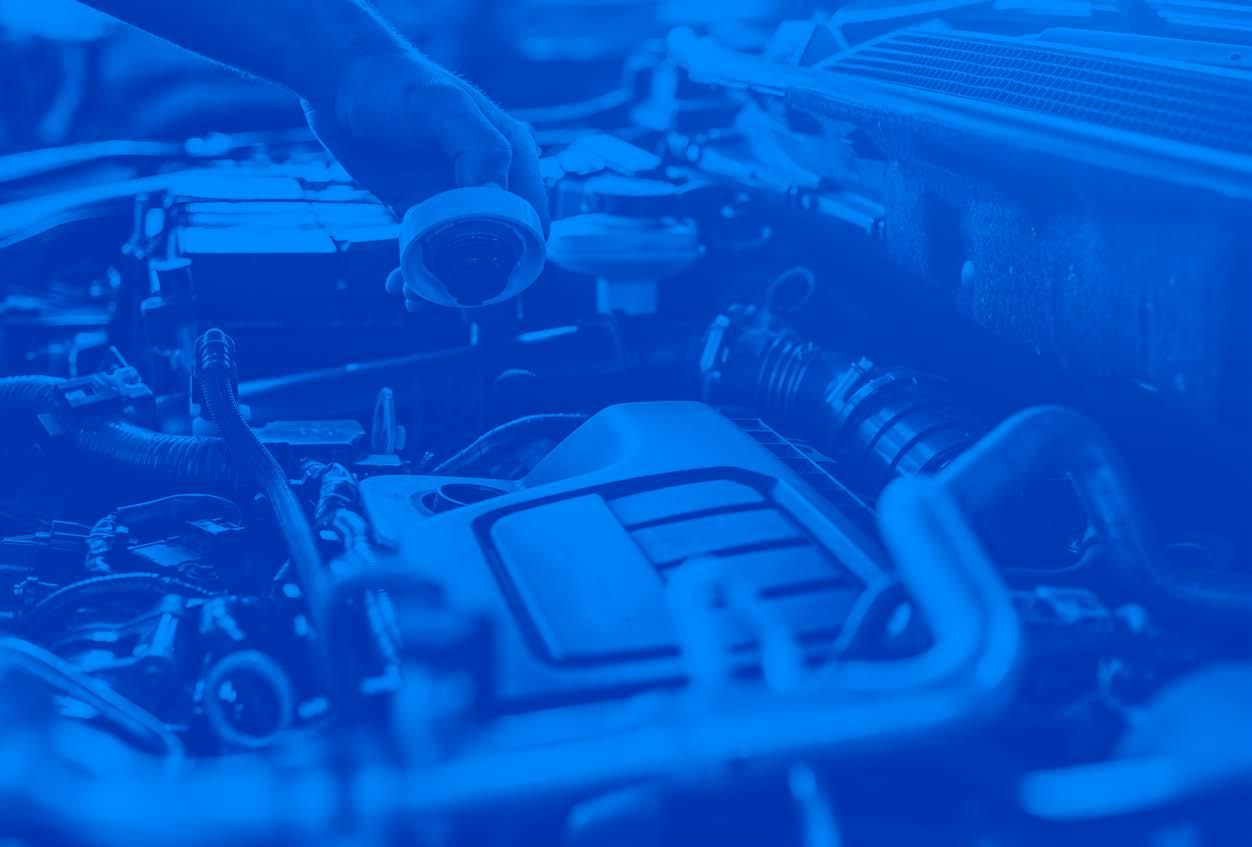
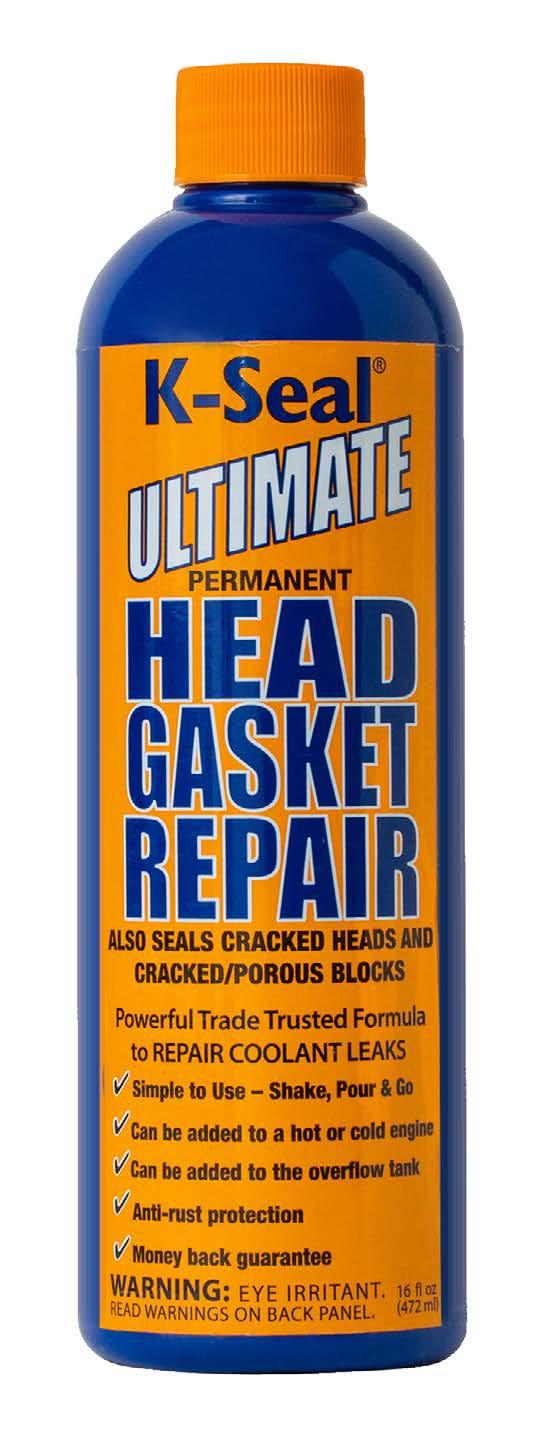







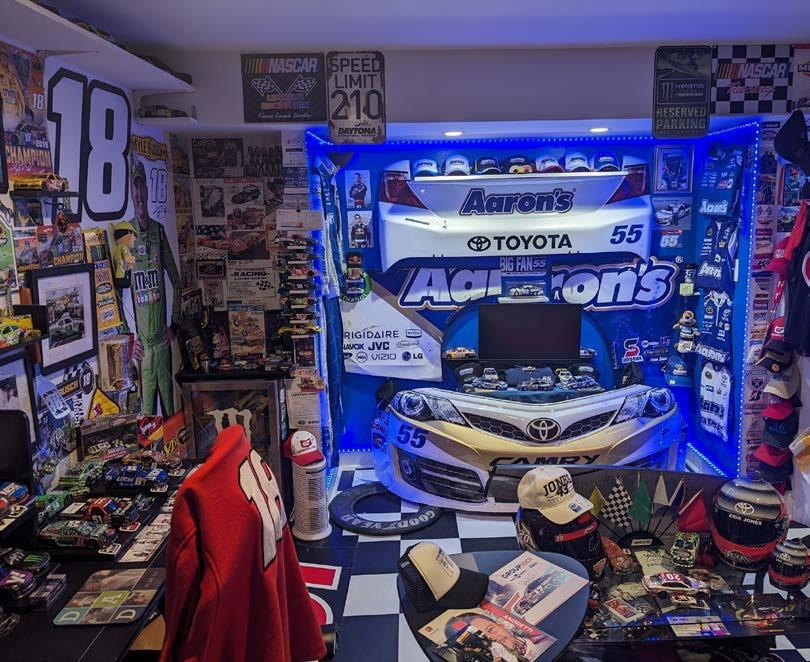
My parents took me to my first race at Pocono when I was 4 years old, and I have been obsessed with NASCAR ever since. Living around the country has allowed me to experience more than 80 NASCAR races and little by little I built my collection.
When I first moved to Delaware, my wife built me a NASCAR room. She has been helping me find NASCAR memorabilia since 2015.
We planned to move to the beach and having our next house built gave me the opportunity to have a custom room based around everything I have collected.
My prized possession is a Kyle Busch 2013 Texas
NAME: Gregory Bonath
HOMETOWN: Rehoboth Beach, Delaware
NASCAR FANDOM: 37 years
FAVORITE DRIVERS: Kyle Busch and Daniel Suarez
FAVORITE TRACKS: Pocono and Dover
FAVORITE NASCAR MEMORY: My wife surprising me with flights, a hotel room and tickets to Homestead in 2015 to watch Kyle Busch win the championship
DESIRED RACE TEAM
JOB OTHER THAN THE DRIVER: Tire specialist
Lane cowboy hat. That’s followed by my Aaron’s Dream Machine wall, which I have the front and back bumpers, rear quarter panels, a fire suit, pit shirt, die-cast cars and signed pieces of the interior of the car. I’m still on the search for a 2014 Aaron’s Dream Machine hood to round out the wall.
I am very grateful to my wife for supporting this fixation; the drivers and crew members I have been lucky enough to meet and spend time with; and my parents for getting me started on a lifelong journey that I now share with my children.
Go Kyle! Go Daniel!
NASCAR POLE POSITION
AN OFFICIALLY LICENSED
PUBLICATION OF NASCAR 23110 STATE ROAD 54, SUITE 293 LUTZ, FL 33549
EMAIL: INFO@AE-ENGINE.COM
WEB: POLEPOSITIONMAG.COM; AE-ENGINE.COM
THE CREW
PUBLISHER: CRAIG BARONCELLI
COMMERCIAL
VICE PRESIDENT: DAVID WATSON
DIRECTORS: WILL OVERTON, MATT SMITH, ROWLAND GEORGE, ARNOUT KOK CONTENT
CREATIVE DIRECTOR: JOE RABUCK
DIGITAL MEDIA DIRECTOR: NICOLE COOPER
DIGITAL CONTENT DIRECTOR: JOSH MULL
EXECUTIVE EDITOR: ERIC ESTEPP
COPY EDITOR: KEITH WALTZ
EDITORIAL: JOSHUA LIPOWSKI
CONTRIBUTORS: RICK HOUSTON, JARED TURNER, DUSTIN ALBINO
STAFF ASSISTANTS: AIDAN ANDERSEN, ETHAN ANDERSEN, SHOGUN & WINNIE
SPECIAL THANKS TO: ANDREW ENGEL (NASCAR)
A.E. ENGINE SPECIFIES THAT POST-PRESS CHANGES MAY OCCUR TO ANY INFORMATION PRESENTED IN THIS PUBLICATION AND TAKES NO RESPONSIBILITY FOR GOODS OR SERVICES ADVERTISED.
NASCAR® IS A REGISTERED TRADEMARK OF THE NATIONAL ASSOCIATION FOR STOCK CAR AUTO RACING, INC.
MAIL ORDER: TO RECEIVE A SUBSCRIPTION TO NASCAR POLE POSITION MAGAZINE, SEND A CHECK OR MONEY ORDER FOR $30.95 TO: A.E. ENGINE, 23110 STATE ROAD 54, SUITE 293, LUTZ, FL 33549. PLEASE INCLUDE YOUR RETURN MAILING ADDRESS AND AN EMAIL ADDRESS AND MAKE THE CHECK PAYABLE TO A.E. ENGINE.
ONLINE ORDER: SUBSCRIPTIONS AND INDIVIDUAL COPIES CAN BE ORDERED ONLINE AT POLEPOSITIONMAG.COM.
DISTRIBUTION: IF YOU ARE A BUSINESS OR AN ORGANIZATION INTERESTED IN DISTRIBUTING COPIES OF NASCAR POLE POSITION MAGAZINE, PLEASE CONTACT CRAIG BARONCELLI AT CB@ AE-ENGINE.COM.
SALES INQUIRIES: IF YOU ARE INTERESTED IN ADVERTISING OR WOULD LIKE TO BECOME A FIELD REPRESENTATIVE, PLEASE CONTACT DAVID WATSON AT DKW@AE-ENGINE.COM.
For Chandler Smith, there’s a lot to love about life right now.
A first-year Joe Gibbs Racing driver in the NASCAR Xfinity Series, Smith is enjoying all the benefits that come with competing for one of the sport’s top teams, and his results on the track this season are a testament to both his talent and the equipment he’s fortunate to drive.
Smith can’t complain about life away from the track either, as he’s a husband and a father of two young boys whom he adores and enjoys spending as much time with as possible.
In the following Q&A, get to know Smith, who turned 22 years old on June 26 and hails from the small town of Talking Rock, Georgia, in the North Georgia Mountains.
BY JOSHUA LIPOWSKI
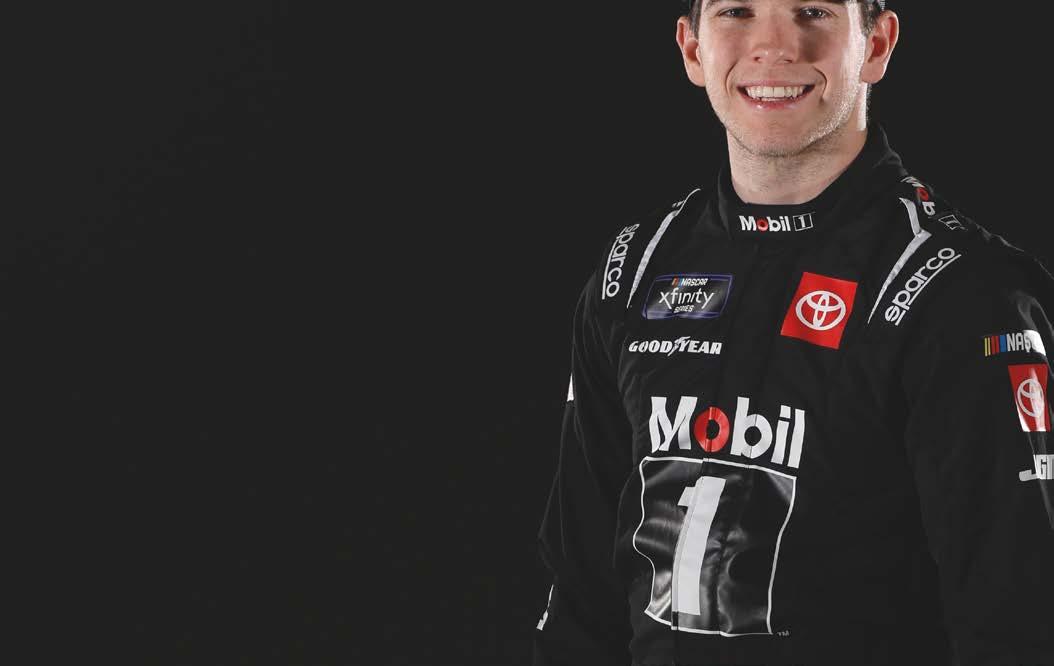
WHO ARE YOUR FAVORITE PEOPLE LIVING OR DEAD THAT YOU’D INVITE TO DINNER?
DEFINITELY MY POP, because I never got to meet him. My grandma passed away actually during the Daytona Xfinity Series race this year, and I’ve heard so many stories about how when my pop was alive how different my grandma was. Definitely my nana and my pop, because I never got to meet him and I’ve heard how much he always enjoyed racing and loved it.
So, it would be really cool just to sit down and see how my nana was around him and see them together and talk racing with them. I think that would be really, really neat. I definitely would want my wife there, too.
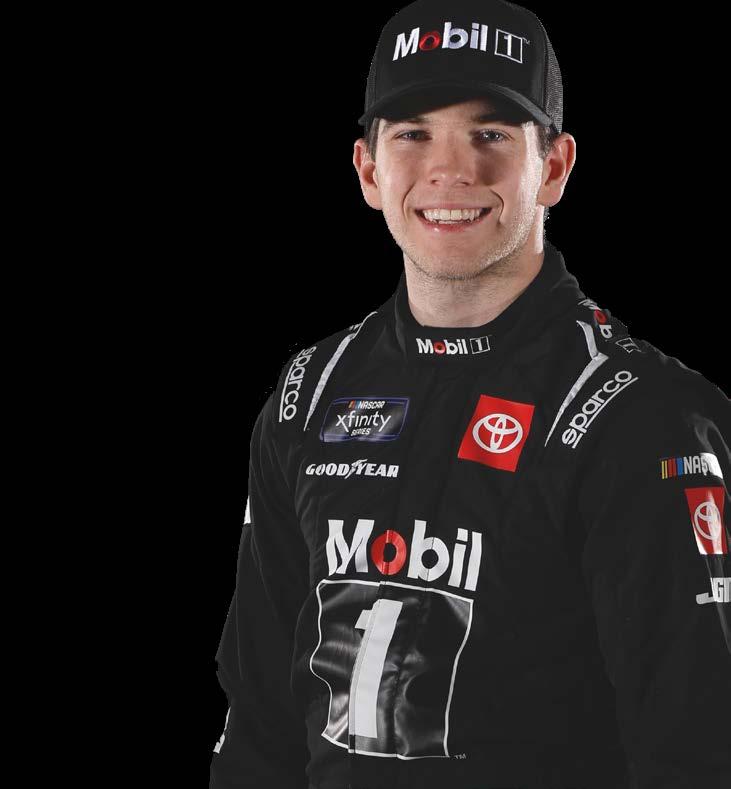
I’D PROBABLY TRY TO HELP convert people to Christianity and turn their life over to Jesus Christ, because there’s a lot more to life than all this materialistic crap that we have here on earth. The average person now lives to be in their 70s or 80 or whatever it is, but there’s literally an eternity that once you die you spend in either in hell or heaven.
This is a holding place before you go there, and the decisions you make on this earth are literally eternal-life decisions. So, that’s one of the most serious things that people need to be aware of. … That’s probably a controversial answer, but it doesn’t bother me.

YESTERDAY WAS A PRETTY perfect day for me. I got my Traeger grill in and put that thing together and smoked some chicken wings on it, and it was a beautiful day. We own 12 acres of land out in the country and have got a little pond and a little creek. It wasn’t too hot and there was a little bit of a cold breeze, and I just stayed outside with my boys and my wife and smoked those chicken wings and had a good dinner and slept really good. That’s a perfect day for me – just hanging out with my family and enjoying the outdoors. I love getting outside.
It’ll be especially fun when hunting season comes around because there’s – I don’t know – 12 deer that run through my backyard every single day around 12 o’clock.
WHAT’S YOUR FAVORITE KIND OF MUSIC AND WHAT WAS THE LAST CONCERT YOU ATTENDED?
COUNTRY. I DON’T GO TO concerts, because they sound like crap in person compared to what you actually listen to. It completely ruins it. You can go listen to some country artist right now on Spotify, and if you go to their concert and they sing the exact same song, I will put money on it: They don’t even sound close to identical – and it’s horrible. It’s horrendous. It’s like, “What the heck? This is not what I was expecting.”

BY EVAN LIU AND PAIGE MARTIN
Another edition of NASCAR Pole Position Magazine, another opportunity to show off a fan’s awesome collection of NASCAR memorabilia.
Trey Sichi recently shared multiple videos on X, showing his numerous displays of NASCAR stuff. In total, his collection includes just under 2,000 die-casts – 1,930 to be exact – with more surely to come. With so many choices and favorites to choose from, here are most of them:
In this cubby, Trey has a selection of die-cast cars from the 1980s and 1990s up to the present, along with a pair of larger Terry Labonte cars. In the back is a stuffed bear sporting Labonte’s No. 5. It’s next to a photo of a young Trey shaking hands with Labonte, and there’s even a signed Coca-Cola bottle.
There’s nothing quite like pristine die-casts still in the box and this photo contains several of them through multiple generations. Alongside an array of smaller cars, there are several die-casts still in boxes such as Dale Jarrett’s No. 88 UPS Ford, a throwback Corey LaJoie scheme, an old Jerry Nadeau car and a Star Wars Racing No. 38 car.
This might be the most colorful and tastiest photo in the collection. It features a No. 3 Oreo car run by Dale Earnhardt Jr. and a Kevin Harvick Reese’s car. Speaking of Harvick, there is also an old Sonic No. 29 Chevrolet, which only ran in the 2002 season.
A

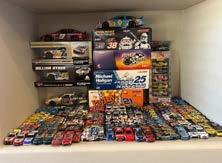
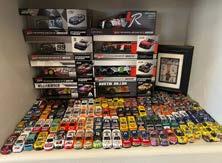
B C D E

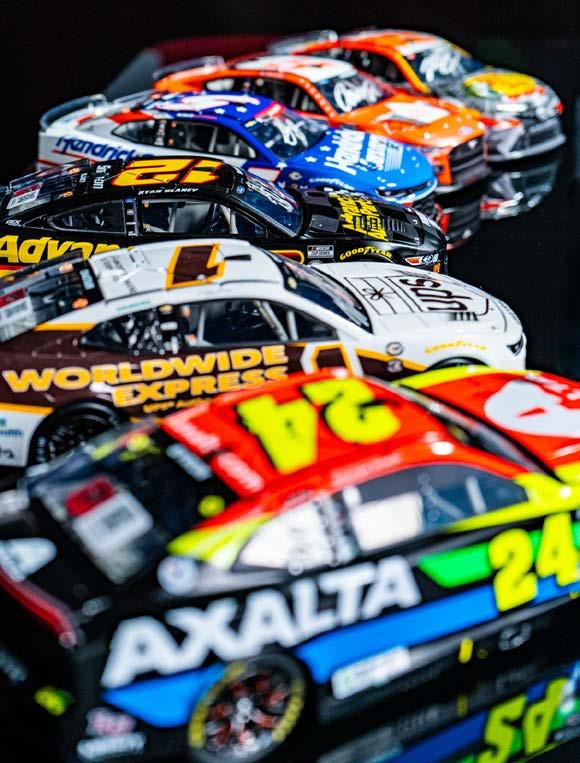

In this photo, there are some of the most unique paint schemes out there. There’s a gold No. 3 car of Austin Dillon, a unique 2020 BodyArmor Ryan Blaney die-cast and the Axalta scheme honoring Kobe Bryant that Willliam Byron ran in 2020 at Auto Club – all of them still in the box. Finally, cars aren’t the only die-casts in Trey’s collection as this shot includes hauler die-casts for Terry Labonte and Kasey Kahne. Check out his picture with Kahne at Phoenix! There’s a Jeff Gordon stuffed bear and a Dale Earnhardt plane. Plus, there are unique Dale Jarrett collectibles – including the flaming UPS truck!






















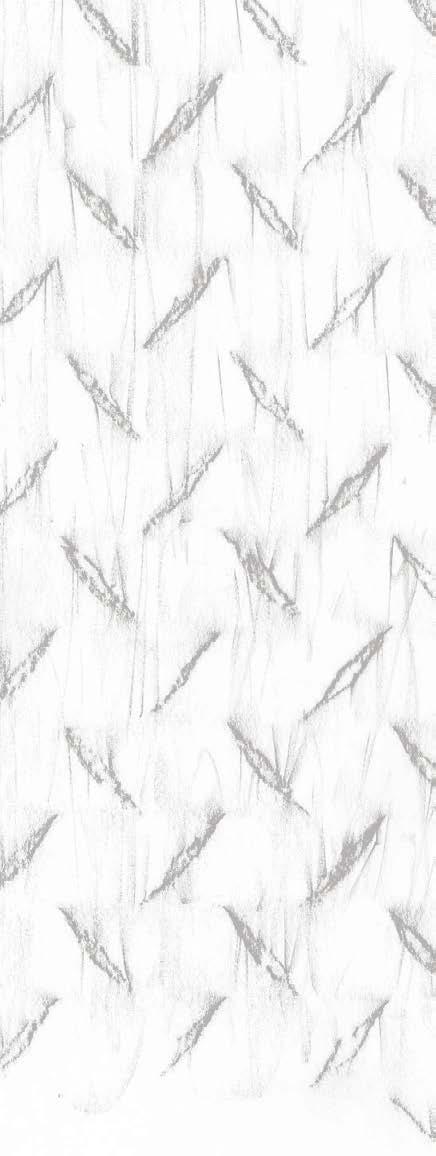
After working his way through the various divisions of stock car racing and capturing the 2022 NASCAR Advance Auto Parts Weekly Series national championship, Layne Riggs is now in his first full season of NASCAR Craftsman Truck Series competition, driving the No. 38 Ford for Front Row Motorsports. Riggs recently sat down with NASCAR Pole Position for a Q&A about his career path: WHAT ARE SOME OF YOUR EARLIEST MEMORIES OF GROWING UP AROUND THE SPORT?










When I was born, my dad (Scott Riggs) was driving the No. 10 Nesquik car in the Busch (now Xfinity) Series and pretty much was in his heyday, winning races. You get so used to it that I wasn’t really interested in racing when I was younger. It really didn’t get to that point until he was starting to get out of the sport, and I was getting to the age where I said, “Wow, that was really cool, and what a privilege to even be seen doing all those things.” It made me want to do it myself.
There were good and bad things about the timing of it all. The good part was dad’s been at pretty much every single one of my races. He was my crew chief and spotter back when I was 10 years old, and there was a solid father-son relationship that we got to do, which was awesome. But it made things a little bit tougher in the aspect of me getting opportunities early on in my career because he was out of the sport.
WHAT SPARKED YOUR DESIRE TO PURSUE A CAREER IN RACING?
I started racing full-size cars at 10 years old at Orange County Speedway in the Pure Stock division. I learned really quick what race craft is all about. My arch nemesis and rival was 65 years old when I was 10, so I didn’t grow up racing in classes with kids my age. I think that helped me a lot, but I think just the competitiveness and really winning is what it’s all about.
There’s no better high or feeling than being in Victory Lane with your family,
your team, and everybody around you.
HOW DID THE OPPORTUNITY WITH FRONT ROW MOTORSPORTS COME TOGETHER?
It was really a culmination of a lot of things. I got those first couple of opportunities to drive for Stewart Friesen, and the biggest thing is the local sponsors that are really tight and close to me – Puryear Tank Lines and Infinity Communications; those people really had a lot of faith in me.
I went and showed what I had and what I could bring to the table, and I think Bob Jenkins and Jerry Freeze saw from afar and said, “Hey, this guy’s got it, we need to latch on to him.”
I remember talking to Freeze the morning of the Martinsville race in the Kaulig car, and I was thinking, “Man this is my last race. I might never get another opportunity.” Freeze came over to me, and we met, and he said, “You want to drive our truck next year?” I said, “Heck yeah, I do! Who wouldn’t want to drive this truck?” It really caught me off guard.
He called me that Monday and said, “Hey, it sounds like the seat’s yours,” so we just had to put the deal together. Super thankful to everybody who made it happen. It’s a dream come true for sure.
WHAT TIMELINE/GOALS DO YOU HAVE FOR YOUR CAREER?
I think there’s no real rush. I’ve seen several people who have gotten rushed up to the upper series and struggled. I would way rather be winning races in the Truck Series than going and running 25th to 30th in the Cup Series.
When I show up to the race track every weekend, I want to feel like I have a shot to win the race no matter what. Not just a lucky shot, but a true, dominant shot. I don’t feel like I’m ready to move up unless I feel like I have the opportunity that I can do that in any series I’m in. Here at Front Row in the Truck Series, I feel like I have a shot every weekend we show up to the track, so I’m not going to rush it.
If the time comes and the opportunity is right, sure I’m going to take it, but I don’t have a timeline.
We love being NASCAR’s official Cooler & Drinkware sponsor. There’s something about the over-engineering of it all—the precision, the endurance, the screaming blur of the RTIC No. 1 car flying by at 200 MPH on lap 97—that reminds us why we started making outdoor gear in the first place: to push performance beyond what’s ordinary. The difference for us is what winning looks like. A Soft Cooler still loaded with ice after a full day in the grandstands? That’s a win.
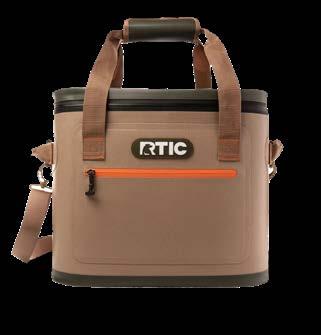
A Tumbler that’s still cold after hours in a hot car? Also a win. A Wheeled Cooler that still rolls fine after being towed full speed down a drag strip? That was a SOLID win. (Just ask Corey LaJoie.)
But our biggest win of all is making top-quality gear that’s still affordable on a real-life budget.
We believe everyone deserves to enjoy the outdoors with Coolers & Drinkware they can count on. That’s why we keep our overheads low and our advertising simple, so we can price our gear fairly and make it available in more stores nationwide. That means, no matter where the race is, you can count on RTIC to lock in the cold from the first lap to the last. Because we’re driven by performance, just like you.
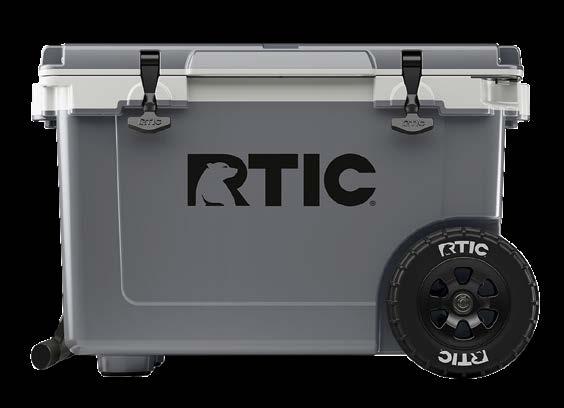
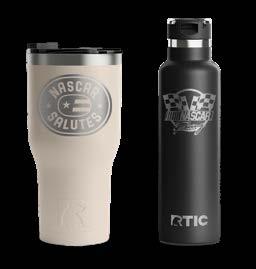
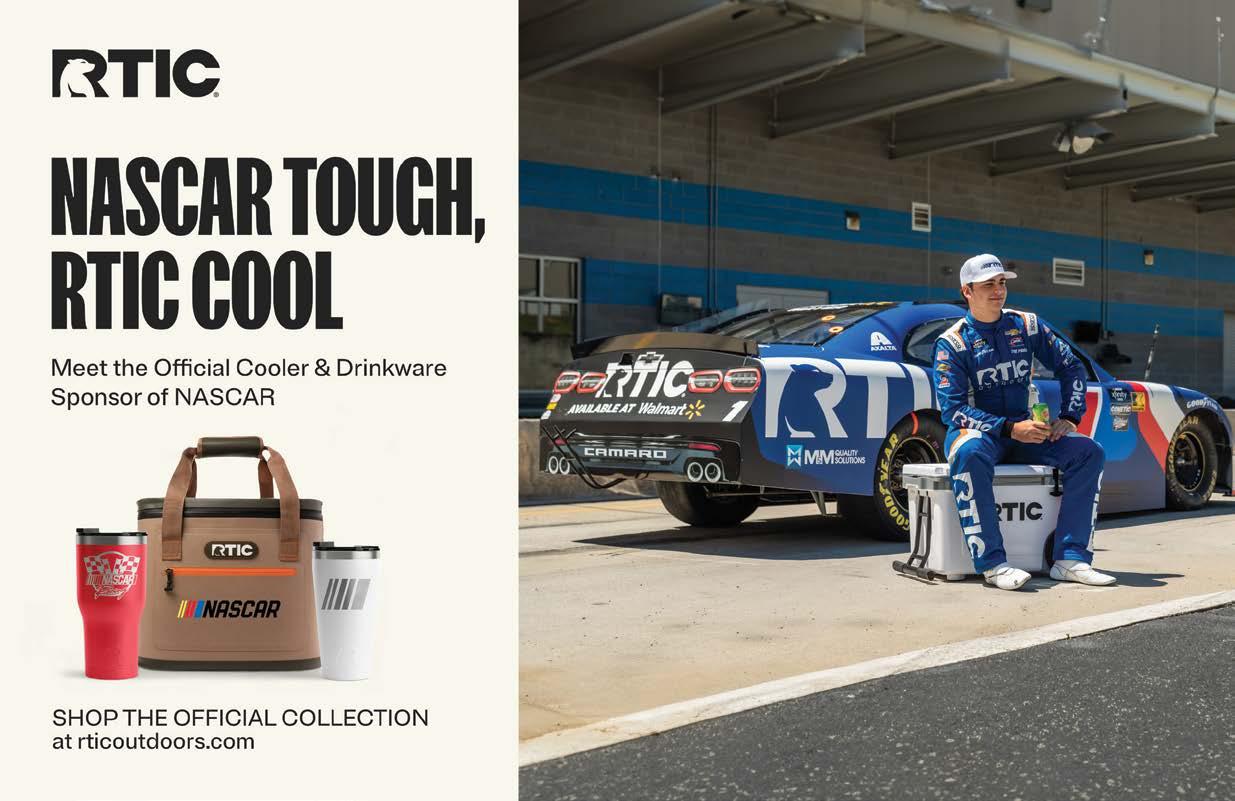
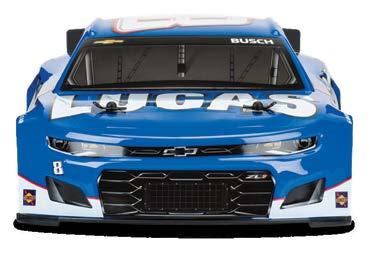
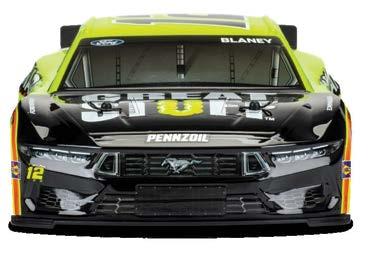
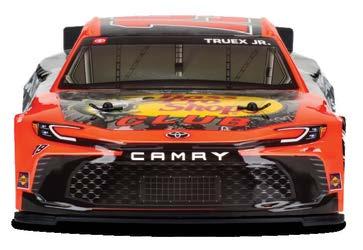

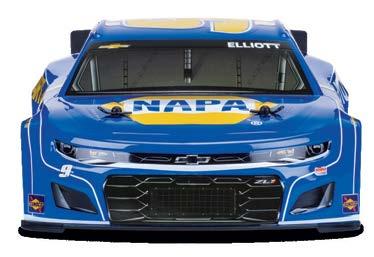
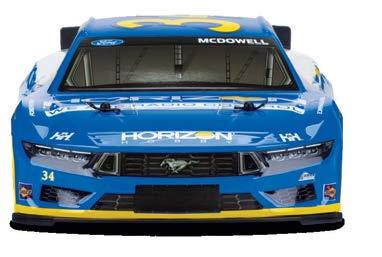
Put yourself in the driver’s seat with the Losi NASCAR® RC Race Car. This rugged, ready-to-run, hobby-grade RC stock car offers 20+ mph speeds and realism you won’t believe. Drive it. Tune it. Race it. Add option parts and make it yours. Choose your favorite livery and build your own NASCAR legend! Learn more at Losi.com

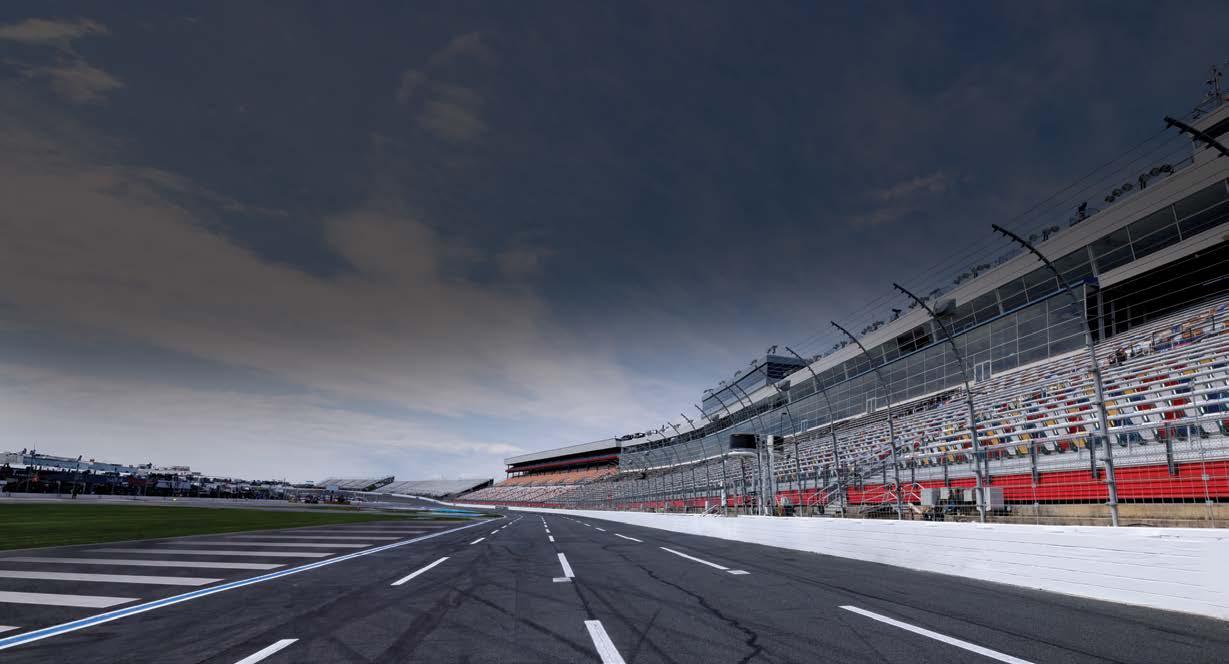
Anchorage House of Hobbies, 803 Spenard Rd, Anchorage, AK 99503
ARIZONA
AZ Turn and Burn RC, 12851 W Bell Rd Suite 112, Surprise, AZ 85378
CALIFORNIA
Cen Cal Hobbies, 401 Bangs Ave suite C, Modesto, CA 95356
Dynamic Hobbies, 811 E Florida Ave, Hemet, CA 92543
Fast Track Hobbies, 4420 Granite Dr STE 400, Rocklin, CA 95677
HobbyTown, 340 N McKinley St #107, Corona, CA 92879
HobbyTown, 9747 Mission Gorge Rd, Santee, CA 92071
Pacific Coast Hobbies, 1747 Pacific Coast Hwy, Lomita, CA 90717
Pegasus Hobbies, 1458 W 7th St, Upland, CA 91786
RC Visions, 15071 Goldenwest St, Huntington Beach, CA 92647
COLORADO
Colpar’s HobbyTown, 687 N Academy Blvd, Colorado Springs, CO 80909
HobbyTown, 9120 Wadsworth Pkwy, Westminster, CO 80021
FLORIDA
K & K Hobby Shop, 3835 Tamiami Trl, Port Charlotte, FL 33952
My Tobbies - Toys & Hobbies, 2218 University Square Mall, Tampa, FL 33612
GEORGIA
HobbyTown, 840 Ernest W Barrett Pkwy NW Suite 650, Kennesaw, GA 30144
IDAHO
Action Hobbies LLC, 2483 E. Fairview Ave., Ste. 103, Meridian, ID 83646
ILLINOIS
HobbyTown, 15601 S 94th Ave, Orland Park, IL 60462
Leisure Hours Hobbies, 16300 S Lincoln Hwy #30, Plainfield, IL 60586
INDIANA
Asylum Xtreme, 531 Eastern Blvd, Clarksville, IN 47129
Phil's Hobby Shop, 3938 W Jefferson Blvd, Fort Wayne, IN 46804
Singer Hobbies, LLC, 2072 Burton Ln, Martinsville, IN 46151
KANSAS
Dee & Mee Hobbies, 5331 SW 22nd Pl, Topeka, KS 66614
KENTUCKY
Scale Reproductions, Inc., 3073 Breckenridge Ln, Louisville, KY 40220
LOUISIANA
Big Boy Toys & Hobbies, 2930 Johnston St, Lafayette, LA 70503
MASSACHUSETTS
Hobby Quarters, Commercial St, Foxborough, MA 02035
MICHIGAN
Larry's Performance RC, 48825 Van Dyke Ave, Shelby Twp, MI 48317
Nankin Hobby Southgate, 12020 Fort St #1005, Southgate, MI 48195
Nankin Hobby Farmington, 33350 W 9 Mile Rd, Farmington, MI 48336
Nankin Hobby Ypsilanti, 1480 Washtenaw Ave, Ypsilanti, MI 48197
MISSOURI
Mark Twain Hobby Center, 2793 W Clay St, St Charles, MO 63301
NORTH CAROLINA
Anderson R/C, 1101 Mendenhall St, Thomasville, NC 27360
Hangar 18 Hobbies, 112 Kilmayne Dr, Cary, NC 27511
NEBRASKA
HobbyTown, 4107 Pioneer Woods Dr #108, Lincoln, NE 68506
NEW JERSEY
HobbyTown, 1256 Indian Head Rd Unit 29, Toms River, NJ 08755
NEW YORK
Bayshore Hobbies and Toys, 2056 Sunrise Hwy, Bay Shore, NY 11706
Field's Hobby Center, 3523 Union Rd, Cheektowaga, NY 14225
Performance Hobbies, 15 W Main St, Webster, NY 14580
Small Addictions RC, 1250 Upper, Front St, Binghamton, NY 13901
Willis Hobbies Inc., 300 Willis Ave, Mineola, NY 11501
OHIO
HobbyTown, 12108 Montgomery Rd, Cincinnati, OH 45249
The Hobby Shop, 153 N Springboro Pike # A, Dayton, OH 45449
OREGON
D's Hobbies, 61545 S Hwy 97, Bend, OR 97702
PENNSYLVANIA
Shaffer’s Train Shed, 630 N 4th Ave, Altoona, PA 16601
Sports Zone Toys & Comics, 359 Market St, Sunbury, PA 17801
SOUTH CAROLINA
The Hobby Connection, 4148 Calhoun Memorial Hwy, Easley, SC 29640
TENNESSEE
HobbyTown, 11145 Turkey Dr, Knoxville, TN 37934
TEXAS
Performance RC LLC, 3609 Business Center Dr Suite 116, Pearland, TX 77584
Radio Control Headquarters, 14910 Nacogdoches Rd. Ste 110. San Antonio, TX 78247
VIRGINIA
HobbyTown Richmond, 9900 W Broad St Ste B, Glen Allen, VA 23060
UTAH
West Valley Hobbies, 1765 W 5400 S, Taylorsville, UT 84129
WISCONSIN
HobbyTown West Allis, 1708 S 108th St, West Allis, WI 53214

WEST VIRGINIA
Nitro Hobby & Craft Center, 104 21st St, Nitro, WV 25143
CANADA
Eliminator-RC, 120 Higgins Ave, Winnipeg, MB R3B 0B4, Canada
Great Hobbies, Mississauga, ON L5N 8E1, Canada
BY JARED TURNER
Want to protect your hearing at the race track while being able to socialize, communicate clearly, and support your favorite Hendrick Motorsports driver?
Insert EAROS into the conversation.
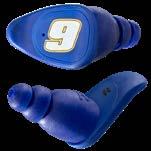
High-fidelity hearing protection is a smart alternative to earplugs that allows you to turn the volume down to a safe level and still enjoy the thrilling sounds of the race. These innovative hearing protectors are designed to reduce noise by 20 decibels, making it easy to chat with friends and soak in the atmosphere, all while proudly showcasing your support for car numbers 5, 9, 24, and 48.
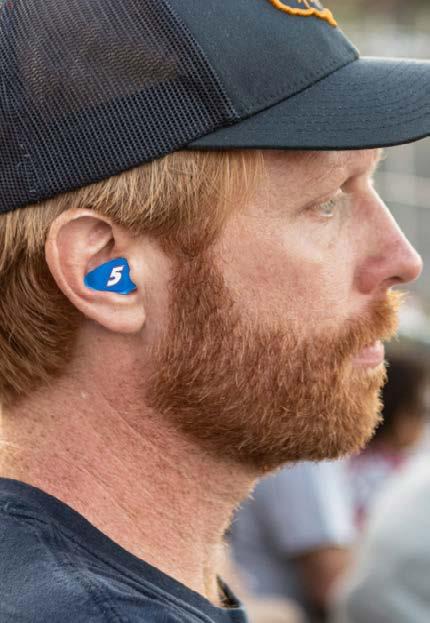
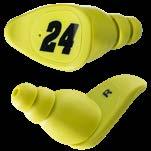
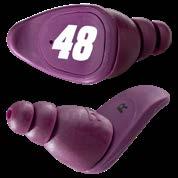
This is now possible thanks to a licensing agreement between Hendrick Motorsports and EAROS, a New York City-based company specializing in state-of-the-art hearing protection. Additional support was provided by Hendrick Motorsports Vice Chairman and NASCAR Hall of Famer Jeff Gordon, who is also an investor and advisor in EAROS.
For a modest price, NASCAR fans can purchase a pair of No. 5, 9, 24 and 48-branded hearing protectors that reduce the noise level around them by no fewer than 20 decibels without compromising their ability to enjoy the full spectrum of sound frequencies.
That’s especially nice at the race track, where the roar of the engines can cause hearing damage without proper hearing protection but is nevertheless part of the fan experience.
“You see people all the time at the races talking to their friends and they’re pulling each other’s radio off to scream in each other’s ears, or they’re pulling their earplugs out to talk to each other,” said Peter Ragonetti, EAROS’ chief product engineer. “What’s really cool about this product is you don’t have to take it out. You can sit there in the grandstands with cars going by, and you can talk to each other and hear each other.
“There’s still that overall ambient noise, but when you speak directly to someone who is wearing one of these and you’re wearing one, you can have a conversation in a 120-decibel environment comfortably, without screaming at each other.”
Manufactured in New Jersey and all made in America, EAROS Hearing-Protection acoustic filters are designed to be more effective and less easily misplaced than traditional foam earplugs – while being more fashionable and affordable than options that cover the entire ear.
“We were really diligent on functionality and form,” said EAROS founder and CEO Ronnie Madra, who worked closely with MIT
acousticians and vibration engineers, a top medical device manufacturer in Upstate New York, Ragonetti and others over several years to have the EAROS product patented and brought to market.
“It needed to look great, it needed to be packaged well, it needed to work and it needed to really be acceptable –acceptable to an audience that doesn’t wear hearing protection or that wears mostly earplugs.”
EAROS Hearing-Protection professional-grade protection products are available without the Hendrick branding, but for fans of one or more of the Hendrick wheelmen, having a Hendrick driver’s car number featured prominently on their high-quality hearing protection is an added bonus.
“Hendrick’s drivers are some of the best race car drivers in the world, and being able to work with a brand like Hendrick and a company like Hendrick, we think we have the opportunity to sort of say, ‘There’s a hearing-protection option that falls between those $100 big over-ear clunky things and those cheap foam earplugs,’” Ragonetti said.
EAROS’ innovative solution to hearing protection comes in six distinct product lines that include the four limited edition Hendrick Motorsports EAROS SPORT derivatives as well as more non-branded EAROS ONE and EAROS SPORT options.
EAROS products are available at roughly half of all CVS Pharmacy stores nationwide, about 200 Walmart stores and various locations around New York, as well as online at Amazon and the company’s website.
Madra, who began working with Ragonetti in 2015 to develop the EAROS concept, is no stranger to hearing issues from loud noises. A successful nightclub entrepreneur for two decades, Madra suffers from tinnitus – a persistent ringing in the ears – that stems from his days in environments where the decibel level was dangerously high.
“Since I was in the club business, I built this sound system and basically put one of the world’s most powerful sound systems in this 3,500-square-foot-space,” Madra said. “They usually put those in arenas, right? And, I thought that was a cool thing. Everyone loved the fact that, wow, big DJs came and played. … You wanted the right equipment, so we built that.
“And, then we also had inexperienced DJs that would come and play, and they didn’t know how to really use the equipment properly, so they would drive the system and you would get up to 150 decibels. Young ears will tolerate it, but after prolonged exposure, it becomes irreparable damage, and then it becomes a real problem.”
Madra founded EAROS to provide others with the hearing protection he desperately needed during his time as a nightclub operator. The tinnitus he developed from exposure to high volume will never completely go away, although it’s more manageable now than it was many years ago – when it led to some bouts with depression.
“I’ve learned how to find purpose through the pain,” Madra said.
Learn more at earos.com.
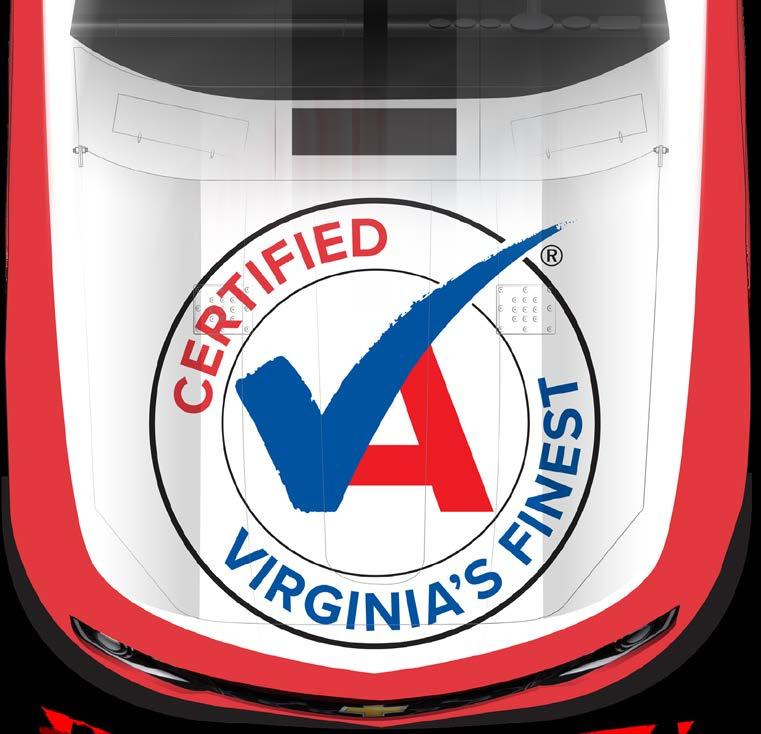


BY RICK HOUSTON, HOST OF THE SCENE VAULT PODCAST
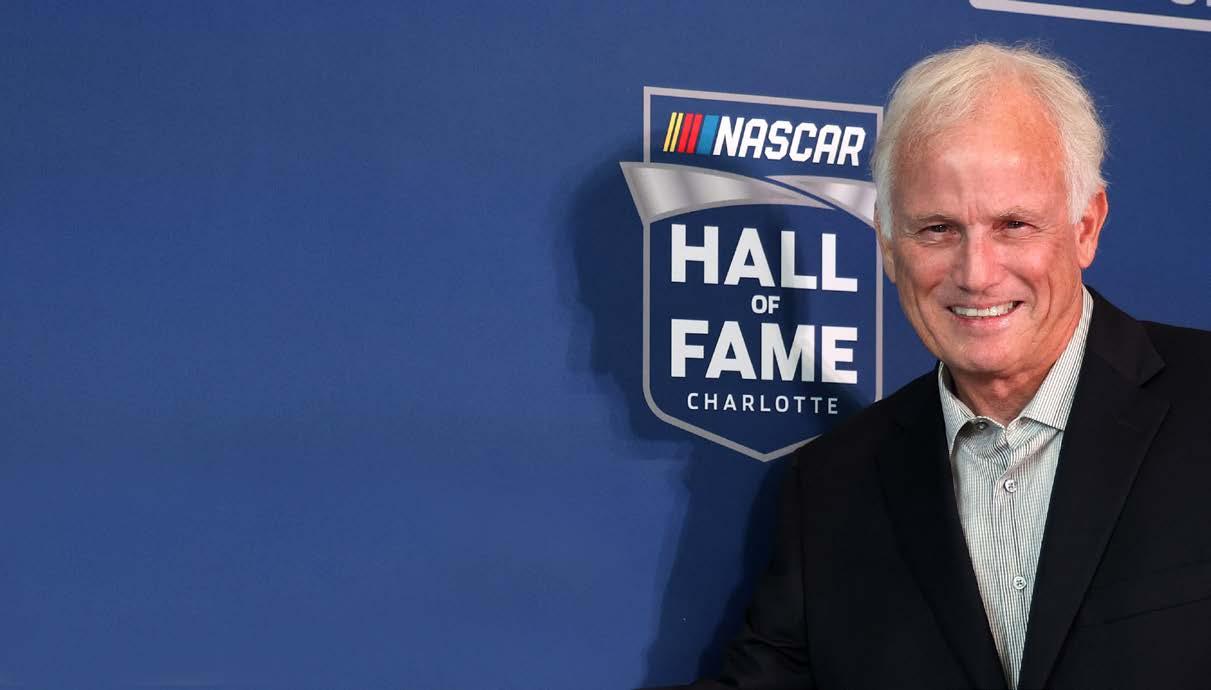
Ricky Rudd had raced go-karts and motocross bikes but had never driven any type of stock car prior to making his NASCAR Cup Series debut at Rockingham Speedway in the early spring of 1975. He was all of 18 years old, at a time when drivers weren’t considered ready for big-time automobile racing until they were at least 30.
The learning curve was a tough one. Acceptance from the rest of the garage was slow in coming. He was young, and he looked quite a bit younger. After changing into his street clothes, Rudd was once told to go change back into his driver’s uniform so he wouldn’t be mistaken for somebody’s kid brother.
Underneath that fresh-faced exterior, however, beat the heart of a lion. Or a Rooster, whichever the case might actually have been.
Rudd would come to be known as an extraordinarily fierce competitor, and his tough-as-nails demeanor would one day lead him to the NASCAR Hall of Fame. That day will be Feb. 7 when the native of Chesapeake, Virginia, is inducted among the Class of 2025.
Now 67 years old, Rudd recently talked with Rick Houston, host of The Scene Vault Podcast, about finally becoming a Hall of Famer.
RICKY, WE HAVEN’T SEEN YOU FOR A WHILE. AND THEN ALL OF A SUDDEN, THE NASCAR HALL OF FAME. YOU WEREN’T THERE THAT DAY.
Actually, I wasn’t there, but I got a text and I was able to get there pretty quickly. WHAT WAS YOUR REACTION? WHO CALLED? WAS IT WINSTON (KELLEY, FROM THE NASCAR HALL OF FAME)?
I got a text from; I’m gonna let him stay anonymous right now, because I don’t know if he went outside the envelope. I don’t want to get anybody in trouble. But I got a text, literally, I think it was 4:20 p.m. and the announcements could be made at five o’clock. Basically, the text didn’t say that I was in the Hall of Fame. It said, “It’s in your best interest if you come on down to the Hall of Fame.”
It wasn’t real hard to figure that one out. I knew it was vote day and I said, “Wow, I can’t believe this.” But I still left the house not 100 percent sure if I was in a Hall of Fame or not.
WHEN THEY READ YOUR NAME, WHAT WAS THAT MOMENT LIKE?
It was kind of like almost disbelief. The years were getting more difficult because I was on the ballot for, I think this was the eighth year. So I was going through this process, which is a good thing to have to worry about. The days would come and go and it’d be a huge letdown.
So the last couple of years, I didn’t get too excited about it. I knew when vote day was, and I knew I needed to be in the Charlotte area on vote day, just in case, because we spend some time in Florida too.
So when I when I got the message to get down there, it was like kind of disbelief. I couldn’t hardly believe it.
YOU AND I TALKED BACK IN I DON’T KNOW 2009, ’10, SOMEWHERE IN THERE. AND AT THAT POINT, I MENTIONED THE NASCAR HALL OF FAME. YOU DIDN’T NECESSARILY BLOW IT OFF, BUT YOU BASICALLY SAID, “THERE’S A LOT OF PEOPLE THAT NEED TO GO IN AND THEN MAYBE WE CAN CONSIDER MY CASE.” WHAT DID IT MEAN TO YOU PERSONALLY TO FINALLY HEAR YOUR NAME ANNOUNCED?
You’re always shooting to win a race or win championships. Probably, my biggest race win was Indianapolis. That was really big, and it really still stands out in my mind. I never gave up on a championship and always went after it. We came close one year and finished second.

I think the Hall of Fame to me, what it says is that the people that we raced with, our peers, the guys we competed against day to day, a lot of those guys have a say in the votes. So I think it’s to know that you are recognized as one of the elite status guys to race during that era. It probably meant more to me than any championship could have ever meant.
WHAT DO YOU THINK FINALLY PUT YOU OVER THE TOP? I HAVE AN OPINION, BUT I WANT TO HEAR WHAT YOU HAVE TO SAY FIRST.
I think a lot of it had to do with the fans. The fans were really instrumental. I know there’s a write-in portion of the ballot. I don’t do a whole lot of online stuff, but I understand that the fans really went to bat and were starting to get pretty angry because if you lay records out and you look at the win column, and you look at top 5s, top 10s and things of that nature, we were starting to actually have credentials that maybe could have got us in a year or two earlier.
I think coming close a couple years ago on the vote; missed it by maybe one vote of getting in. I think the fans really helped push this thing through.
STEVE (WAID), WHAT DO YOU THINK PUT RICKY OVER THE TOP?
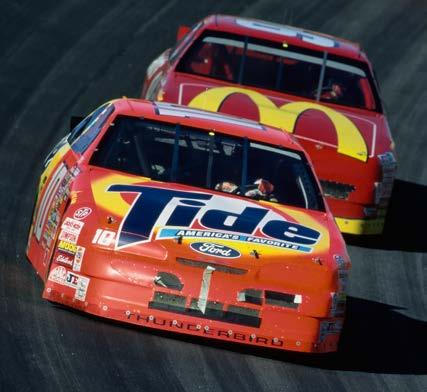
HERE’S MY OPINION. I THINK THAT THE CONSISTENCY AND THE WIN STREAK WERE CERTAINLY IN YOUR FAVOR, BUT ALSO RICHMOND 1984 AND MARTINSVILLE 1998. HARDCORE, OLD-SCHOOL RACE FAN TALK ABOUT HOW RICKY RUDD WON A RACE AT RICHMOND WITH HIS EYES TAPED OPEN. THEY TALK ABOUT MARTINSVILLE AND HE WAS PASSED OUT IN THE CAR. HE WAS COMATOSE, AND HE STILL WON THE RACE.
I REALLY DO THINK THAT THOSE TWO THINGS KIND OF PUT YOU OVER THE TOP.
RICKY RUDD
■ 1977 NASCAR Cup Series Rookie of the Year.
■ 1997 Brickyard 400 winner.
■ NASCAR Hall of Famer (2025).
■ Named one of NASCAR’s 75 Greatest Drivers (2023).
■ Most career starts in NASCAR Cup Series modern era (906).
Steve Waid: Sometimes when you have drivers who win races and championships, what it boils down to and putting them in the Hall of Fame is a singular achievement. In Ricky’s case, for the longest time, he held the record for the number of consecutive years with at least one victory. That was noted by a lot of people in those days, even Sports Illustrated, of all things. They had a section back then called By the Numbers. I was reading it on the airplane and it said, “Fourteen – number of consecutive years NASCAR driver Ricky Rudd has won at least one race.” I think that stuck in some voters’ minds. When you stop and think about it, that is really something unique.
I got off the plane. Ricky was in the same airport. I said, “Come here. Look at this. I showed him the Sports Illustrated, Ricky read it and his eyes got wide and he said, “Can I have this?”
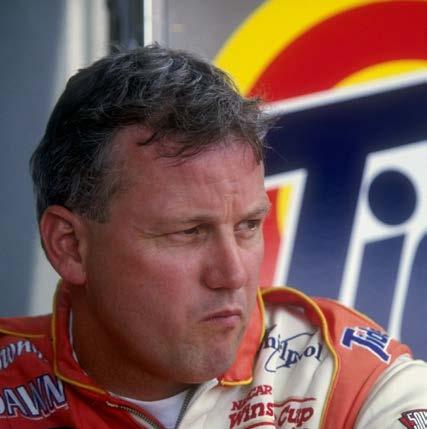
You know, that comes up quite a bit; what it takes to be a driver. In those days, I wasn’t trying to be a Superman. There were actually two things. I was trying to make sure that I didn’t get fired for being too sick on the job and lay out two or three weeks, because they’ll forget about you pretty quick.
But once you get through that, I look back at Cale Yarborough. When I think toughness, I think of Cale. I saw him get out of race cars with his hands bleeding. Bobby Allison, Richard Petty and Yarborough – those are the guys when I was coming through the ranks and those are the guys that were winning races.
I said, “Man, I want to be like these guys.” But I really think that generation of drivers, if they were dealt the same cards that I’d have been dealt, they’d have done the same thing I did. I didn’t look at it as trying to be Superman. I just looked at as, “Hey, this is part of driving. You got to get your act together, you got to be tough on the track and you can’t let sort of little things keep you out.”
So I think I think having those guys before me to look up to; I wanted to be like those guys. So I did everything I could to try to be like them on the track with the toughness.
I worked out in the gym. In those early days, there weren’t a whole lot of guys in the gym. I’m one of the survivors who can say I boxed with Humpy Wheeler and lived to tell about it. That was my routine. We’d go in there and we’d box a 30-minute round. Of course it was big heavy gloves. It was more of an aerobic deal, but it stung enough, you didn’t want to get hit in the head and you’d cover up. He was just playing with us. He could have knocked me out at any time, but the training and stuff, that helped a lot too.
NASCAR Xfinity Series coverage on The CW begins Friday, Sept. 20, from Bristol Motor Speedway with all 2024 NASCAR Xfinity Series playoff races airing exclusively on The CW.


The CW Network will be the exclusive broadcast home for the final eight races of the 2024 NASCAR Xfinity Series this fall. Live coverage begins Friday, Sept. 20, with the NASCAR Xfinity Series race at Bristol Motor Speedway.
The series continues through the fall with the final seven Xfinity playoff races of the season, culminating in the Xfinity Series Championship from Phoenix Raceway on Saturday, Nov. 9. All of the races will be produced by NBC Sports, with Rick Allen serving as lead race announcer alongside analysts Jeff Burton and Steve Letarte, and NBC Sports’ Vice President of Motorsports Jeff Behnke overseeing production.
“As The CW prepares to be the new broadcast home of the NASCAR Xfinity Series in 2025, we want to thank our partners at the league and at NBC Sports for welcoming the network into the NASCAR broadcast family and for the early opportunity to showcase these thrilling final eight Xfinity Series races of the season,” said Dennis Miller, president of The CW Network. “We can’t wait to give racing fans an early preview of all the exciting action the NASCAR Xfinity Series has to offer on The CW and we look forward to establishing the network as a new destination for live motorsports.”
“We have incredible media partners who
collaborate at an exceptional level to showcase the excitement of live NASCAR racing,” said Brian Herbst, NASCAR senior vice president of media and productions. “We’re looking forward to having The CW get a head start as the home of the NASCAR Xfinity Series with the help of NBC Sports and continuing to deliver our fans thrilling on-track action.”
“We have a great partnership with NASCAR and welcome The CW to the family of NASCAR broadcasters,” said Rick Cordella, president of NBC Sports. “This sneak peek of NASCAR Xfinity Series races will continue to feature NBC Sports’ critically acclaimed NASCAR production while assisting in the transition for fans to watch the Xfinity Series on The CW full time in 2025.”
Starting in 2025, The CW Network will become the exclusive home to the NASCAR Xfinity Series, extending through the 2031 racing season. The CW will broadcast 33 live NASCAR Xfinity Series races annually and for the first time in series history, every NASCAR Xfinity Series race will be available on free, over-the-air broadcast television with additional content available through The CW’s digital platforms. Also in 2025, all NASCAR Xfinity Series races and ancillary content will be fully produced by the Emmy Awardwinning NASCAR Productions group, in close collaboration with The CW Network.
2024 NASCAR XFINITY
AIRING ON THE CW THIS FALL
FRIDAY, SEPTEMBER 20
NASCAR Xfinity Series at Bristol Motor Speedway
7:00pm Pre-race coverage
7:30pm Race start
SATURDAY, SEPTEMBER 28
NASCAR Xfinity Series at Kansas Speedway
3:30pm Pre-race coverage 4:00pm Race start
SATURDAY, OCTOBER 5
NASCAR Xfinity Series at Talladega Superspeedway
3:30pm Pre-race coverage
4:00pm Race start
SATURDAY, OCTOBER 12
NASCAR Xfinity Series at Charlotte ROVAL
3:30pm Pre-race coverage 4:00pm Race start
SATURDAY, OCTOBER 19
NASCAR Xfinity Series at Las Vegas Motor Speedway
7:00pm Pre-race coverage 7:30pm Race start
SATURDAY, OCTOBER 26
NASCAR Xfinity Series at Homestead-Miami Speedway
3:30pm Pre-race coverage 4:00pm Race start
SATURDAY, NOVEMBER 2
NASCAR Xfinity Series at Martinsville Speedway
3:30pm Pre-race coverage 4:00pm Race start
SATURDAY, NOVEMBER 9
NASCAR Xfinity Series Championship at Phoenix Raceway
7:00pm Pre-race coverage 7:30pm Race start
Race start times subject to change.
The OOTG Power Hour is a new video podcast hosted every month by YouTuber Eric Estepp and Xfinity Series driver Brennan Poole. Each episode, the two will cover the current events of NASCAR, interview a fan favorite driver, and host a special interactive segment where fans can have their voices heard.

1. Die-Cast Stands for NASCAR Race Car Models
Ready to unleash your creativity and bring your DIY dreams to life? With Forney’s Easy Weld machines, you can tackle a range of exciting projects, no matter your skill level. Here are five fun and functional projects that can be created with our Easy Weld machines, along with tips on how to get started and why Forney products are the best choice for your welding needs: 1 2 3 4 5
A die-cast stand is a stylish and practical way to display your favorite NASCAR die-casts. Construct a sturdy stand that complements your décor while showcasing your collection of official NASCAR die-casts. With the precision and ease of use provided by Forney welders, you can achieve professional-grade results, making your stand both functional and aesthetically pleasing.
Uses: Ideal for displaying NASCAR diecast cars and other collectibles in the workshop, garage or home.
2. Fire Pit

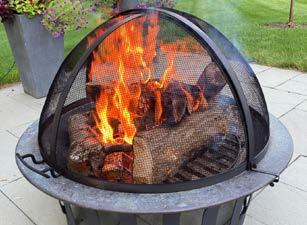
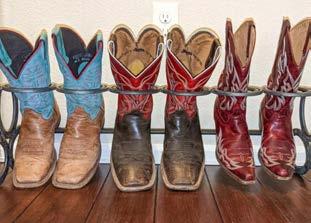
Nothing brings people together like the warm glow of a fire pit, and you can create a custom fire pit that will be the centerpiece of backyard gatherings. Using our versatile welders, you can easily join metal sheets to form the base and sides of the pit. Our machines ensure strong, clean welds that will withstand the heat and weather, providing a durable and safe fire pit for years to come.
Uses: Perfect for outdoor entertainment, roasting marshmallows and adding ambiance to any garden or patio.
3. Firewood Rack
A firewood rack is essential for keeping wood neatly stacked and dry, and you can build a customized rack that fits your specific space and needs. Our welders provide precise control, allowing you to create a sturdy frame that will hold a substantial amount of firewood.
Uses: Keeps firewood organized and off the ground and is ideal for use near a fire pit, fireplace or wood stove.
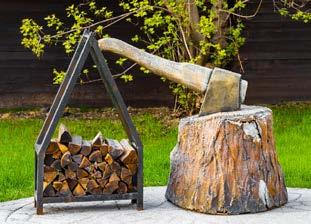
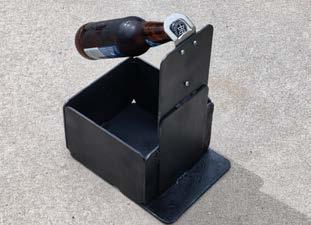
4. Horseshoe Boot Rack
Turn old horseshoes into a unique and functional boot rack. Forney welders make it simple to fuse horseshoes together into a design that not only holds boots but also adds a rustic charm to any entryway. The durability of our welders ensures that your boot rack will be strong enough to support multiple pairs of boots.
Uses: Keeps your entryway organized while adding a touch of rustic style. It’s perfect for homes, barns or workshops.
5. Bottle-Cap Opener
Craft a stylish bottle-cap opener that doubles as a piece of art. Whether you prefer a wall-mounted or handheld design, Forney welders make it easy to achieve smooth, clean welds for a polished finish. Impress your guests with a custom opener that showcases your craftsmanship and creativity.
Uses: Perfect for opening bottles with ease. The opener adds a unique touch to kitchens, bars or outdoor entertaining areas.
Join the race with the Losi NASCAR RC Race Car! This ready-torun, hobby-grade RC stock car offers speed and realism you won’t believe. Drive it. Tune it. Race it. Add option parts and make it yours. Choose your favorite livery and build your own NASCAR legend.
Why wait for the weekend? With the Losi NASCAR RC Race Car, you can put yourself in the driver’s seat and enjoy NASCAR action anytime — in your driveway, in a parking lot, or at your local park. Bring NASCAR racing with you almost anywhere!
The Losi NASCAR RC Race Car isn’t like the toy remote control models you had as a kid. Hobbyquality RC is much more realistic, durable, and powerful, with sophisticated engineering derived from real vehicles that will last for years. If anything breaks, you can fix it. Help, encouragement, and replacement parts are available online or at your local RC hobby retailer if needed. You’ll find performance-boosting upgrades there, too. Adjust camber, adjust the differentials, change the shock package, and more. Grow and learn technical skills to give the Losi NASCAR RC Race Car the optimum handling for whatever surface you race on.
Charging up the LiPo battery takes less than an hour — the perfect time for you to look over the manual. Then you’re ready to go!
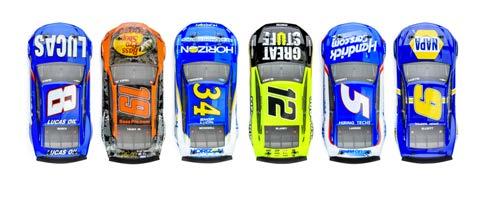

Any flat surface of around 20 x 40 feet with medium or high traction can be your speedway. Concrete, asphalt, and prepared or painted park courts for tennis and basketball work great. Set up an oval or road course with a few cones to recreate your favorite NASCAR track and race like the pros! With its composite chassis, metalgeared powertrain, independent suspen sion, and oil-filled, coil-over shocks, the Losi NASCAR RC Race Car offers versatile AWD on-road performance that even experienced RC enthusiasts will admire.
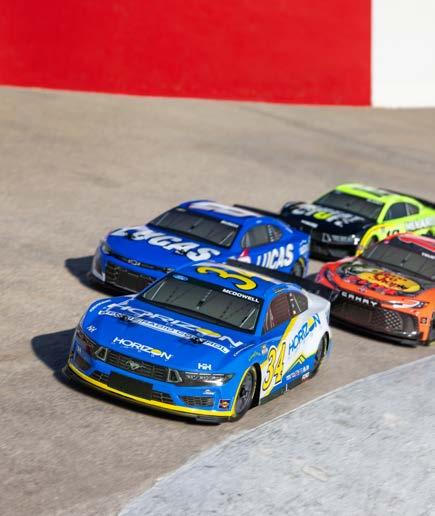
Straight out of the box, the Losi NASCAR RC Race Car is fully assembled and finished. No additional items are needed. It’s equipped with top-quality components from the leading RC hobby brands. Even AA transmitter batteries are included.
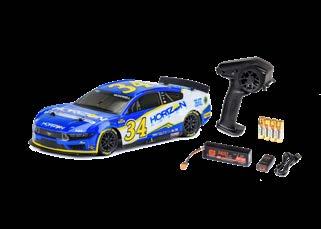
The Losi NASCAR RC Race Car is an easy way for all NASCAR-loving friends and families to have racing fun together. No prior RC hobby experience is required. Show your loyalty to your NASCAR favorites — officially licensed liveries of top current teams and drivers are available, as well as clear bodies for recreating the scheme of your favorite driver. Get the Losi NASCAR RC Race Car and get in the race! Visit losi.com/nascar/ to learn more
The Losi NASCAR RC Race Car comes completely assembled and finished. Everything you need is included in the box — even AA batteries for the transmitter. Read through the manual while you charge the LiPo battery for the first time. In less than an hour, you’ll be ready to start racing!

On a full charge, the included Spektrum Smart 2S LiPo battery provides 20 minutes of uninterrupted run time. When it’s time to recharge, just plug the supplied charger into any convenient USB or USBC power source. It’s simple, safe, and gets you back on the track fast.

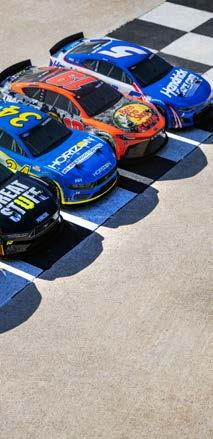
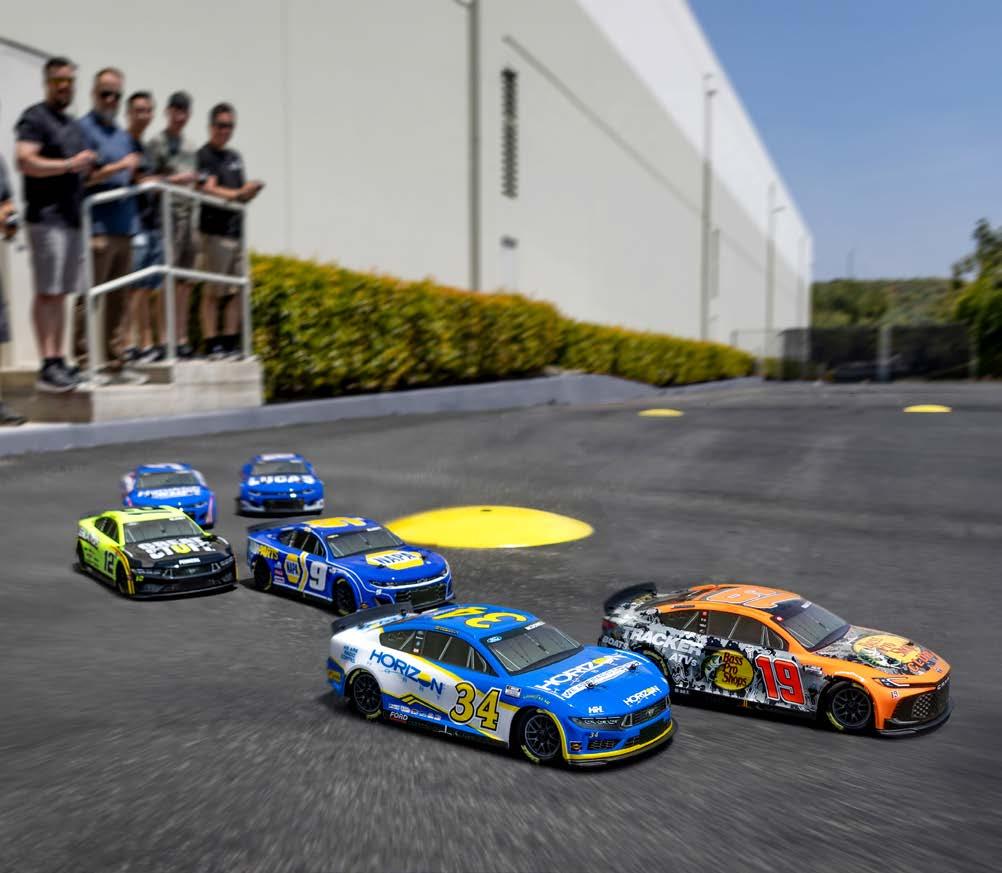







EFFICIENT POWERTRAIN FOR 20+ MPH SPEEDS
The Losi NASCAR RC Race Car’s factoryinstalled powertrain features a powerful 28-turn brushed motor paired with a 25 amp electronic speed controller. An included 25mm electric fan ensures a long life of maximum performance by keeping the motor cool while you race at 20+ mph top speeds.
Unlike remote control toys, the hobbyquality Losi NASCAR RC Race Car is designed and built to withstand season after season of racing. The front splitter, rear diffuser, and nerf bars effectively shield all critical components from impacts with other racers.
The Losi NASCAR RC Race Car is fully customizable. Optional clear bodies are available that you can finish however you wish for a look that’s all your own. You can upgrade the shocks, camber links, tires, and more to give your car tuning capabilities like a real NASCAR Cup car.

BY CODY WILLIAMS
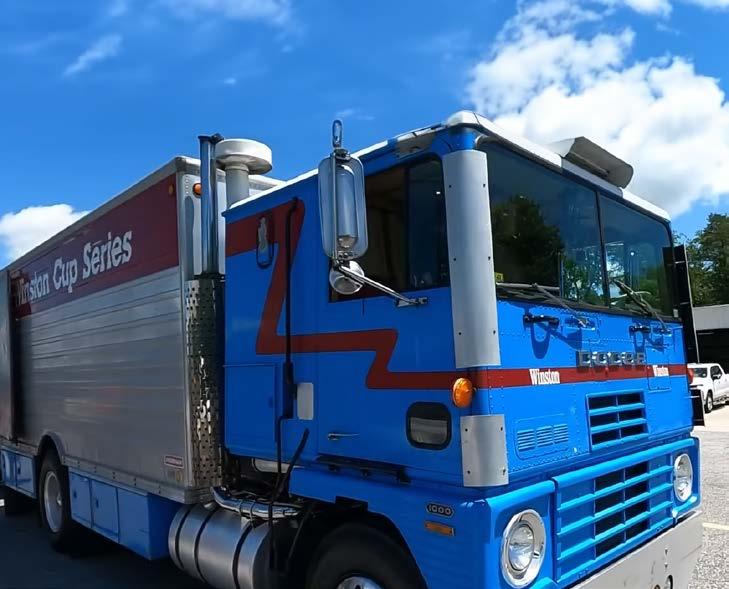
Team haulers have evolved into state-of-the-art, mobile race shops and their arrival at the various tracks on the NASCAR schedule are often celebrated with a choregraphed Hauler Parade. These parades are a spectacle for many race fans, indicating NASCAR has arrived in town and the race weekend is about to begin.
In the beginning, haulers were considered optional and many team owners believed they were an expensive luxury. So how did NASCAR haulers get their start, and who was the mastermind behind them? Let’s review the rich history of haulers and their place in the sport.
When the NASCAR Cup Series was founded in 1949, using trailers to transport race cars to and from the track was rarely an option. This is largely because NASCAR race cars back then were street cars with numbers (and sometimes sponsors) painted on the sides. Many of the cars were driven to and from the races.
Even in NASCAR’s earliest days, competitors in what is now the Whelen Modified Series drove their souped-up hot rods to the track, regardless of their alterations.
As NASCAR grew in popularity and expanded nationwide, driving race cars to and from the tracks became impractical. For one thing, all that travel racked up miles on the car’s engine and parts. In addition, races were run as far north as Pennsylvania and New Jersey, while most teams were based in or around Charlotte, North Carolina, or Spartanburg, South Carolina.
Another issue early teams encountered was damaged race cars. If a car was driven to a track and it was crashed and could not be driven, it either had to be abandoned or a towing service had to be hired.
A fix was needed, and one of NASCAR’s top teams ushered in the concept of using trailers to transport their cars to and from the scheduled events.
When drivers and teams decided that driving race cars to and from the track was no longer feasible, they started looking into alternative methods of transporting their cars. Initially, this meant hooking a flatbed trailer onto the back of a pickup truck and hitting the road.
Eventually, towing the race car on a trailer evolved into a box truck and trailertype rig. A designated truck driver would wheel a big box truck (think modern-day U-Hauls) with a trailer attached to the back that carried the race car. Petty Enterprises was among the first teams to transition to this means of transportation.
These trucks were completely modern and innovative for the time. They included a fan for cooling, two-way radio for communication and even a bed for the truck driver to sleep if he was traveling cross country.
The “box” part of the truck was filled with the various supplies a team might need on any race weekend. The inventory included spare parts and pieces, toolboxes and pit stall supplies.
Richard Petty and his family’s business, Petty Enterprises, were largely responsible for steering these innovations. He believed that if a car were driven less on the street, it would hold up better on the track during grueling race weekends.
After that, NASCAR haulers morphed into something more convenient and comfortable. But that’s not where the story of NASCAR haulers and their evolution ends.

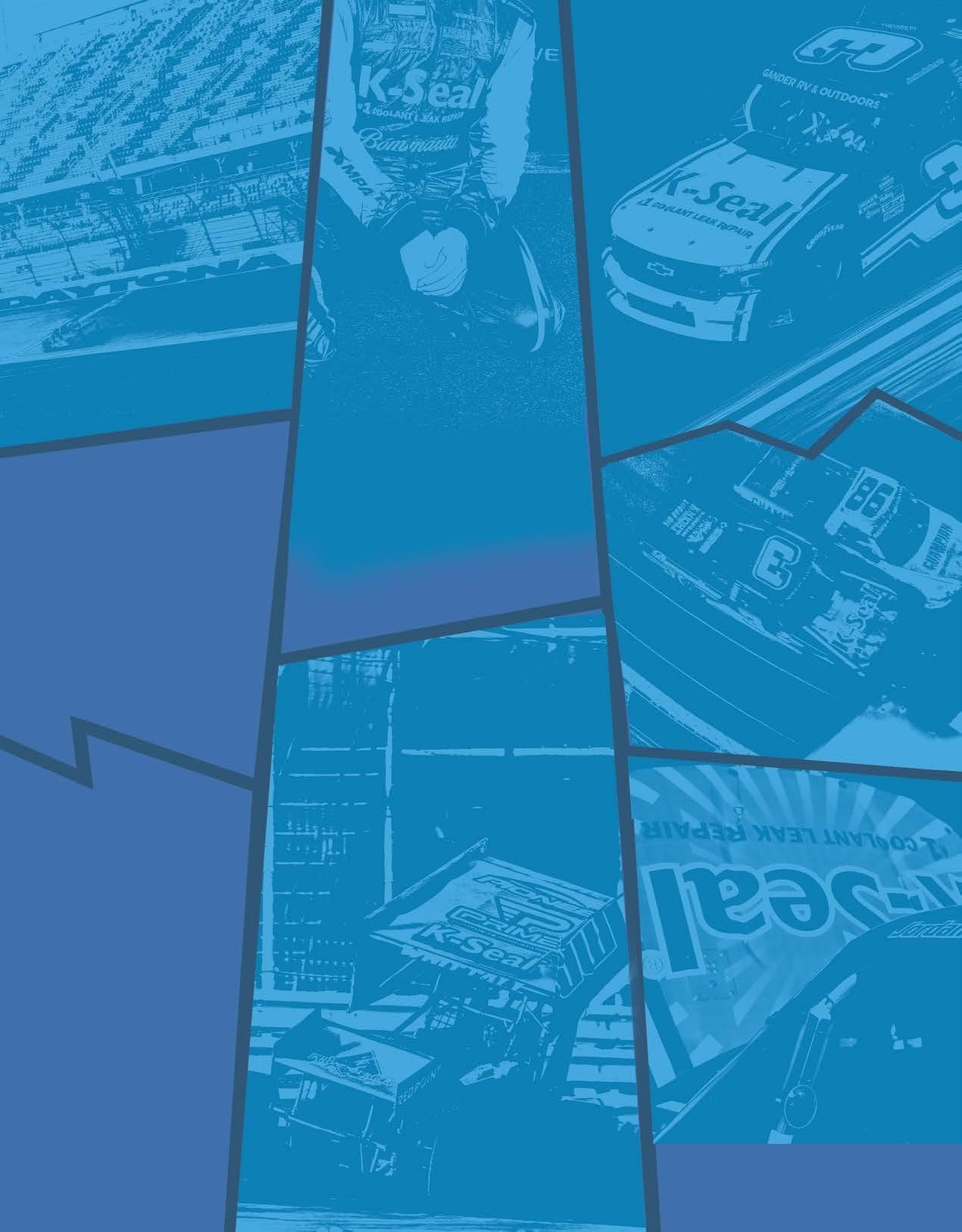
Permanently Fix Leaks in the:
• Radiator
• Water Pump Casing
• Heater Core
• Freeze Plug
• Block / Head
• Head Gasket
Also Seals Cracked Heads & Cracked Porous Blocks








• Can be added to a hot or cold engine*
• NOT liquid glass / sodium silicate
• Can be added to the overflow tank
• Safe for use in all water cooled engines
• Mixes with all types of antifreeze
NASCAR Hall of Famer Bud Moore was certainly an innovator, not only as a racer himself and team owner on the competition side, but also in terms of the practicality of NASCAR haulers.
Moore was the first team owner to bring a fully enclosed and converted trailer to the race track. It started when he showed up at Daytona International Speedway in February 1982. With his design, Moore had produced a blueprint for the future.
One of the key features of his hauler was a fully enclosed trailer. This protected the car from damage it could suffer en route to the race track, such as that caused by weather or other unforeseen incidents.
In his hauler, Moore had everything needed for a race weekend, from spare parts to a backup car if the primary was damaged during practice or qualifying. He took the innovations of Petty Enterprises and moved his whole operation, including the car, in-house, so to speak.
Once other team owners got a whiff of what Moore was doing with his hauler, they all moved in that direction. It was yet another stepping stone to what the modern NASCAR hauler would become.



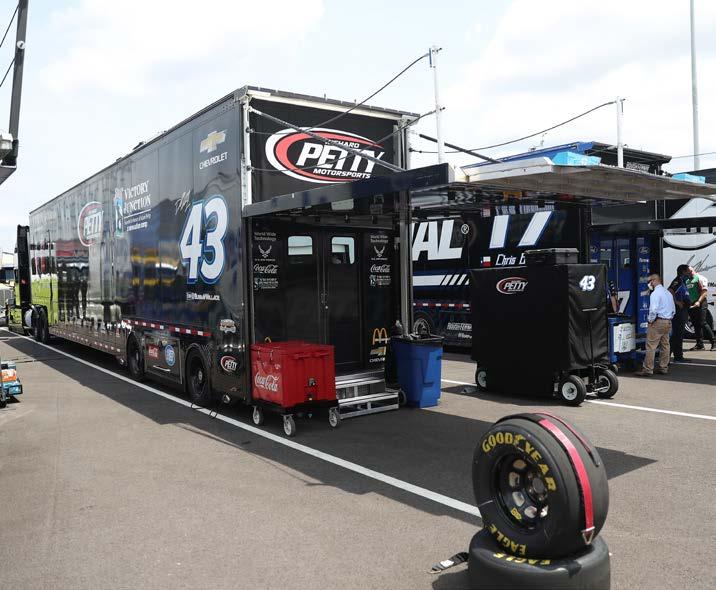
By 1991, Richard Childress, owner of the No. 3 GM Goodwrench car driven by Dale Earnhardt, was looking to push the envelope regarding what a NASCAR hauler could and should be.
Childress wanted to create a garage on wheels – a big, enclosed trailer towed by a semi-tractor. To achieve this, Childress approached Featherlite Trailers to make his vision a reality. Featherlite eventually became the official trailer manufacturer of NASCAR and is still the choice hauler for many NASCAR teams.
Childress envisioned a trailer to haul two cars and all the extra parts and engines needed for a race weekend. But pushing things farther, he also wanted his hauler to have features such as a command center, diagnostic center and an observation deck.
Many modern NASCAR haulers also have something of an employee lounge. To achieve these innovations, Featherlite created a double-decker of a NASCAR hauler. The top deck was where the primary and backup cars were stored, while the bottom deck was essentially the command center.
What Childress and Featherlite created is now the typical NASCAR hauler, with a few variations from team to team.
Its origins are often debated, but the NASCAR Hauler Parade is a relatively new concept that has become fairly common at tracks across the country.
Team haulers stage at a designated time and location and then parade through the streets en route to the race track. Fans line the route and the truck drivers honk their horns in appreciation for the fans’ support. The hauler parades have become so popular that tracks now live stream them.
Though NASCAR haulers are commonplace today, they’ve literally traveled a long and winding road. The sport has gone from racers driving their cars to the track, to flatbed trailers, box trucks and fully enclosed tractor-trailers, to the immaculate rigs used today.
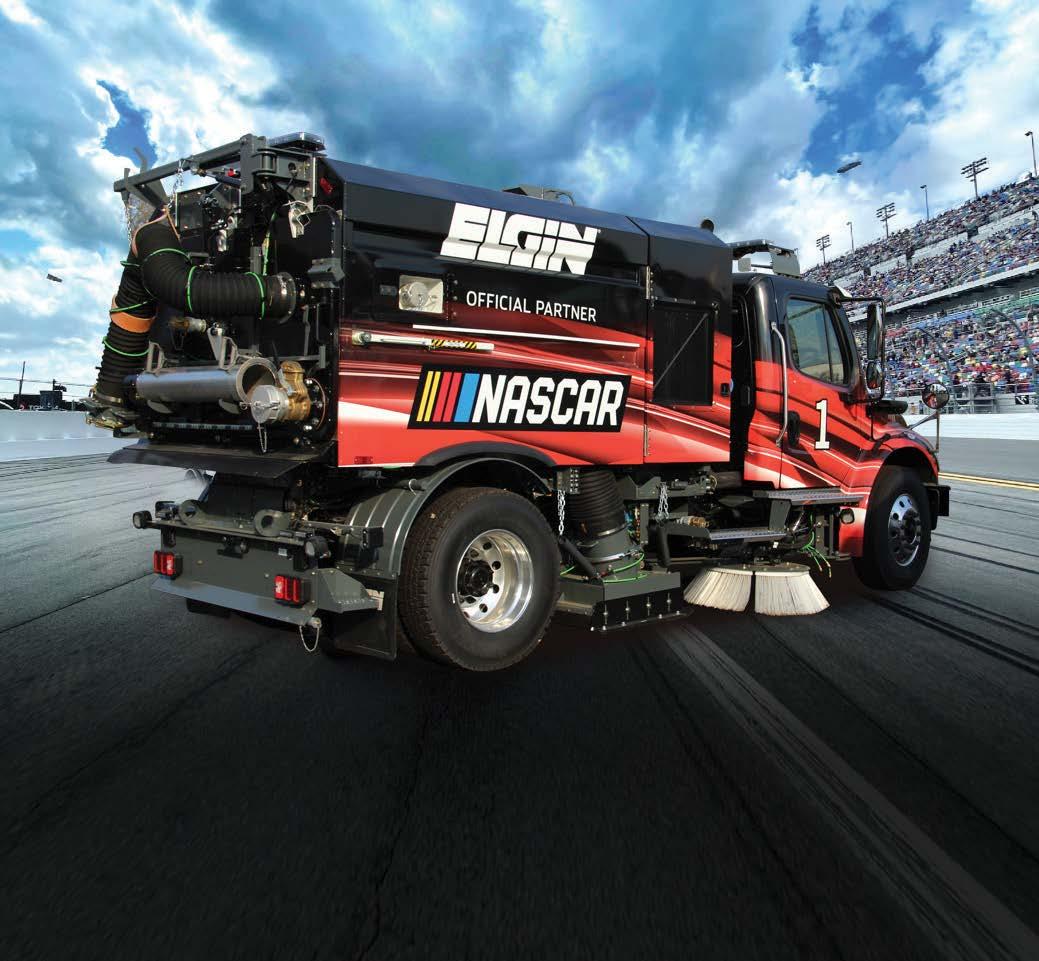

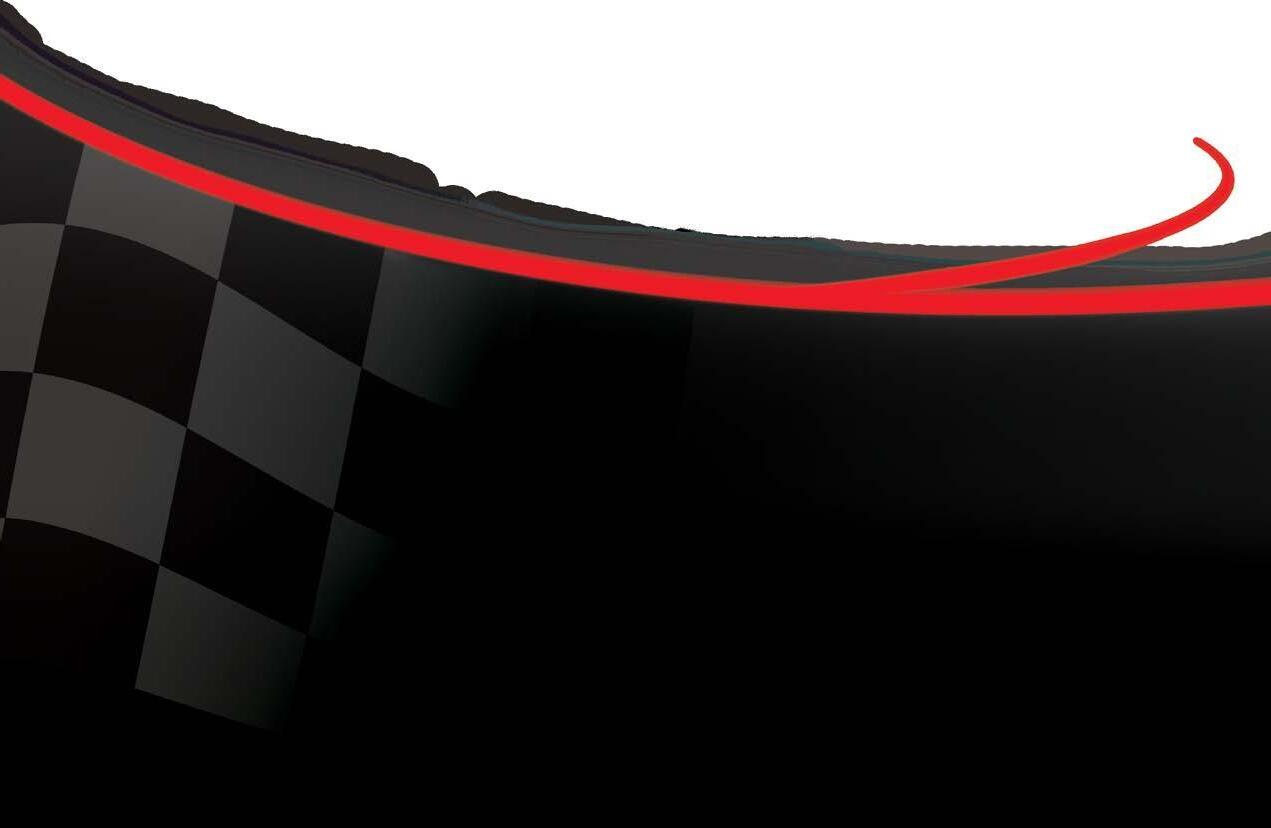
Whether sweeping some of the most well known race tracks in America or cleaning the streets in your neighborhood – Elgin sweepers have a reputation for performance, reliability, durability. With over 100 years of experience, a full line of sweepers for every application, and industry-leading green technology –Elgin can always be trusted to get the job done, and take care of the environment along the way.
Scan to learn more about Elgin’s trusted performance – or tune into any NASCAR® - sanctioned race to witness it for yourself.
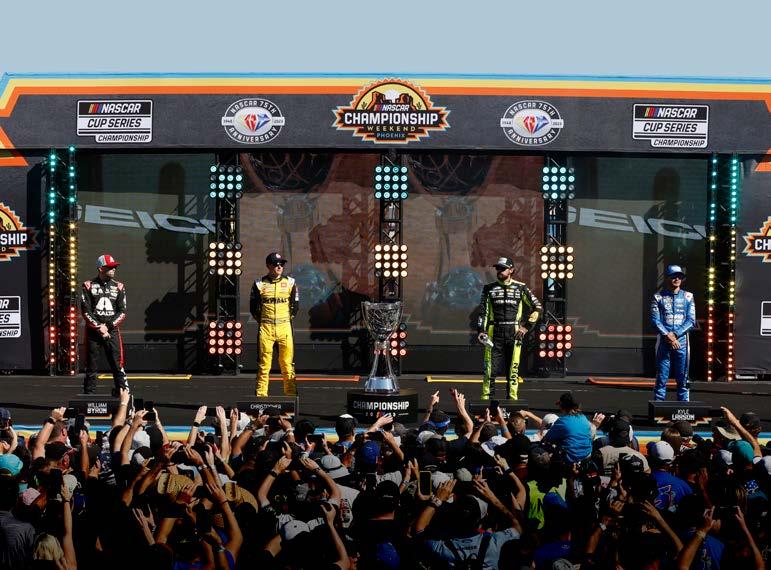
BY JARED TURNER
Simply put, the NASCAR Cup Series playoffs are a contest among 16 drivers over 10 races for the sport’s biggest prize.
In reality, though, it’s a bit more complicated.
Before delving into how the playoffs work in terms of format, it’s important to first understand how the playoff field is set.
In short: Any driver who wins during the 26-race regular season and starts every race is guaranteed entry into the playoffs. If there aren’t 16 different race winners in the regular season, the rest of the playoff field will consist of the drivers who have the highest point totals but lack a victory.
Since 2017, the year NASCAR introduced stage racing to its premier series, the winner of each regular season race has collected five “playoff points” in addition to a single playoff point for any stage they win. Since most races consist of three stages, a driver can capture up to seven playoff points each time out – one for winning each of the first two stages, and five for winning the race.
So, if a driver went to Victory Lane four times and collected five stage wins in the regular season, they would accumulate 25 playoff points. Those points would then be added to a newly reset preplayoff baseline point total of 2,000 (The baseline point is the same for each of the 16 title contenders entering the playoffs.).
That means the driver with the most playoff points at the end of the regular season will start the playoffs atop the standings, followed by the driver with the next highest number of playoff points, and so on.
There’s a caveat, however: Along with earning playoff points for regular season race wins and stage wins, the driver atop the standings at the end of the regular season will carry an extra 15 playoff points into the playoffs.
The second-place driver in the standings at the end of the regular season will take 10 extra playoff points into the playoffs, with thirdplace carrying eight playoff points, fourth-place carrying seven, etc., all the way down to the driver finishing 10th in the regular season standings who receives one additional playoff point.
It’s important to understand, too, that drivers can earn two types of points during a season. Unlike playoff points, which only some drivers manage to collect, all drivers amass “race points” for where
they finish a race, and some earn additional “race points” – sometimes known as “stage points” – for where they finish the stages leading up to the final stage.
In races with three stages, a driver can finish the day with a maximum of 60 race points – 40 for the race win and 10 for winning each of the first two stages.
Race points are awarded to the top-10 finishers in each of the first two stages on a descending 10-1 scale. Meanwhile, the second-place finisher at day’s end gets 35 race points, with third-place collecting 34, fourth-place being awarded 33, etc., all the way down to the 36th through 40th-place finishers who each claim one race point.
The driver with the most race points after 26 events is the one who sits atop the standings, and they’re designated the “regular season champion.” This driver reaps the benefit of the extra 15 playoff points that come along with this accomplishment.
Now for how the actual playoffs, which commence in early September, will work.
The playoffs consist of four rounds, including a trio of threerace elimination rounds from which a total of 12 drivers fall out of championship contention.
The opening round, known as the Round of 16, features all 16 playoff drivers, four of whom are formally eliminated from title contention in the third and final race of the round.
From there, the playoffs move to the Round of 12 where four more drivers are eliminated in the final race of the round, followed by the Round of 8 where another four see their title hopes go by the wayside.
That leaves a quartet of drivers – formally known as the Championship 4 – to battle for the title in the final race. The highest-running championship contender at the checkered flag is the champion no matter how they perform throughout the race. In other words, where they finish in the first two stages doesn’t matter.
A win by any championship-eligible driver in any of the first three rounds automatically punches that driver’s ticket to the next round. However, most of the drivers who advance to the Round of 12 and the Round of 8 will do so based on their point total at the end of the previous round. It’s possible, however, that only one driver will reach the Championship 4 on the basis of their point total when the Round of 8 concludes.
Playoff points continue to be awarded during the playoffs and transfer from one round to the next, with the lone exception being the championship round where the four drivers will enter the final race on equal points footing.
So, for example, if a driver heading into the Round of 8 has claimed 40 playoff points since the start of the season, he’ll get to start that round with all 40 playoff points. They’ll be added to a new baseline point total that’s reset to the same number for all remaining title contenders at the beginning of each round.
Those playoff points could really come in handy if the driver fails to win a race during the Round of 8 and needs the points to reach the Championship 4.
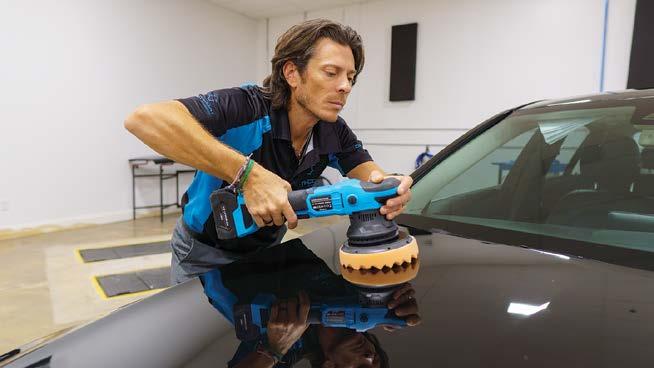








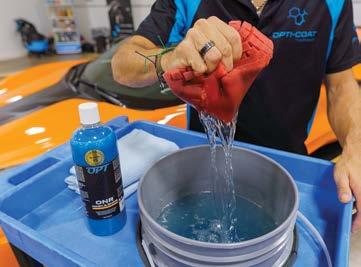





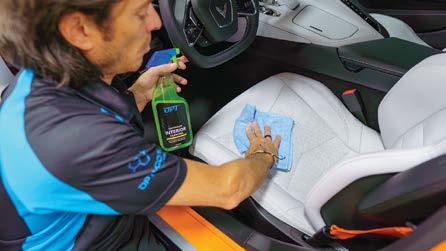



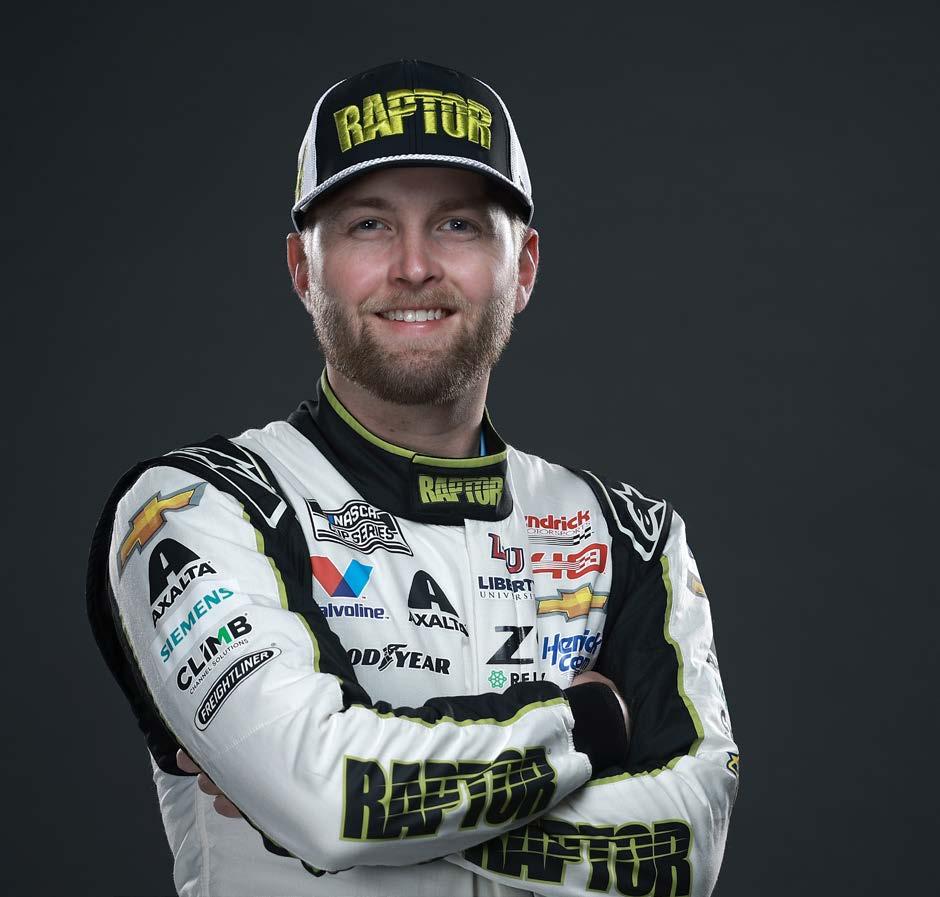

BY JARED TURNER
Who will win this year’s NASCAR Cup Series championship?
Here’s a breakdown of the drivers with the best shot, an outside shot and virtually no shot despite being good enough to make the playoffs.
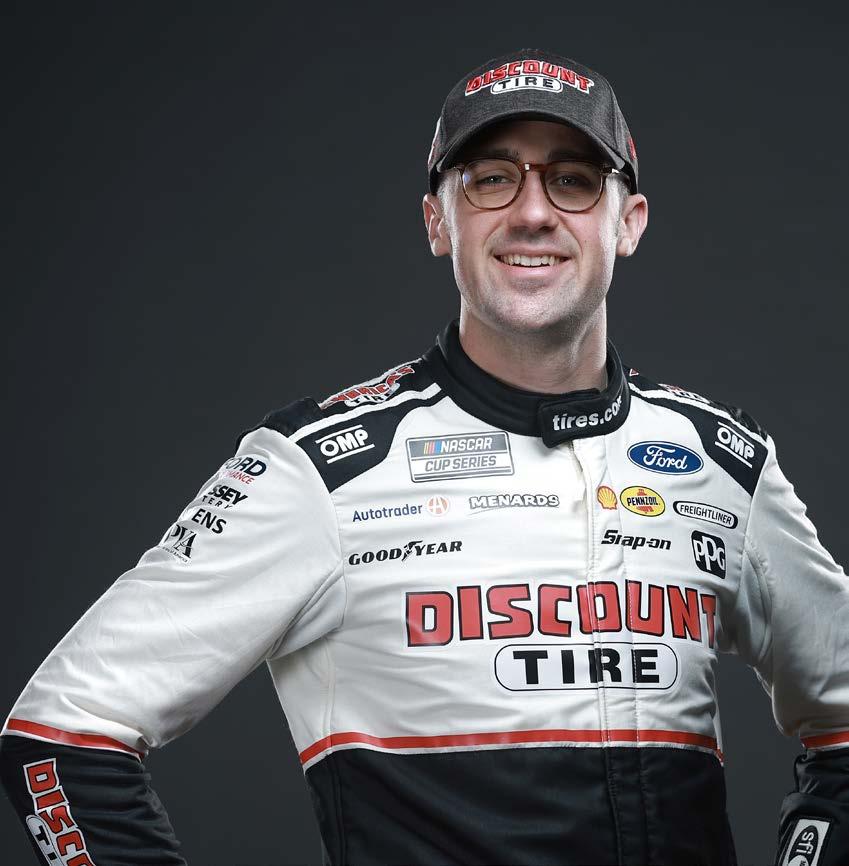

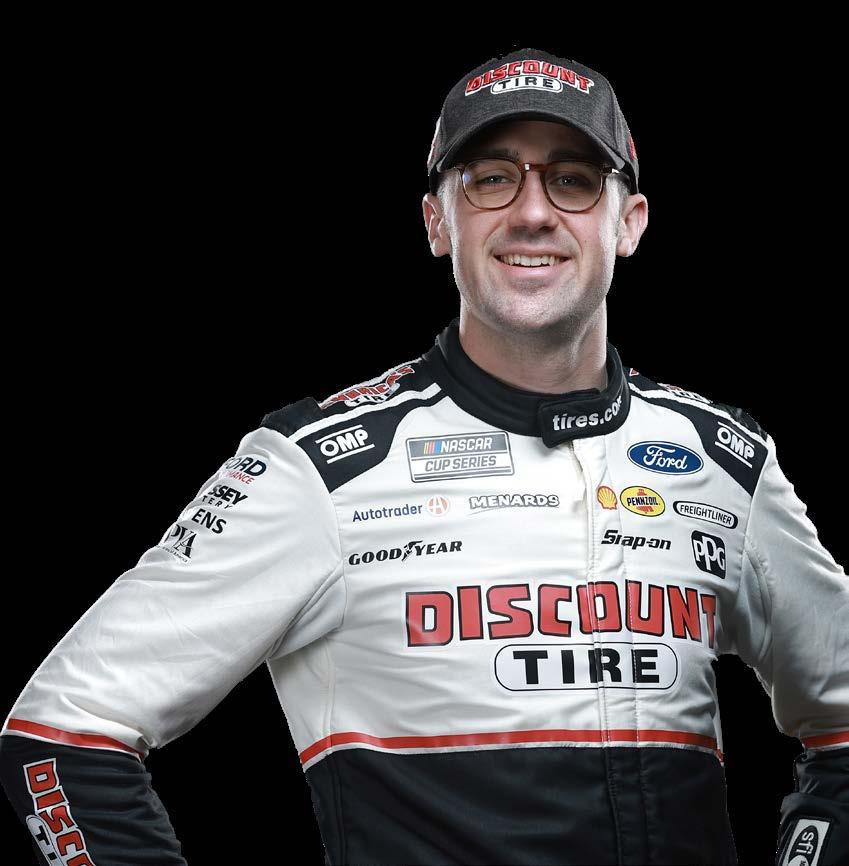
William Byron: Byron opened the season with a bang by winning the Daytona 500 and added victories at Circuit of The Americas and Martinsville before the year’s midway point. After making the Championship 4 for the first time in 2023 on the strength of a career-high six wins, he might be the odds-on favorite to claim the title this time around.
Kyle Larson: Even though he missed the Coca-Cola 600 in order to finish the rain-delayed Indianapolis 500, Larson spent virtually the entire Cup Series regular season at or near the top of the standings. If the Hendrick Motorsports driver and 2021 Cup Series champion bags his second championship trophy this year, no one will be surprised.
Denny Hamlin: Arguably NASCAR’s greatest driver to never win a Cup Series title, Hamlin looks to at long last claim the honor that has narrowly eluded him on multiple occasions. The four-time Championship 4 qualifier and three-time Daytona 500 winner went to Victory Lane three times in the season’s first half. Will this finally be his year?
Christopher Bell: After reaching the Championship 4 each of the last two seasons, Bell is no longer a championship darkhorse. In fact, no one will be shocked if the Joe Gibbs Racing driver makes it back to Phoenix for a third consecutive year after collecting a trio of trophies in the first half of the schedule.
Joey Logano: One of only two active Cup Series drivers with multiple championships, Logano is in the title hunt virtually every year, and this year is no exception. The Team Penske driver formally earned a playoff berth with a win at Nashville in June after an absence from Victory Lane that stretched well over a year. Still, Logano can’t be written off this season – or ever.
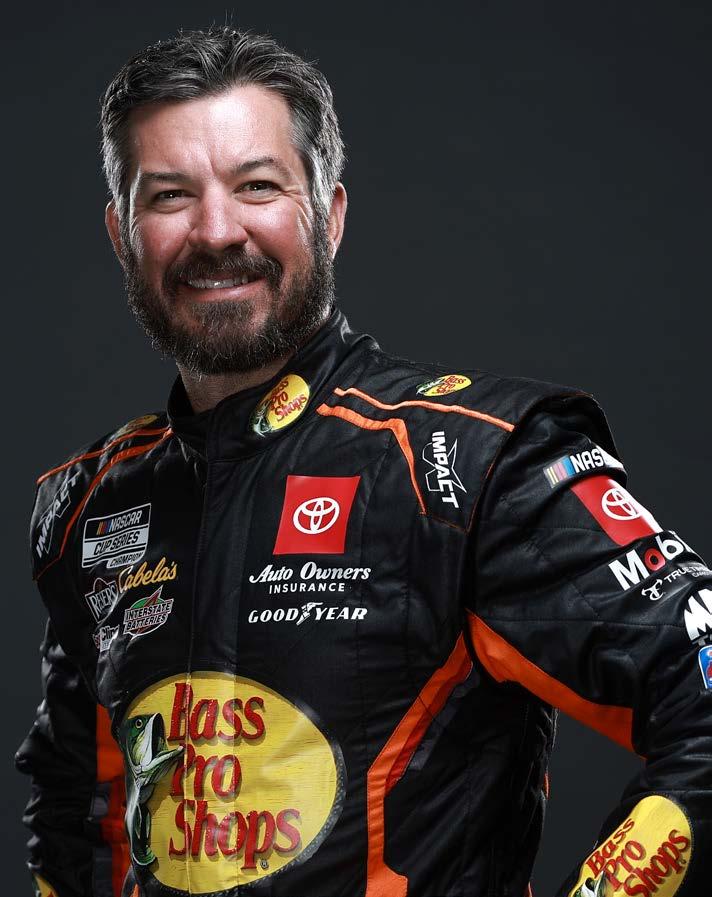
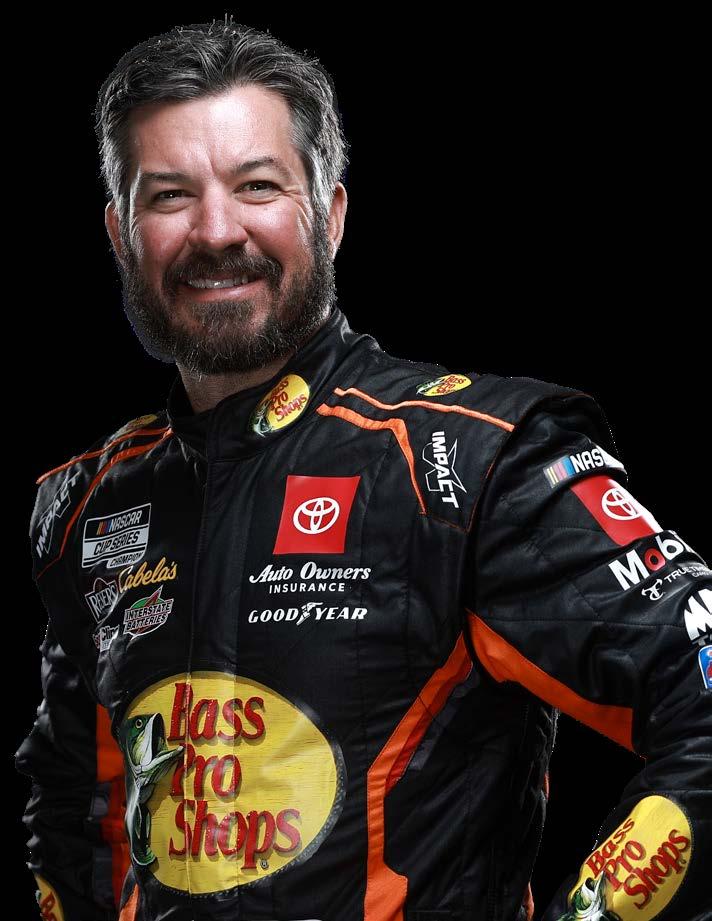
Ryan Blaney: On the heels of winning a championship last season that few expected, Blaney hopes to become the first Cup Series driver since Jimmie Johnson in 2009 and 2010 to go back-to-back. While that’s statistically unlikely, the Team Penske driver has the potential to make it happen if all the stars align perfectly.
Chase Elliott: After missing the playoffs for the first time in his career last season, Elliott wasted little time securing a playoff berth for 2024 when he prevailed in week nine at Texas. NASCAR’s perennial most popular driver, who snared his first and only Cup Series title to date in 2020, hasn’t been as strong this season as two of his Hendrick Motorsports teammates, but to overlook him as a title favorite would be a mistake.
Martin Truex Jr.: In his final full season as a NASCAR Cup Series driver, Truex would love nothing more than to go out as a champion – and most of the NASCAR world wouldn’t mind seeing that happen either. It would be a storybook ending to a stellar career for the Joe Gibbs Racing driver, whose lone championship came in 2017 when he was with Furniture Row Racing.
Chris Buescher: After a breakout 2023 season during which he posted three wins, Buescher has suffered a few heartbreaking losses this year. Perhaps, he’ll end up on the right end of some close battles come playoff time, when he’ll be a driver worth keeping an eye on due to how fast his RFK Racing Fords have been at times this year.
Brad Keselowski: Keselowski ended a lengthy absence from Victory Lane when he won at Darlington in May and punched his playoff ticket in the process. Whether Keselowski, who turned 40 in February, has what it takes to wage a fight for his second Cup Series championship is questionable, but the 2012 champ deserves to be in the discussion.
Tyler Reddick: Reddick sealed a playoff berth fairly early in the year with a win at Talladega and has been in contention to go to Victory Lane on several other occasions. If Reddick gets hot at the right time, he has the potential to be a championship spoiler.
Ross Chastain: Chastain proved with his video-game style move in the Round of 8 elimination race at Martinsville in 2022 that he’ll do just about anything to put himself in position to contend for a championship. Chastain hasn’t made a lot of positive headlines since that maneuver for the ages, but his aggressive style makes him a driver who can never be totally counted out.
Daniel Suarez: Suarez gave NASCAR fans everywhere a thrill when he nipped Ryan Blaney by less than a nose at the finish line at Atlanta in February to punch his ticket into the playoffs. The margin of victory – .003 seconds – was the narrowest in NASCAR history, but Suarez hasn’t done anything since then to suggest he’ll make any real noise in the post-season.
Austin Cindric: Arguably the most surprising race winner of the year, Cindric seemingly came out of nowhere to take the checkered flag at World Wide Technology Raceway in June after the two other frontrunners found trouble late. Cindric, whose only other Cup Series victory to date came in the 2022 Daytona 500, hasn’t flexed enough muscle outside of Gateway to be considered anything more than a championship afterthought.
Ty Gibbs: The grandson of team owner Joe Gibbs has taken a notable leap from year one to year two as a full-time driver in NASCAR’s top series. Thanks to much improved consistency, Gibbs is all but locked into the playoffs after barely missing the post-season as a rookie. Don’t expect Gibbs to mount much of a championship run, however, since he was still searching for his first career Cup Series win just past the season’s midway point.
Alex Bowman: Bowman failed to make the playoffs a season ago primarily due to injuries he suffered in an extracurricular racing event during the regular season. The previous year, Bowman was injured during the playoffs and eliminated from championship contention with his involvement in a crash that forced him to sit out several races. So, after winning at Chicago, qualifying for the playoffs, and remaining healthy, Bowman should consider the season a success.
BY JARED TURNER
Since NASCAR introduced a playoff for its premier series in 2004, much has changed about the playoff format. What hasn’t changed is the number of races – 10.
Here are the 10 tracks on tap for this year’s edition of the playoffs, with a little insight into what might go down at each:
Gone are the days when AMS was just another 1.5-mile track. Since speedway officials paved the track, added banking and narrowed its racing groove ahead of the 2022 season, AMS has raced more like a superspeedway than the standard intermediate. As a consequence, the events at AMS have become some of the most exciting and unpredictable on the Cup Series tour.
Back in February, AMS produced the closest finish in NASCAR history when Daniel Suarez nipped Ryan Blaney by .003 seconds in a three-wide battle with Kyle Busch at the checkered flag. With Atlanta being the opening race of the playoffs for the first time, there’s no telling what could happen – and how it could impact the two remaining races in the Round of 16.
A newcomer to the playoffs, Watkins Glen is sandwiched right in the middle of the opening playoff round and will provide a golden opportunity for one of the Cup Series’ road course aces to punch a ticket to the Round of 12. Of the road courses on the Cup schedule, the 2.45-mile, 7-turn layout in the Finger Lakes region of central New York has been around the longest and arguably provides the most entertaining racing on a consistent basis.
Among those not shedding any tears about WGI’s new playoff date are Hendrick Motorsports teammates Chase Elliott, Kyle Larson and William Byron, who’ve combined to capture the last five races at the track, with Elliott and Larson winning twice and Byron going to Victory Lane most recently in August 2023.
One of the most popular events on the Cup Series calendar for many decades, the Bristol Night Race has long been known for fireworks both on and off the track. With Bristol returning this year as the first elimination race of the playoffs, expect no shortage of drama and aggression at the high-banked .533-mile short track.
Denny Hamlin has triumphed in each of the last two races run on the Bristol concrete and will be aiming to threepeat this fall. His closest challenger could be Chris Buescher, who played the role of playoff spoiler with a surprising win at Bristol in the fall of 2022.
Since NASCAR made the switch to the Next Gen Cup Series car ahead of the 2022 season, the racing at Kansas Speedway – like a number of intermediate tracks – has grown exponentially better. As the first race in the Round of 12, Kansas could set the tone for not only what happens in this round but who makes a deep playoff run.
With two victories, Kyle Larson is the only repeat winner in the last eight Cup Series races at the 1.5-mile track. The Hendrick Motorsports driver is also the most recent driver to visit Kansas’ Victory Lane, having made it there in May.
Long known as the “wild card” of the 10 playoff races, Talladega always lives up to the billing with its brand of high-speed, close-quarters, three-, four- and sometimes even five-wide racing in one or two big packs of cars.
With that style or racing, of course, comes a high probably of “The Big One,” which is the moniker ascribed to the major multi-car crashes that so frequently result from drivers being bunched closely together in the draft for nearly three hours.

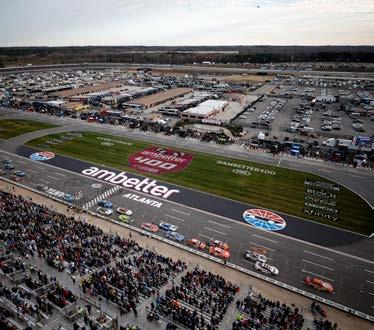

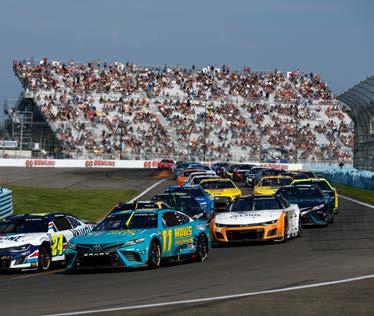



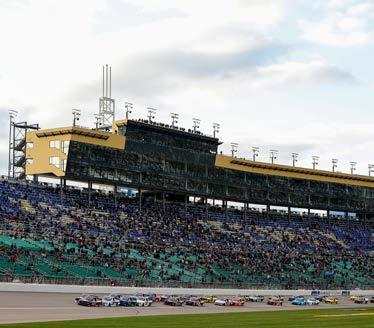

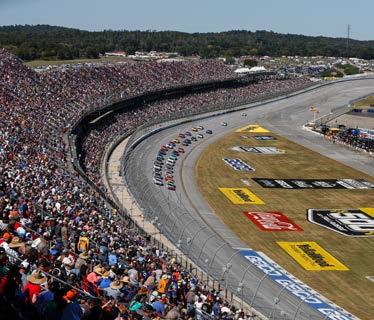

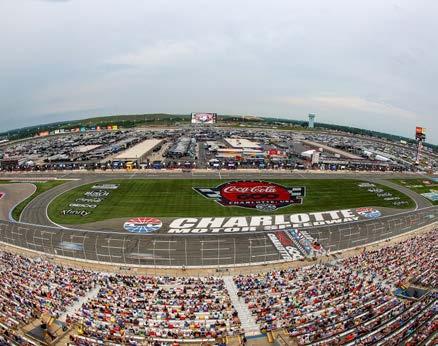
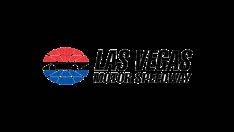
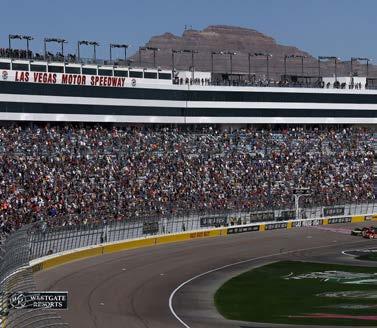

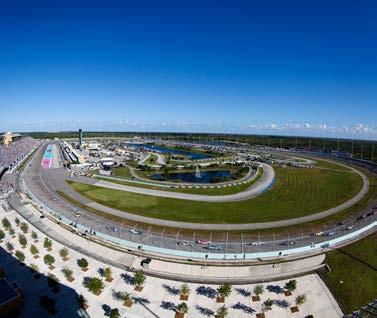

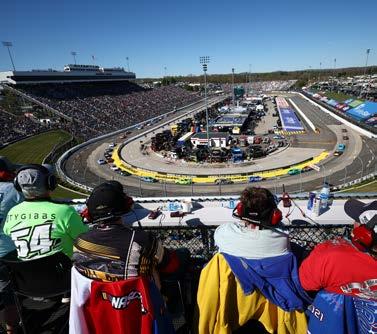

While it’s truly anyone’s guess who will come out on top at Talladega, history paints a rosy outlook for Brad Keselowski, who leads all active Cup Series drivers with six trophies from the 2.66-mile Alabama tri-oval. Ryan Blaney and Chase Elliott aren’t half bad here either, both having scored multiple Talladega victories since 2019.
As the Round of 12 elimination race the past several years, the Charlotte Motor Speedway ROVAL has been prone to produce some rather electrifying and even controversial outcomes.
An infield road course that also includes portions of the familiar Charlotte Motor Speedway quad-oval, the ROVAL will offer a new challenge this season as portions of the 2.28-mile circuit track have been reconfigured in an attempt to provide additional passing opportunities.
Chase Elliott is the only multi-race winner since the Cup Series made its ROVAL debut in 2018.
They say that “what happens in Vegas stays in Vegas,” but that’s not exactly true where the NASCAR Cup Series playoffs are concerned. That’s because, as host to Race No. 1 of three in the Round of 8, Las Vegas Motor Speedway often plays a pivotal role in determining the four drivers that ultimately advance out of the Round of 8 and compete for a championship in the season’s final race.
If that pattern holds this fall, it’s likely good news for Kyle Larson, who’s won the last two races at the 1.5-mile track and three of the last seven.
The last eight races at Homestead have produced eight different winners, so it’s hard to predict who’ll leave South Florida this time with a big trophy. Prior to 2020, Homestead was host of the season-ending Championship 4 race, and the 1.5-mile track has since bounced around the schedule.
If the most recent Homestead outing – held the same weekend in 2023 – matters, look for Christopher Bell to be a strong contender since he’s the defending race winner.
Host of the penultimate race on the Cup Series schedule and the Round of 8 elimination event since 2020, Martinsville has been the site of many incredible moments over its 75-plusyear history.
The .526-mile paperclip-shaped short track has been a bit calmer overall since the rollout of the Next Generation Cup Series car in 2022, but with a berth in the Championship 4 on the line, the unthinkable can still happen – as Ross Chastain proved in the fall of ’22 with his last-lap bonsai move that propelled him into the Championship 4 just when all hope seemed lost.
Although Chastain’s daring maneuver, where he never lifted in Turns 3 and 4, has since been banned, drivers are still prone to go for broke when it could be the difference between qualifying for the Championship 4 and being eliminated from title contention. One driver who might not need to go for broke to get the Martinsville finish he needs is William Byron, a twotime winner in the last five races here.
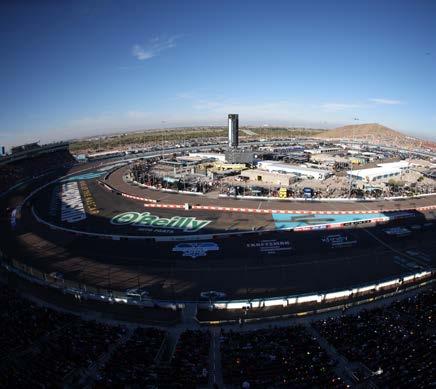
For the fifth year in a row, Phoenix Raceway is the site of the Cup Series season finale where four drivers will compete straight up for the title. Last year, for the first time since NASCAR created a Championship 4 race for its top series in 2014, the champion did not win the event but finished second.
That driver, Ryan Blaney, has actually come home second in the last two fall races at the 1-mile Arizona track, where Joey Logano (2022) and Ross Chastain (2023) took the checkered flag.
The two most recent springtime races at Phoenix have belonged to William Byron and Christopher Bell, respectively.
BY JARED TURNER
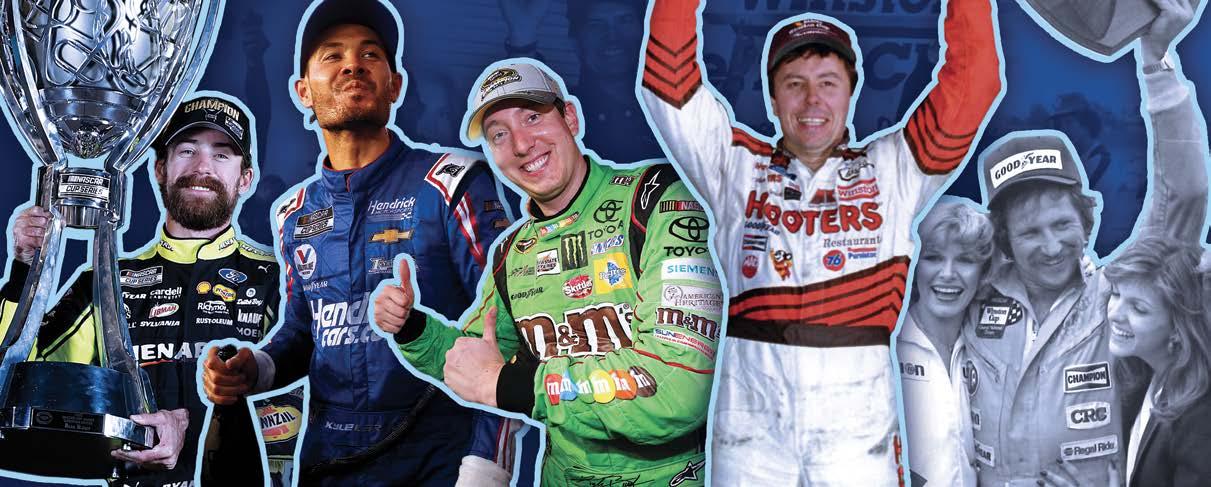
Over its more than 75-year existence, NASCAR has seen some surprising drivers ascend the sport’s highest mountain to become a champion of what’s today known as the NASCAR Cup Series. So, which of these drivers were the least expected to seize the championship mantle when they did? Let’s take a look at the five biggest championship shockers of all time.
Despite driving for one of NASCAR’s best organizations in Team Penske, Blaney never whiffed a championship in any of his first five seasons with the Roger Penske-owned group.
The 2022 season was particularly disappointing for the second-generation driver, as he failed to reach Victory Lane for the first time since 2016 and finished eighth in the standings – one spot worse than he finished the year prior. So, by the time 2023 rolled around, some pundits had started to quietly question whether Blaney – who’d never finished better than seventh in the standings – possessed the proverbial chops required to take the next big step in his career and become a serious title contender.
Blaney answered the call in a big way, however, by not only making the Championship 4 for the first time but laying claim to the Cup Series title – a championship almost no one thought he would win.
After showing flashes of his enormous talent over a more than six-year run with Chip Ganassi Racing, Larson endured a major career setback in 2020 when four races into the season – while NASCAR was on an extended pause for the COVID-19 pandemic – Larson lost his job at Ganassi and was suspended indefinitely by NASCAR for using a racial slur during an iRacing event.
His future in the sport very much in question, Larson kept a low profile for the next several months while completing NASCAR’s racial sensitivity training program in hopes of repairing his reputation and getting another opportunity. After being reinstated by NASCAR in October, that opportunity came less than two weeks later when Hendrick Motorsports announced it had signed Larson to a multi-year contract beginning with the 2021 season.
Although Larson had much to prove both personally and professionally after missing all but four races in 2020, he defied the odds by not only winning the 2021 Cup Series championship but doing so in remarkably dominate fashion as he went to Victory Lane an incredible 10 times.

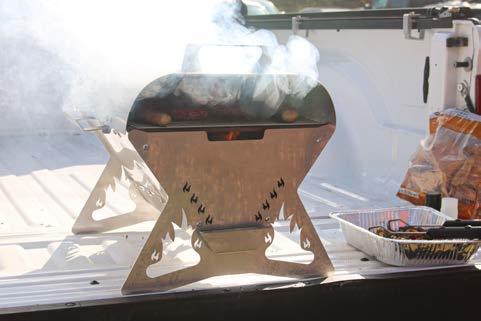
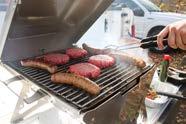
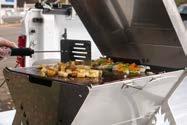

Experience the ultimate in tailgating versatility with the American-made TG Series Grill, your compact, durable solution for grilling, griddling, and more. Transform your race day with ease and enjoy a variety of foods, from morning pancakes to wood-fired pizzas, all with one robust, portable grill.
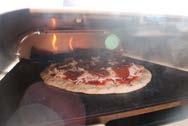


DON’T JUST HOST A TAILGATE—DOMINATE IT WITH THE TG SERIES GRILL. Made to move and built to last, the TG says goodbye to bulky grills and hello to space-saving solutions and motion control technology.
Leading up to the 2015 season, Busch was widely considered a championship contender. That prognostication changed in an instant just a day before the Cup Series campaign commenced, however, when he suffered major foot and leg injuries in a violent crash during the NASCAR Xfinity Series race at Daytona International Speedway.
Busch, who spent time in a Daytona Beach hospital, would go on to not only miss the Daytona 500 but the season’s first 11 points races while recovering from his injuries. After being granted a NASCAR waiver that made him playoffeligible despite not entering every regular season race, Busch triumphed in just his fifth start – on the Sonoma Raceway road course in June.
He went on visit Victory Lane five times, including in the season finale at Homestead-Miami Speedway where he was crowned champion after overcoming the longest of odds based on how his season began.
Prior to the 1992 season, Kulwicki had won only three races over six seasons as a full-time, or mostly full-time, driver at NASCAR’s top level. The former Late Model sensation had also finished no better than eighth in the standings, which he did in 1990.
It all came together for Kulwicki in 1992, however, as the Greenfield, Wisconsin, native enjoyed his first multi-win season with two trips to Victory Lane, and he won the title by 10 points over Bill Elliott – then the narrowest margin in NASCAR history.
Sadly, Kulwicki lost his life in a plane crash on April 1, 1993, but only after reaching the pinnacle of the sport in dramatic fashion. During the 1992 season finale at Atlanta Motor Speedway, Kulwicki finished second to Elliott in the race but earned the title by virtue of leading one more lap than Elliott during the event.
With just one year of competition as a full-time Cup Series driver under his belt, Earnhardt stunned the racing world in 1980 when he became the first driver to claim the sport’s biggest prize a season removed from rookie status.
Earnhardt, who won just once in 1979 on the way to claiming rookie-of-the-year honors, went to Victory Lane five times the following season in his blue and yellow No. 2 car owned by Rod Osterlund. None of Earnhardt’s future championships –which came in 1986, 1987, 1990, 1991, 1993 and 1994 with Richard Childress Racing – were much of a surprise compared to his memorable title run in 1980.
To this day, Earnhardt is the only driver to capture the Cup Series crown in only his second season as a full-time driver in NASCAR’s premier division.
BY JARED TURNER
More so than with any other sport in the world, sponsorship is king in NASCAR.
However, it’s not just the big colorful logos adorning the hoods and sides of the race cars that speak to the tremendous impact of corporate sponsorship on the sport.
It’s also the billboards, signs and logos scattered around the race tracks, the paid TV advertising that pours into millions of living rooms on race day, and the steady stream of marketing and promotional content available at NASCAR’s social media channels and NASCAR.COM.
By way of these platforms and others, fans have come to know and embrace NASCAR’s Official Partners – those brands that don’t necessarily sponsor the drivers or the teams but that are nevertheless woven deeply into the fabric of NASCAR.
“Sponsorship in NASCAR is the lifeblood of our sport,” said Michelle Byron, NASCAR senior vice president of partnership marketing. “Without our tremendous partners across the industry, we would not be able to
bring our sport to the most loyal fans in the world every single week. Our sport is literally driven by sponsorship, and our fans embrace it. It’s a mutually beneficial model, and our partners are a huge piece of what makes our sport so great.”
Collectively, NASCAR’s 50-plus Official Partners have been involved in the sport around 10 years on average. Brands such as Goodyear and Coca-Cola have been NASCAR Official Partners for longer than every single current NASCAR Cup Series driver has competed in NASCAR’s top division.
“The value in our partnerships can be seen in the tenure of our roster,” Byron said.
While many partners have been incredibly committed to NASCAR for a long time, fans of the sport have been just as committed to them. Consider, for example, that according to a 2023 MarketCast for Sports Business Journal study, Goodyear’s role as the Official Tire of NASCAR
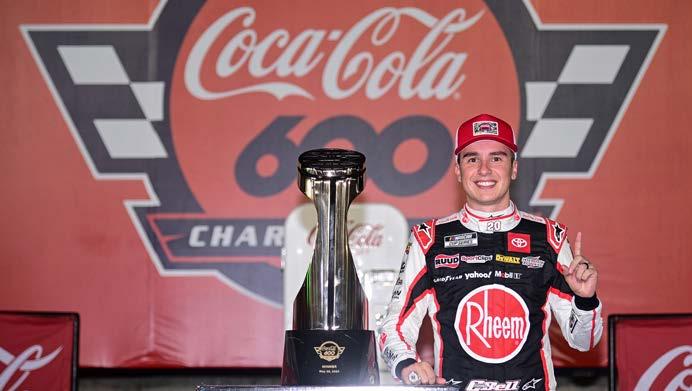
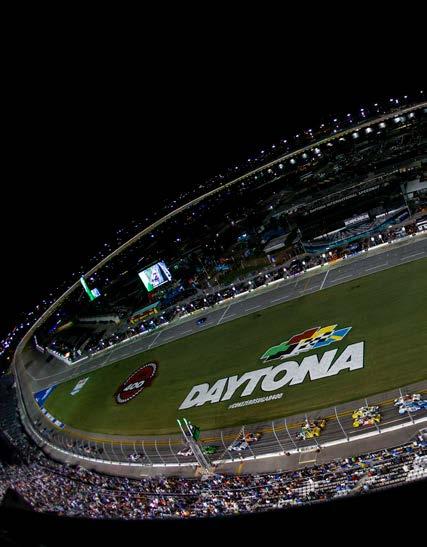
is the most recognized sponsorship in all of professional sports. Coca-Cola, which became a NASCAR Official Partner in 1998, checks in at No. 2.
“First and foremost, NASCAR is about the fans – and NASCAR fans prove year in and year out to be the most sponsor-loyal fans in all of sports,” Byron said. “In fact, nearly one in four Fortune 500 companies are invested in the NASCAR industry. Our relationships with our partners are mutually beneficial, as our sport offers numerous ways to activate – whether it’s at the league level, as a track or multi-track partner, on our digital and social platforms, on television or with the sport’s stars.
“In turn, through these activations and promotions, our partners play a significant role in enhancing the fan experience, driving interest in our sport and reaching new
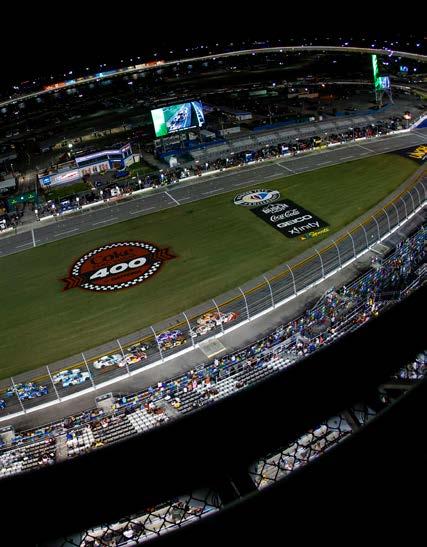
audiences that we may not be able to connect with on our own.”
Although several NASCAR Official Partners have been around for quite a while and, in some cases, even multiple decades, many of NASCAR’s Official Partners are relative newcomers to the sport. Those that have come on board in the fairly recent past include Powerball, Ally Financial and RTIC Outdoors, the last of which is now the Official Cooler and Drinkware of NASCAR.
“In the case of Powerball and RTIC, we have so many synergies in who our fan base is and those that these companies are working to reach, and being able to activate through our sport helps build awareness among the fan base,” Byron said. “In the case of Ally, they have been an extremely involved brand – starting at the team level with Hendrick Motorsports and Alex
Bowman – that further expanded to become a race entitlement in Nashville with the Ally 400, and then beginning in 2023, a NASCAR partner. For Ally and NASCAR, it’s a tremendous partnership based on our shared goal in working to advance inclusivity across the entire industry.
“Despite different areas of focus, all these partnerships are thriving and meeting goals at several different levels in the sport.”
In late 2019, NASCAR introduced a new sponsorship model for its premier series. This model, which broke from the almost-fivedecades-old tradition of the premier series being aligned with a single entitlement sponsor, showcases four “Premier Partners.”
This quartet of cornerstone brands includes Busch Beer, CocaCola, GEICO and Xfinity – the last of which also serves as the entitlement sponsor for NASCAR’s No. 2 division.
“Our Premier Partners are some of the most iconic and recognized brands in the world,” Byron said. “We’ve seen great fan appreciation for their leadership role as a collective group as they serve our fans with engaging programs – from NASCAR Salutes Together with Coca-Cola, to GEICO activations in our campgrounds, to Busch Light’s fun fan engagements like their #Pit4Busch promotions, to Xfinity’s role especially around the Xfinity Series.
“Additionally, we’ve launched our second year of our ‘Thank You, Fans’ campaign, brought to fans by NASCAR and the collective Premier Partners. This campaign – which runs from Richmond through Darlington – will showcase a variety of messages and acts of thanks to our fans for their loyalty and support.”

Beginning in 2025, NASCAR will welcome three new TV partners in TNT Sports, Amazon Prime and The CW Network, which are set to join FOX Sports and NBC Sports in anchoring the coverage of the NASCAR Cup Series, NASCAR Xfinity Series and NASCAR Craftsman Truck Series.
“Our new media rights agreements with all our incumbent and new partners – FOX, NBC, TNT Sports, Amazon Prime and The CW – demonstrate that NASCAR is a premier sports media property,” said NASCAR’s Michelle Byron said. “The optimized distribution strategy balances traditional and new consumption platforms, setting us up to best serve our fans in the coming years. In turn, this multiplepartner model will lead to increased visibility, marketing and investment for the entire industry, including our Official Partners.
“Our group of media partners provides ample, unique opportunities and voices for brands to promote their role in the sport and our shared activation efforts.”
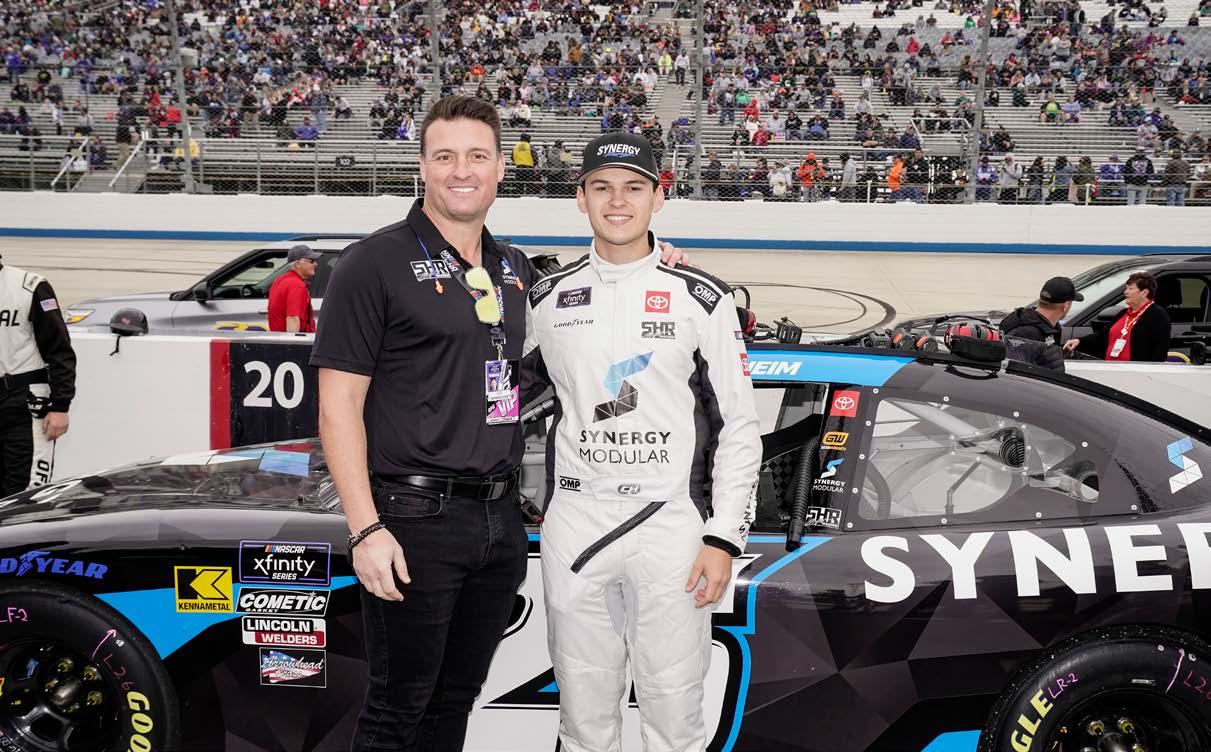
For Sam Hunt Racing, finding race team partners requires time and patience, but the rewards are worth the effort when it finds the right fit.
BY JARED TURNER
Sam Hunt Racing, a NASCAR Xfinity Series team located in Mooresville, North Carolina, had agreed to a full-year sponsorship for the 2024 season with a company that eventually reneged on its commitment.
Understandably, the change in plans was a setback for team owner Sam Hunt, who entered NASCAR’s No. 2 division in 2019 and operates with no NASCAR Cup Series affiliation.
“That was an example of someone who kind of talked the talk but couldn’t walk the walk, and it never materialized, and it left some people hanging and created a tough situation, but that’s not the first time I’ve been through that,” Hunt said. “I think a lot of people in this sport have been through that and understand the process. For me, I think it’s just about staying confident in who I am and what I’m trying to do and how I’m trying to do it. I think the saving grace for me is just understanding that if I stay true to myself, it should attract the right people and the right things should happen.”
That’s exactly what did happen a few months later when Justin Stewart – the CEO of Synergy Modular, a second-generation and
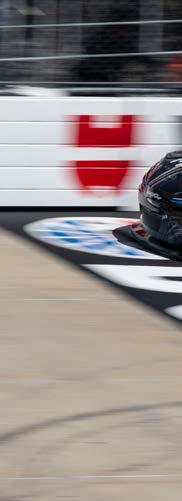
family-owned construction company with projects nationwide –agreed to become a multi-race primary sponsor of Sam Hunt Racing for the 2024 Xfinity Series season.
“I know they were left in a really tough position, and that kind of presented the opportunity for us,” said Stewart, whose business has its main offices in Scottsdale, Arizona, and Seattle, Washington.
Stewart, whose company had no history in NASCAR and who hadn’t attended a NASCAR race in at least 15 years prior to this February, admittedly needed some coaxing to come on board.
“It’s fair to say I was extremely skeptical – keeping in mind that, as a company, we have a traditionally small marketing budget,” Stewart said. “This was a pretty large departure from our approaches in the past, so we were very skeptical and very much wanted to do a lot of research to make sure any dollars invested – any dollars invested are a big deal – were being well-vetted and they were a good investment.”
Tony Priscaro, the founder and president of PK Velocity Sports & Entertainment – a sports marketing agency that represents Sam
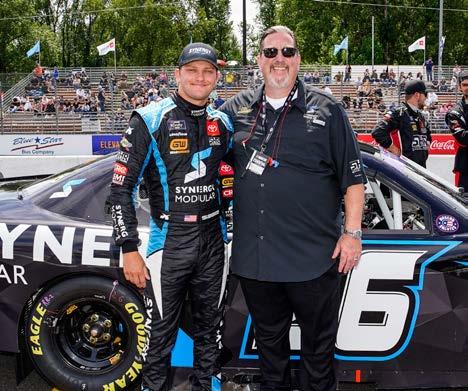
• LEFT PAGE: Justin Stewart (L) and Corey Heim
• LEFT: Sage Karam (L) and Tony Priscaro
• BELOW: The No. 26
Sam Hunt Racing
Synergy Modular
Toyota GR Supra

Hunt Racing – was the primary player in convincing Stewart that joining forces with Sam Hunt Racing and its driver roster that includes Corey Heim, Jeffrey Earnhardt, Sage Karam and Ed Jones would be mutually beneficial.
“Construction in NASCAR is perfect, because all of their vendors are in NASCAR somewhere in some shape or form. They’ve been or they are or they want to be,” said Priscaro, a veteran of the NASCAR sponsorship landscape and the one who’d been at the forefront of Sam Hunt Racing’s other sponsorship deal that inexplicably fell through. “The window guy, the electrician, the HVAC guy, the national companies, they’re all in NASCAR, plus all the fans … they’re part of that group. So it’s just such a win-win for a construction company, especially if they’re large and have a national footprint like Synergy Modular.”
After multiple conversations with Hunt that included some at Daytona International Speedway in February and again at Las Vegas Motor Speedway in March, it became apparent to Stewart that pairing up with Sam Hunt Racing and establishing a relationship
with its other sponsors and partners at Toyota Racing would be a move that would bear tangible fruit.
“Ultimately, we are able to identify and have initial conversations about multiple business-to-business opportunities that kind of proved that with the right follow-through, the sponsorship would more than pay for itself,” Stewart said. “We really look at investment, partnership and relationships from a long term perspective, and we quickly learned that Toyota leads with this approach. They showed us potential partnerships for this year and years to come, for us all to grow and build together.”
Hunt immediately established a strong rapport with Stewart when the two met in person at Daytona at the start of the season.
“Right from the bat, we had a lot in common – whether it was how we run our businesses, our moral compass or even our background when it comes to sports, and our personal lives,” Hunt said. “So, it really was a friendship at first, and we kept in touch and kind of spit-balled ideas of how we could help each other.”
Finally, in late April, Synergy Modular revealed its intentions to join Sam Hunt Racing for six races this season as a primary sponsor and serve as an associate sponsor for the rest of the schedule. Stewart taking several months to buy in was not a concern for Hunt. He actually preferred it that way.
“The fact that it wasn’t a quick deal and that it took coming up with a real strategy for all parties really made me more comfortable,” Hunt said.
“I tell people all the time that when we talk to someone – Justin is an example – that isn’t willing to just jump in and they want to do their due diligence and have a strategy and a plan, that almost makes me more comfortable in my seat, versus someone that’s just excited to be a NASCAR sponsor and wants to dive all in and really doesn’t quite have a plan put together.”
With Priscaro as the quarterback in the negotiations, Hunt and Stewart are both excited about the potential for a sponsorship that continues in 2025, perhaps at an even greater capacity.
“All things working out, I’m open to only increasing that partnership going forward,” Stewart said. “For us, as a pretty rapidly growing company, a lot of our marketing efforts are focused more on hiring than on anything else. So, there’s great alignment there with Sam Hunt Racing, but, more importantly, it was just alignment of values – values within the Sam Hunt Racing organization, values within Toyota Racing (TRD), and values within NASCAR.”
Whether the sponsorship expands next season or not, Hunt wants Stewart to be completely comfortable with the terms – just like he eventually came to be with their deal for 2024.
“My goal is to be partnered with him in whatever is a healthy fashion,” Hunt said. “If we can drive enough value to Synergy and to Justin to justify a potential full season partnership in the future, I think we’d all be absolutely ecstatic about that, but it’s also very important to me that everybody’s in a healthy place, and if that means, ‘Hey, they’re going to be a team partner for the future and for years to come and they’ll be a primary sponsor on the car when appropriate,’ I’ll be just as happy about that.
“For me, it’s making sure that Synergy is in a good spot, that they’re healthy and that their growth through our network goes hand in hand with Sam Hunt Racing and our growth. I think the possibilities are endless.”
BY JARED TURNER
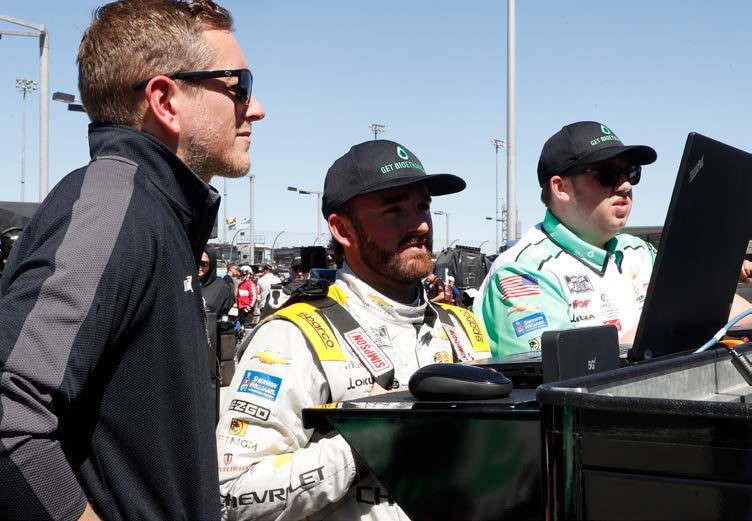
As race engineer on the No. 3 Richard Childress Racing Chevrolet driven by Austin Dillon, Joel Keller has quite the laundry list of responsibilities.
They start at RCR headquarters in Welcome, North Carolina, on Monday morning and continue through the week, culminating at the race track on Sunday evening.
The objective, of course, couldn’t be any more straightforward: to make Dillon’s No. 3 car go as fast as possible and end up in Victory Lane.
“You work on it during the week and see how it runs on Sunday, and that’s it,” said Keller, a Poquoson, Virginia, native and 37-year-old father of three. “A regular job, I struggle with sitting at the office and every six months talking to your boss about how you’re doing. This job trains you to push hard, and that’s just not so common in the workplaces that I’ve been a part of outside of NASCAR teams.
“So, I appreciate that. I love that. I like working around like-minded people all pushing for one goal. It’s very obvious what that goal is. You don’t even have to discuss it.”
While the goal of a race team is rather simple, the job of a race engineer tends to be a bit more complex. Let Keller – who holds a degree in mechanical engineering technology from UNC Charlotte and has worked in various engineering-related capacities in the sport since 2013 – explain his typical weekly responsibilities in his own words.
“I like to say that to be a good engineer, you have to be a good student of history,” Keller said. “You start the week and you’re reading old notes, you’re looking over old simulation files and results from those, and then you’re trying to
compare some of that data against what worked at the race track. ‘Which car was good? Which car was bad?’ And, you try to surmise why they were good and why they were bad.
“Then, you spend the next day or two trying to make your car into whatever you think is best out of that information that you pulled from that history. That gets you to a starting point for going to the simulator.”
A simulator is a highly sophisticated machine the team uses to create a virtual representation of the car as it will be in actual race conditions. Typically, the driver will hop in the simulator for a few hours each week in preparation for the upcoming race, so it’s a joint effort between the driver and the team.
“You go the simulator and kind of work on it,” Keller said. “You go with a test plan, and then you also just kind of do a little bit of test and tune as if you were having a normal practice at the track – making spring changes and trying to get the driver happy with the balance and stuff like that. So, that pretty much carries you through Tuesday or Wednesday.”
After wrapping up the time spent in the simulator, a race engineer’s work at the shop isn’t over.
“You’re making sure the car gets set up to exactly where you want it,” Keller said. “They measure the cars down to the thousandth of an inch on every dimension, so you’re checking that against all your sim models and making sure you’ve got everything dialed in as close as you can, because it’s all critical at this point.
“So, we’re going through all that data and making sure the car’s within the proper specifications, and we’re working with the car chief and others to make sure we’re happy with where it sits.”
Upon arriving at the race track on Saturday morning, the race engineer’s job continues.

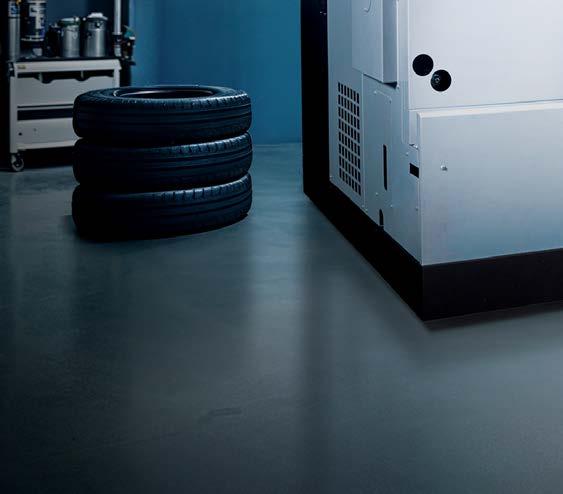

• Master craftsmanship meets cutting-edge technology with the debut of the Okuma LB3000 EX III
• Newly designed horizontal lathe with open-architecture Okuma OSP-P500 control
• Improved machining quality, speed, power, and torque
the
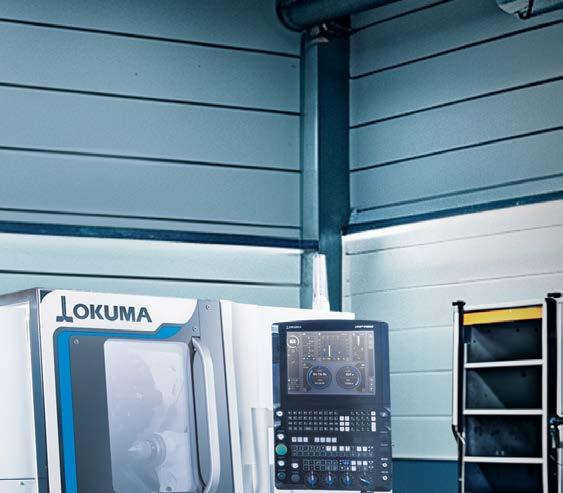


• Built with a rigid slant-bed box construction and thermal stability for extreme accuracy
• Ballscrew-driven tailstock with X and Z rapid traverse rates increase productivity
• Automation-friendly integration





“We’ve usually got some information on partner teams, and we see what they’re doing. So, we’re trying to assess what they have and if there’s anything we want to pull from that that we think we could benefit from,” Keller said. “Any ideas, maybe, we haven’t had yet or something that might show some potential, we kind of go through that. In my job now, you have to take the shocks to NASCAR technical inspection, which takes almost as long as the car rolling through technical inspection.
“I used to go to tech with the car, but now I have to take the shocks for an hour. So, we do that and just make sure we get our shocks set to exactly where they need to be.”
Gauging driver feedback and keeping a close eye on various pieces of data are a big part of a race engineer’s job leading up to qualifying and the race. The night before the race is especially pivotal, as it’s the time when the race engineer collaborates closely with the crew chief to make a number of final decisions related to the car.
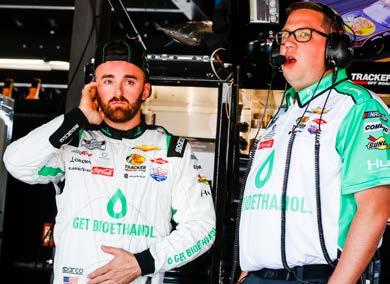
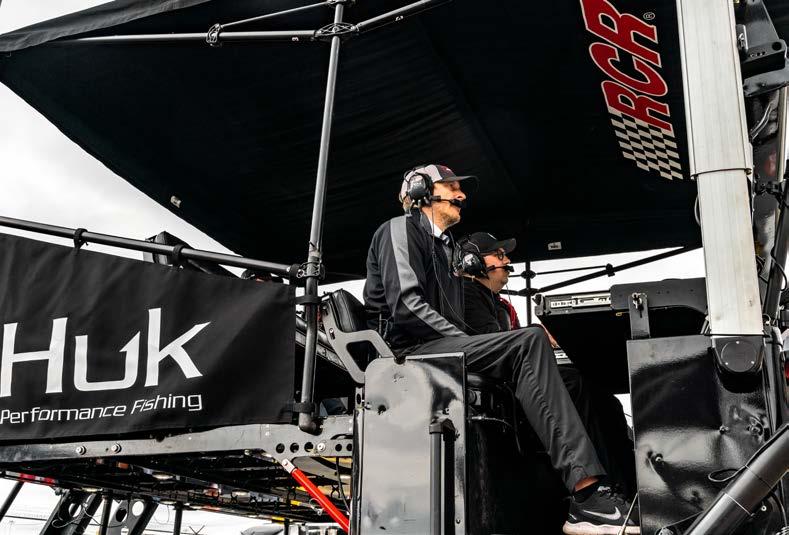
“We’re back to the hotel and working on trying to make a plan for what we’re going to do for the race. And, that’s just a few setup items that we’re allowed to change,” Keller said. “We’re trying to optimize those and make a plan for what we’re going to do as far as pit strategy, and we talk to the crew chief a lot. We usually go to dinner on Saturday and talk about what our plan is for pit strategy, how we want to lay out our fuel savings and what we want to target and focus on.
“The crew chief is usually just a more experienced race engineer these days, so he’s tipping me off on different things that he thinks I can look at that maybe I haven’t looked at that his experience leads him to want to look at, but maybe he doesn’t have the time to dive into the details. So, I kind of act as his assistant in that regard.”
When race day arrives, the race engineer’s role changes, but it remains nevertheless vital to the team’s success.
“We get into the race, and I’m just an intercom system,” Keller said. “I’m monitoring the data related to the car’s performance and making sure the car’s balance is OK. I’m taking feedback from the driver and comparing it to my list of adjustments and seeing if we have an adjustment that could correct his issues.
“I’m helping the crew chief with pit strategies and some of our strategy analysis tools and just trying to get the most out of the race that we can. Then, you start all over again on Monday morning.”
beginning in 2007 with the rollout of the Cup Series vehicle known as the Car of Tomorrow – a far more sophisticated vehicle than NASCAR’s premier series had ever used.
Keller believes the race engineer’s job has become even more paramount in the years since – especially with the current Cup Series model, known the Next Generation car, that debuted in 2022.
“You have to have everything really, really, really dialed in,” Keller said. “You don’t come to the track with a car that just has a better body build, or anything like that, anymore. That’s just not available. So, having a very detailed engineer who can go through and just try to dial everything into where we think it needs to be just becomes more and more important the closer and closer the cars get to each other, I feel like.
“Your whole thing is execution. That’s how you find performance – it’s in execution now.”
What are the qualities of a “great” race engineer? Keller’s answer might surprise you.
“I think you have to be a bit creative, which I think a lot of people probably don’t think of engineers as being creative in some regard,” Keller said. “But I do a lot of what they call ‘freestyling,’ just trying to come up with ideas. If you’re not creative, you’re never going to move forward. Certainly, you need to be organized, too. Being organized allows you to act on the information you have.
“I think what makes it difficult for a lot of engineers is that you need to be a good communicator. You’ve got to be able to talk to the driver, establish some rapport with him, and the same with the team. You’ve got to be able to go down to the setup plate and talk to those guys and have them relate to you in order to get the most you can out of them.”
Keller then summarizes ever so neatly what he sees as the necessary skill set for a race engineer.
“Creativity, organization and communication skills, I think those are the most important things,” he said. “It’s not being a math genius or anything like that. It’s some of those, maybe, more intangible things.”
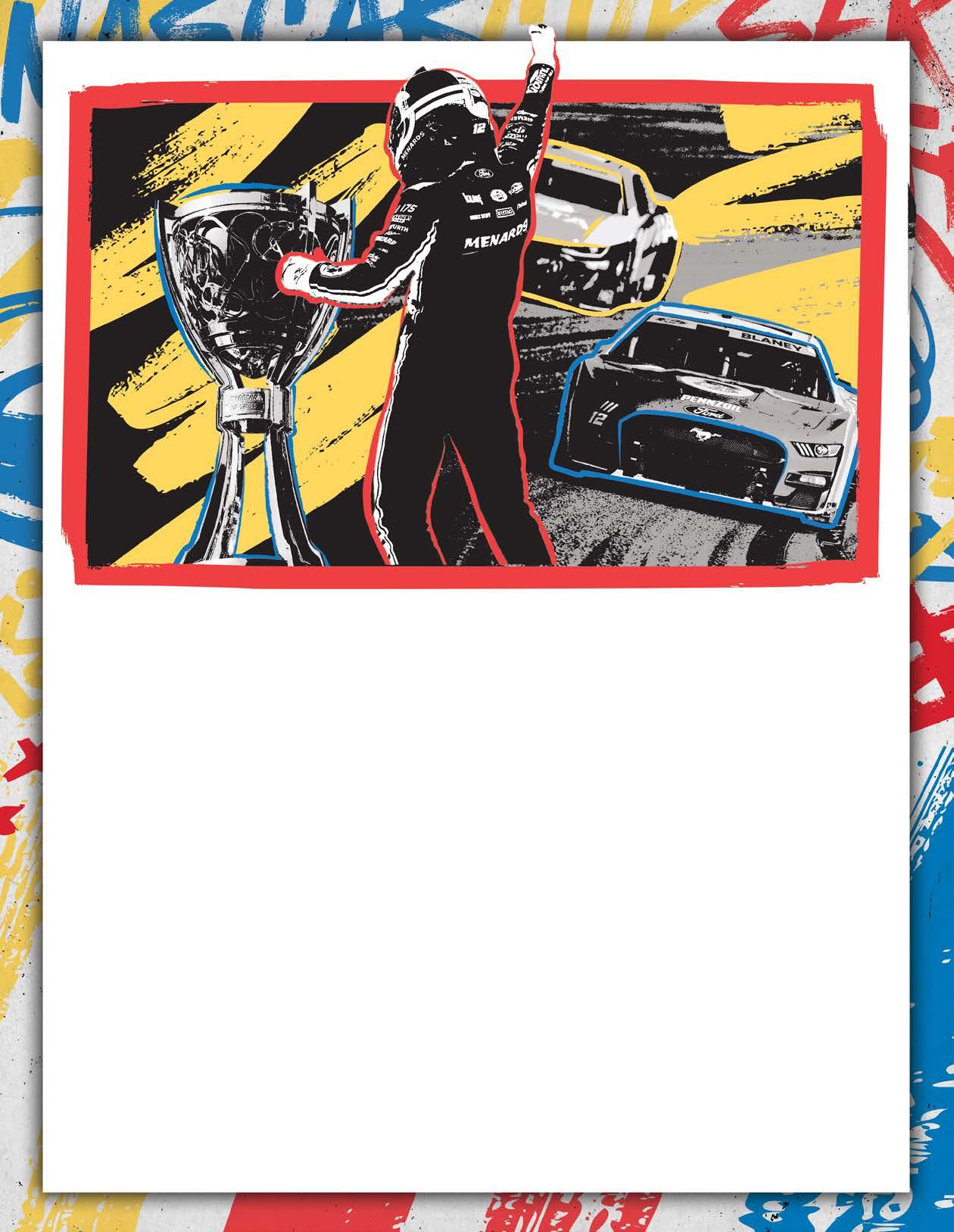

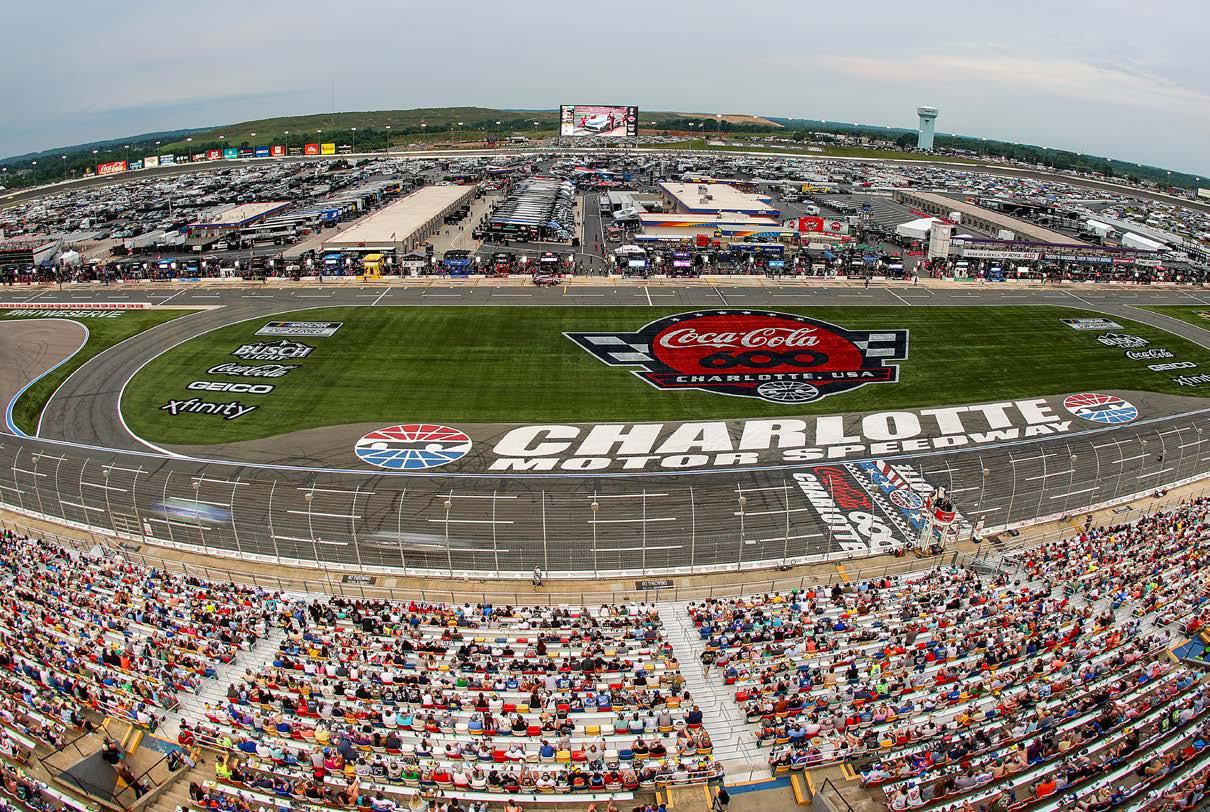
BY JOSHUA LIPOWSKI
Charlotte Motor Speedway is one of the premier camping destinations in NASCAR. During its two major race weekends, the legendary motorsports facility offers multiple camping options and the atmosphere varies from campground to campground.
Recognized as America’s Home for Racing, the track also provides year-round camping for those who chose to explore the area during non-event periods.
NASCAR Pole Position recently caught up with Matt Mancini, Charlotte Motor Speedway’s camping operations manager, and he shared tips for camping in the heart of NASCAR.
The Race Is Great, but There’s More to Explore. Mancini notes that the camping experience at Charlotte Motor Speedway offers opportunities not available at other NASCAR facilities. For instance, many fans stay at Charlotte for a full week instead of just a few days so they can visit the race shops, tour the NASCAR Hall of Fame and explore other area motorsports attractions.
“Charlotte is unique and special because within a 25-30 mile radius we have more than 25 race teams right here in the heart of the Charlotte area,” said Mancini. “That’s why our area is so much more desirable to come and camp for the whole week for the event, versus just a random race track for just a couple of days.
“Our guests enjoy the whole week leading up to the race, so they get to go to the race shops and attend autograph signings, go to the teams’ gift shops and take tours throughout the week.”
Charlotte is not the only NASCAR facility to offer campers unique opportunities beyond the on-track action. For example, Texas Motor Speedway has the Fort Worth Stockyards nearby, Daytona International Speedway is near the beach and Kansas Speedway has a casino off the backstretch.
Find a Campsite Tailored to Your Experience. Race tracks often have multiple campgrounds available on a NASCAR weekend, and Charlotte Motor Speedway is a leader among the group.
First, Mancini points out a camping option for fans who want full hookups and a premium luxury experience. Other amenities include a shuttle service to the track and a pickleball court.
“We’ve got the full hookup campground here right in front of zMAX Dragway,” Mancini said. “It’s got water, sewer and 20, 30 or 50 AMP (power). When I came here a few years ago, we added high-speed internet throughout the park. That was one of the things that a lot of campgrounds don’t have.”
Mancini also spotlights the Family Campground at Charlotte. This is for those looking for a more traditional camping atmosphere. Mancini claims that if he’s camping with his family, this is where he goes.
“It’s more of a primitive camping where you’ve got campfires, grilling hot dogs, this family atmosphere,” he explained. “Turn 4 family campground has a tent we have setup where we have a group called Raceway Ministry come, and they just love on our guests. We have a prayer service, a bonfire and a country breakfast on Sunday morning, all free.”
The infield is the party scene at Charlotte. It’s also where fans often build relationships with fellow campers. This is the spot for fans looking to have a good time and enjoy some rowdy daytime or late-night fun with friends.
“It’s a little bit louder, and there’s music, hooting, hollering and camaraderie,” said Mancini. “It’s just a neat, neat atmosphere. We’ve got a lot of people that have been coming here for many, many years, so when you even mention moving their site two rows over, they don’t want to do it because they’re looking for their friends.”
In addition to the 1.5-mile superspeedway, Charlotte has a second NASCAR race track, the ROVAL. Mancini says the Coca-Cola 600 and the Bank of America ROVAL 400 attract different crowds, and the ROVAL makes for a unique experience, particularly in the infield.
“If you look at the map,” he said, “you can see where those campsites are right next to the wall, so it’s much more fun. It’s right there at your doorstep. The race track is right there, you can feel it and you can smell it.”
Mancini urges fans to visit the track’s website. Every track offers a slightly different experience, and multiple campgrounds have different rules and unique atmospheres. There’s a little something for everyone.


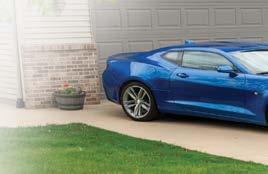
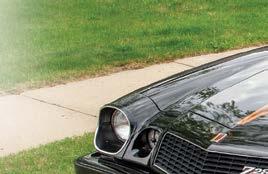
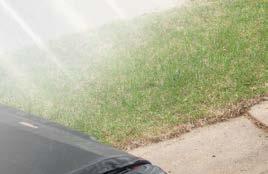
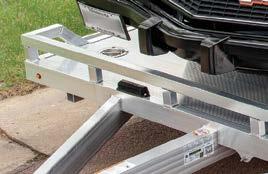

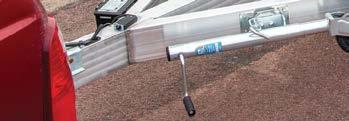
Year-Round Camping. Charlotte Motor Speedway is unique in that it offers year-round camping at the Camping World Racing Resort. Why would someone camp at a race track during a time when there is no event? Mancini says it’s due to the numerous activities in the Charlotte region outside of the track’s annual NASCAR weekends.
“We’re a mile and a half from interstates that are major arteries throughout the southeast,” said Mancini. “We’ve got shopping right here, right down the road. We have the NASCAR Hall of Fame. We have events throughout the year, not just NASCAR.”
Other Charlotte Motor Speedway events that Mancini recommends include a giant holiday light show, a Monster Truck spectacular, an NHRA drag race and a series of Legend Car events.
According to Mancini, families often utilize the campground if they are in town to visit relatives, and those who travel due to work, such as traveling nurses or pipeline workers, are regulars at speedway campground.
“It’s centrally located, secure and they’ve got a piece of home instead of staying in an extended stay hotel room,” said Mancini.
Charlotte Motor Speedway is a fun place to camp, even if your visit is for something other than a NASCAR event.

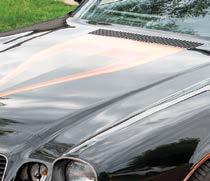



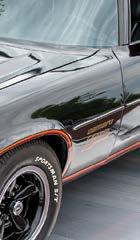

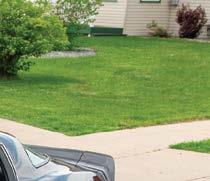

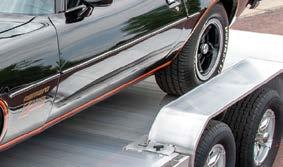








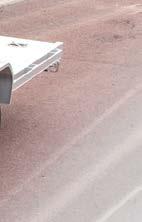




























Whether you’re looking for utility, recreation or fun, Aluma has the perfect trailer for you! Aluma offers a complete line of durable, lightweight and maintenance free aluminum trailers.






















BY JOSHUA LIPOWSKI
NASCAR fans who wish to splurge on a luxury at-track camping experience have plenty of options, as there are several high-end campgrounds that provide breathtaking views and exclusive amenities.
In compiling this list, we focused on campgrounds that take the NASCAR fan experience to unprecedented heights. Fans willing to shell out some extra money will have a lot of fun with these experiences.
Texas Motor Speedway tore down a portion of the backstretch grandstands and replaced the seats with a luxury RV experience. Fans have full electric and water hookups, restroom access and concierge service at their campsite – all combined with a great view of the race track.
The RVs are perched on a hill along the backstretch, allowing fans to watch the action from the comfort of their home away from home. The only drawback is the inability to see the giant Big Hoss video board, but it’s still a great experience for fans wanting to add luxury to their NASCAR weekend.
Atlanta Motor Speedway made lemonade out of lemons when the backstretch grandstands were damaged by a tornado in 2005. They came up with the Trackside Terrace, which provides panoramic views of the 1.5-mile race track.
The holder of each of these premium RV spots also receives 10 Trackside Terrace Admission passes to be distributed to family or friends.
Again, like Texas, this campground is where grandstands once stood. It offers an excellent luxury experience at one of NASCAR’s most popular race tracks.



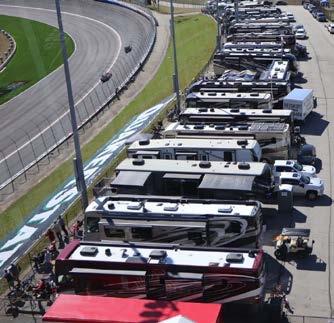

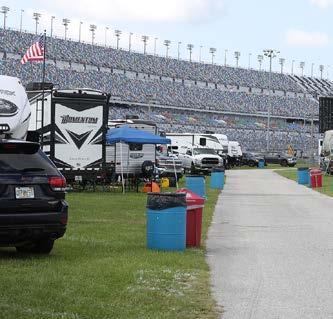

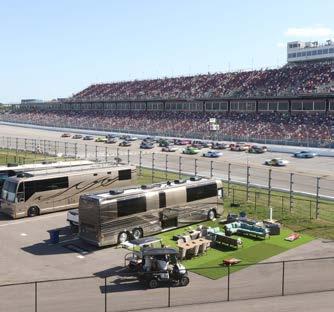


Daytona International Speedway is a premier NASCAR facility and its GEICO Grounds Yellow Premium campground sets the standard among luxury camping areas.
It features great views of Turns 1 and 2, where a lot of action takes place.
The campsites located directly on the inside of the turns feature some of the best amenities, including electric hookups. The 700 numbered sites in Turn 2 have both electric and water hookups. These campsites also overlook Lake Lloyd, meaning some solid views of the backstretch.
Imagine being inside the race track near the start/finish line. This typically does not happen at a NASCAR track since pit road and the garage area are traditionally located adjacent to the frontstretch.
But the unique location of the start/ finish line at Talladega Superspeedway provides space one of the most unique campgrounds in NASCAR. The Finish Line Premium RV campground is a premium experience located just past the start/finish line.
This campground includes hookups for water, electricity and sewer, giving fans all the comforts of home. It also offers a unique perspective for watching the race and has one of the best views of the track from the infield.
Charlotte Motor Speedway also has an overlook camping area similar to Texas and Atlanta, but this one is located outside of Turns 1 and 2. It is a unique place for a campground, but a great one nonetheless.
The 600 Terrace features full RV hookups and offers incredible views of both the superspeedway and the ROVAL. This campground also features pop-up shelters and seating areas for space holders to utilize.
These luxury options are just a sampling of the unique camping experiences available at NASCAR tracks across the country. Visit NASCAR.com/camping for additional details.



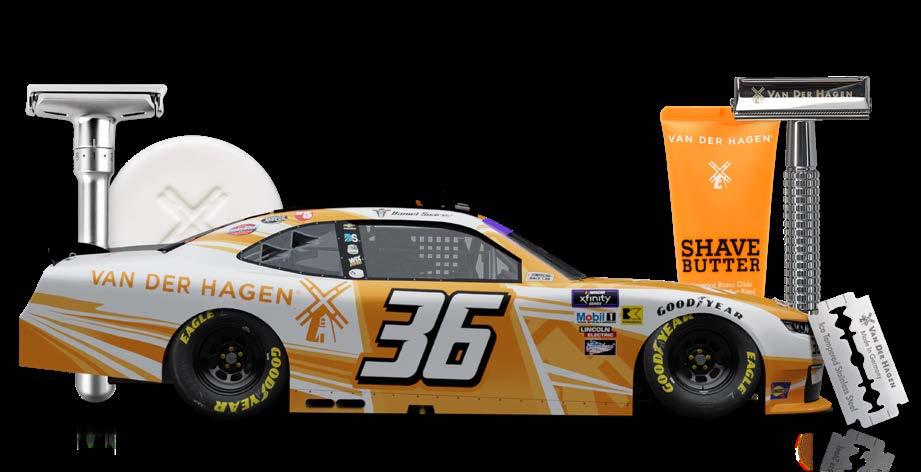

BY DUSTIN ALBINO
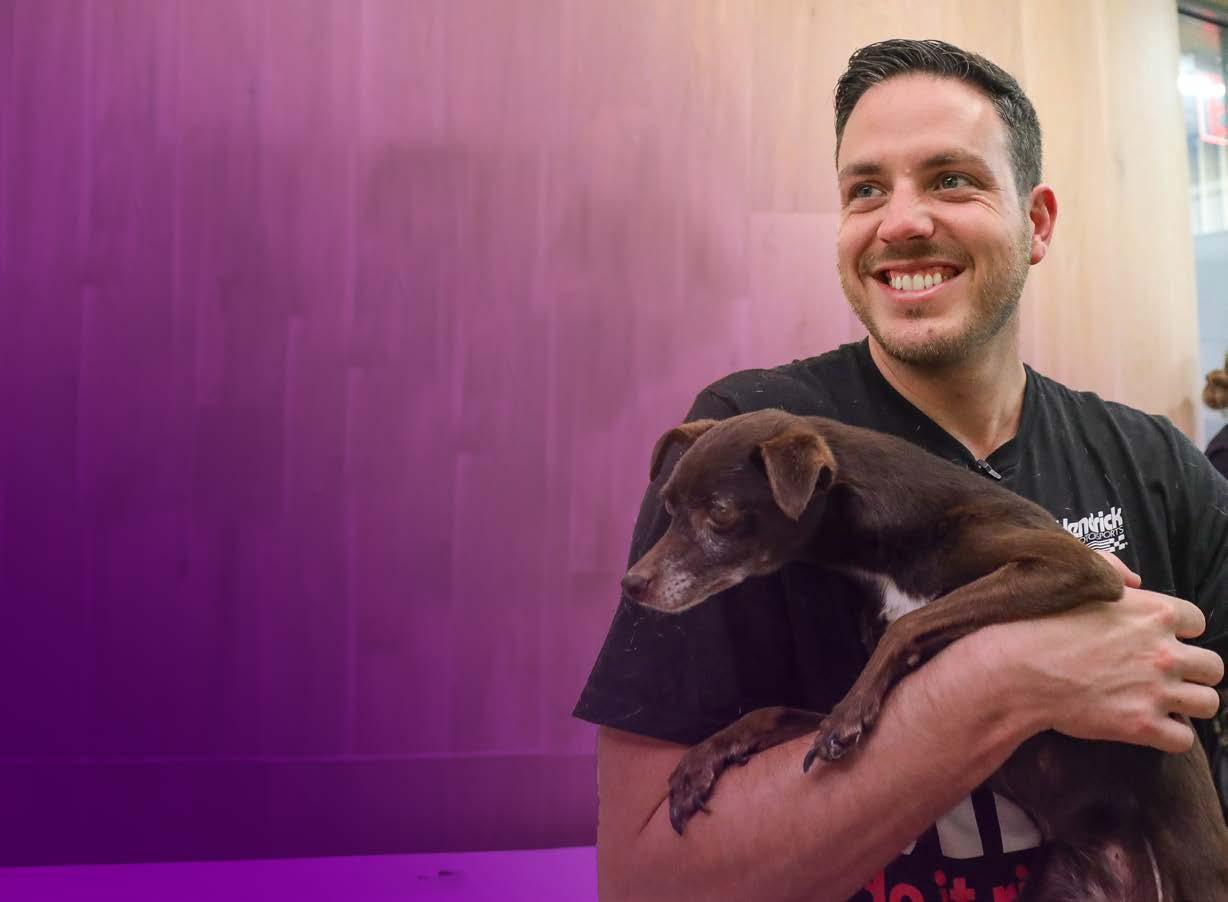

Alex Bowman had already experienced the highs and lows of big-time stock car racing when the native of Tucson, Arizona, was hired to drive for Hendrick Motorsports following Dale Earnhardt Jr.’s retirement at the end of the 2017 NASCAR Cup Series season.
Bowman started driving quarter midgets at age 7 and advanced through the open-wheel ranks on the West Coast where his success caught the attention of NASCAR team owners. He ran the full ARCA Menards Series East schedule in 2011 and signed a developmental contract with Team Penske for 2012.
Bowman had immediate success in ARCA with Cunningham Motorsports, winning four of 19 races and finishing fourth in the championship standings. Ahead of the 2013 season, Bowman signed to run the full NASCAR Xfinity Series for RAB Racing, which was owned by industry veteran Robbie Benton.
He moved to the NASCAR Cup Series with BK Racing for 2014 and then drove Tommy Baldwin’s cars during the 2015 Cup Series season. In the weeks prior to the 2016 Daytona 500, Bowman learned via Twitter that he’d been replaced at TBR by Regan Smith.
That driver change turned out to be a blessing for Bowman. He landed a part-time deal with JR Motorsports in the Xfinity Series for 2016 and scored a top-10 finish in each of his first seven starts. After leading 33 laps and finishing third at Dover Motor Speedway, Bowman voiced, “Hi, my name is Alex Bowman, and I can drive a race car … still.”
Throughout 2016, Bowman assisted Hendrick Motorsports by working as a simulator driver. Halfway through the schedule, Earnhardt Jr. experienced a concussion and needed to sit out the final 18 races. Bowman got the call to split time in the No. 88 car with Jeff Gordon.
Bowman impressed immediately. In the penultimate race of the season at Phoenix Raceway, he put down a blistering lap in qualifying to score his first career pole. The No. 88 car, then run by crew chief Greg Ives, led a race-high 194 laps and recovered from a late spin to finish sixth.
When Earnhardt Jr. retired following the 2017 season, Bowman was hired to drive the No. 88 car. When Jimmie Johnson stepped away from NASCAR at the end of the 2020 schedule, Bowman swapped cars, moving to the No. 48 entry.

“I was 23 – I’m 31 now – so I hope I’ve grown up some,” Bowman recently said of his tenure with Hendrick. “Definitely work a lot harder now than when I started and a lot more focused and actu ally have my sh** together. I think that’s all good stuff.”
Since joining Hendrick Motorsports, Bowman has become a perennial playoff threat. He qualified for the postseason in his first full year with the team but finished last of the 16 drivers. He scored his first Cup Series victory in NASCAR’s most recent visit to Chica goland Speedway in 2019. That win over Kye Larson propelled him into the postseason, and he moved up to 12th in the final rankings.
The start of the 2020 season looked as though it would be a break out year for Bowman. He won the series’ third race of the season at Auto Club Speedway to punch a playoff ticket. After the two-month shutdown due to COVID-19, Bowman finished runner-up to Kevin Harvick in the sport’s first race back at Darlington Raceway. He also led a race-high – and career-high – 164 laps in the Coca-Cola 600 but faded to 19th. The No. 88 team largely underachieved until the playoffs began, where Bowman went on a tear, scoring seven top-10 finishes and placing sixth in the championship standings.
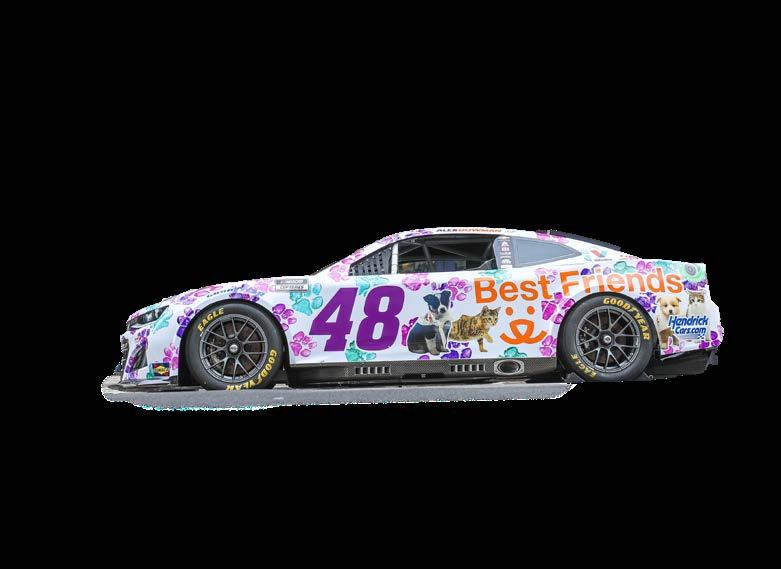
Bowman then took over the No. 48 Chevrolet and won four times during 2021, earning career bests in wins and top-five finishes.
Over the next two seasons, Bowman missed eight combined races due to injury. He suffered a concussion during the 2022 playoffs and flipped a sprint car in April 2023 while racing at 34 Raceway in Iowa, fracturing a vertebra in his lower back.
This year is Bowman’s ninth under the Hendrick banner.
“It hasn’t necessarily flown by,” Bowman said of his time at HMS. “A lot has happened and there have been a lot of different circumstances that we’ve been through. It’s been a lot of fun at the same time to have a stack of wins and a lot of cool memories.”
The sport has evolved considerably over those nine seasons. Drivers now have access to SMT data from every driver in the field, detailing how they get around a given race track. Along with the introduction of the Next Gen car, which has brought the field closer together, being consistent is more of a challenge.
“It has only gotten harder,” Bowman noted. “The Cup Series has gotten closer, guys have gotten better. Everybody has access to the exact same things now, so there’s no advantages anymore. Trying to make sure you’re at 10/10ths every lap. There is no longer give

man says the two crew chiefs are nothing alike.
“Blake (Harris) and Greg (Ives) are vastly different,” he said. “They are both super smart but very different people. It’s been cool adjusting to Blake’s style. We’ve had a lot of fun working together and we get along really well.
“Greg is much more reserved and Blake is not. I think Blake is straight to the point, super passionate. It was a 180 from what I heard on the radio, but I think it’s been a good pairing.”
Bowman missed the 2023 playoffs and was barely above the cutline when the calendar turned to July.
“What I’ve learned is that, even when you’re winning a bunch of races, people are still going to tear you down around here,” Bowman said. “That’s how NASCAR works in the last 10 years. I would rather just fly under the radar and do my thing.”
Away from the track, Bowman also likes to do his own thing. With the help of his primary sponsor Ally, Best Friends Animal Society partnered with the No. 48 team in 2021 to help raise awareness of sheltered animals. Each week, Bowman and Ally combine to donate $4,800 to Best Friends and an affiliated animal shelter in every race market. Nearly four years later, the total is well over $700,000.
“When I started driving the 48, Ally was like, ‘What cause do you want to work with? What things are important to you?’” Bowman recalled. “It was a natural, easy fit and it’s been a lot of fun to do with Best Friends. We’ve raised a crazy amount of money that I never would have thought we would have gotten to at this point.
“It’s been super cool, just knowing that you helped some animals’ lives. There are a lot of shelter animals in the world, and just making a small impact there is awesome.”
Bowman currently has a pair of dogs himself, including a charcoal Labrador retriever named Finn. In June, he adopted a puppy from a golden retriever rescue center in South Carolina and named it Huck. He also parented Roscoe, a rescued beagle mix in 2013, who passed away in August 2023.
“I adopted Roscoe and I don’t know what I was thinking. I had no business adopting a dog; I didn’t have my life together at all,” Bowman said. “I think that’s where (my love for dogs) started for me and it was really cool.”
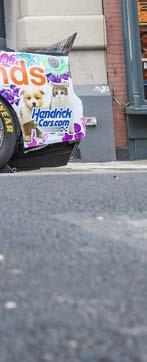

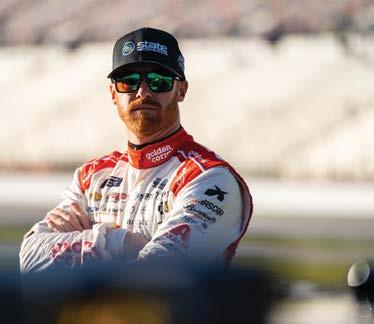

State Water Heaters is excited to partner with Jeb Burton on the race track and the whole Burton family on their outdoor TV show Crossroads with the Burtons. Just like Jeb Burton knows the value of high performing equipment on the track, we know the importance of high performing equipment in your home. Our ProLine® water heaters are designed to provide tough, commercialgrade performance that your family can rely on.
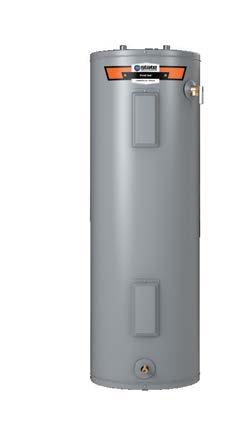
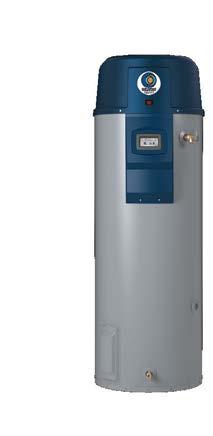


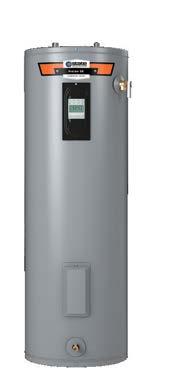
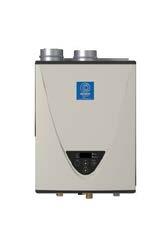
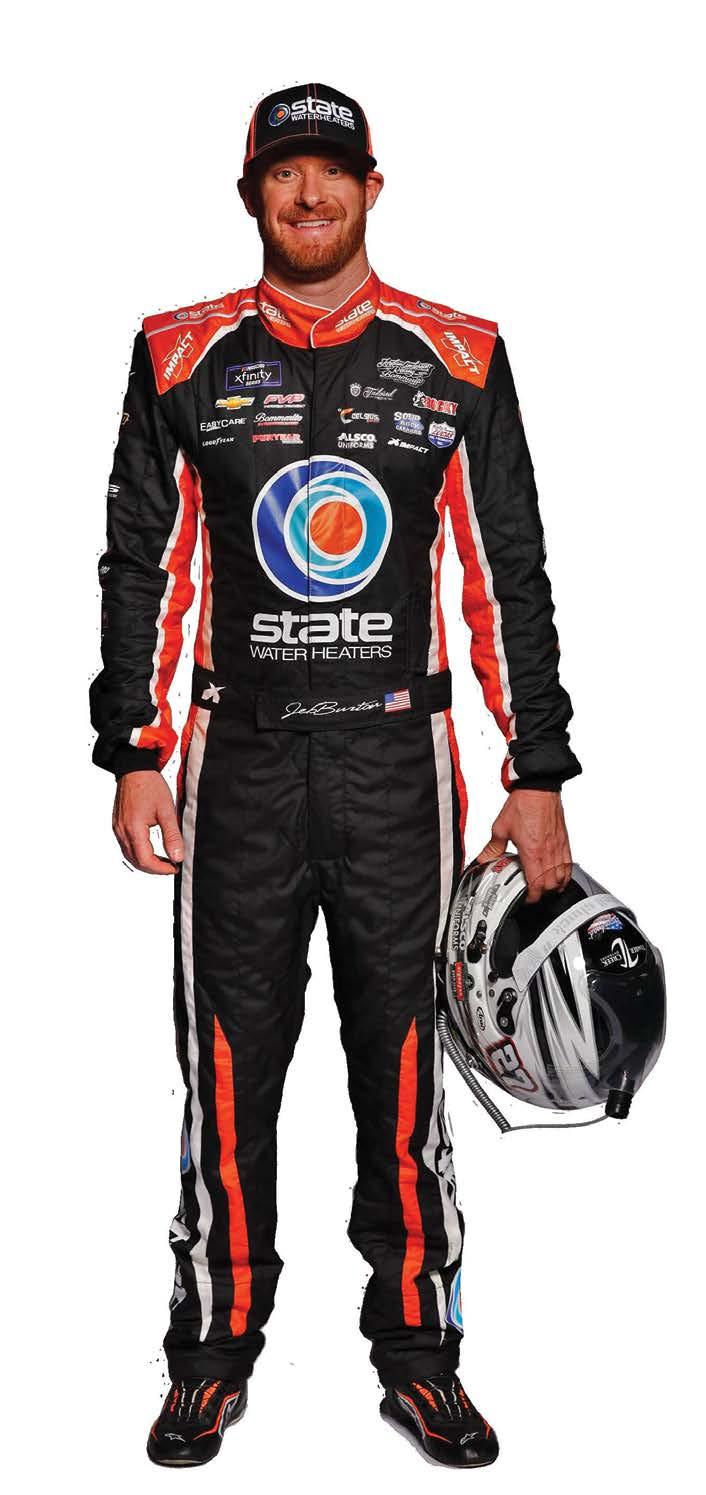


BY JARED TURNER
As a full-time NASCAR Craftsman Truck Series driver for four years and a NASCAR Xfinity Series driver the past two, Austin Hill has faced only one season in which he didn’t win a race.
In fact, in each of the past five seasons, he’s scored multiple victories at his respective level –and that’s continued with this year’s Xfinity Series campaign, which began with Hill snaring back-toback checkered flags over the first two weekends.
Despite all his success, which included a relatively smooth transition from the Craftsman Truck Series to the Xfinity Series in 2022, one huge achievement remains notably absent from the 30-year-old Richard Childress Racing driver’s résumé.
And, he’ll be the first to admit that his failure to check this particular box has become a growing thorn in his side.
“I started running full time in the trucks in 2018, and every year I get all the way to that last playoff round before the Championship 4 and end up missing the Championship 4 by just a couple points – for whatever reason that is,” Hill said
during an exclusive interview with NASCAR Pole Position in early July. “Maybe it’s that those last three race tracks leading up to the Championship 4 race at Phoenix just don’t fit my driving style much, or maybe the cars just weren’t where we needed them to be or we ended up in a wreck and it hurt us points-wise.
“There’s just been a lot of different reasons we haven’t made the Championship 4. So, it would take a lot of weight off my shoulders if I could finally make it.”
How close has Hill come to being able to compete straight up for a championship with three fellow finalists in the season finale?
As a Craftsman Truck Series driver in 2019, he went to Victory Lane four times and finished fifth in points – best among those who didn’t earn the opportunity to battle for a title in Phoenix. The following year, Hill won twice and came home sixth in truck points, again narrowly missing the Championship 4 cutoff. In 2021, he slipped to ninth in the standings but once again collected a pair of truck triumphs.

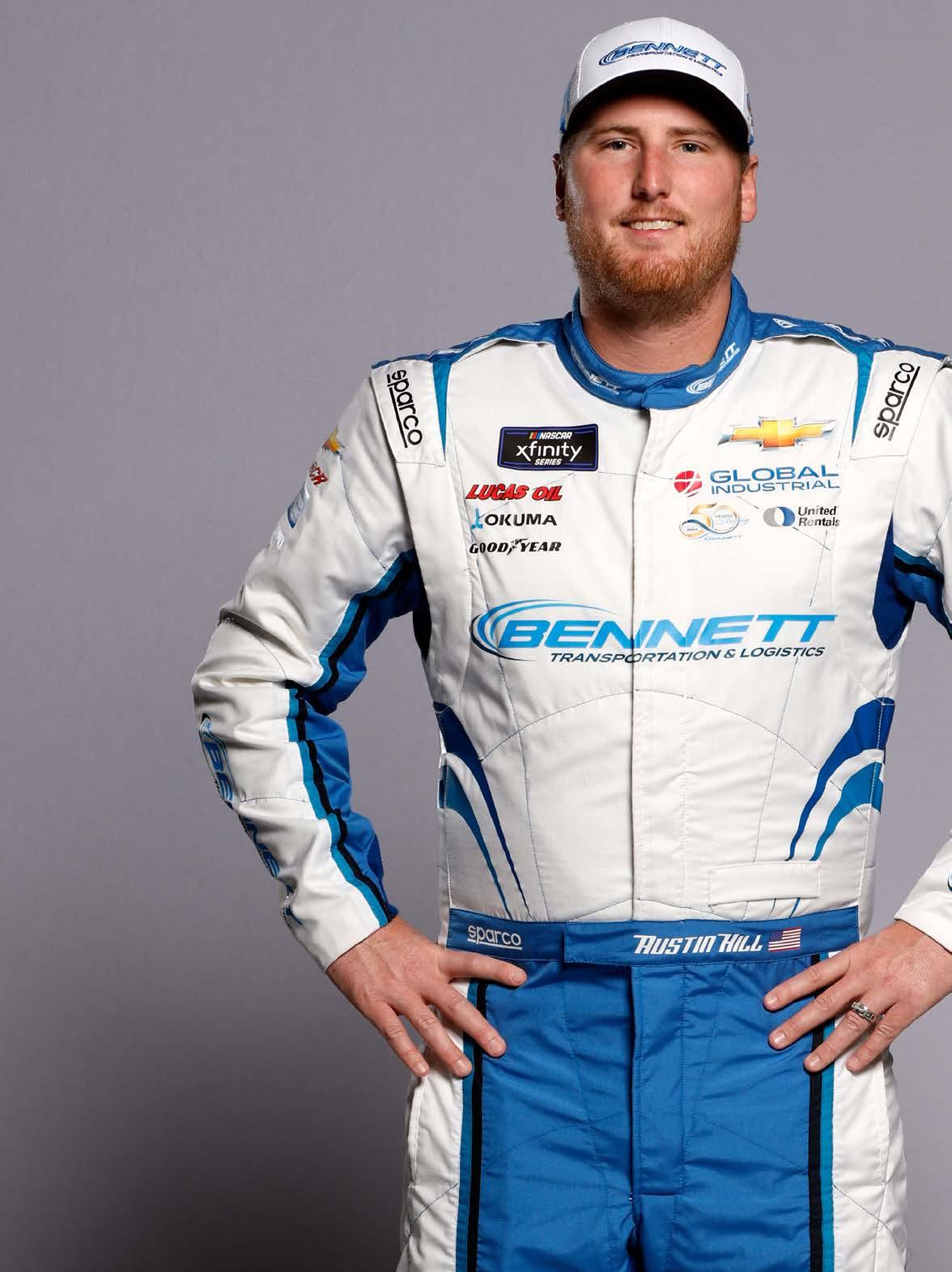
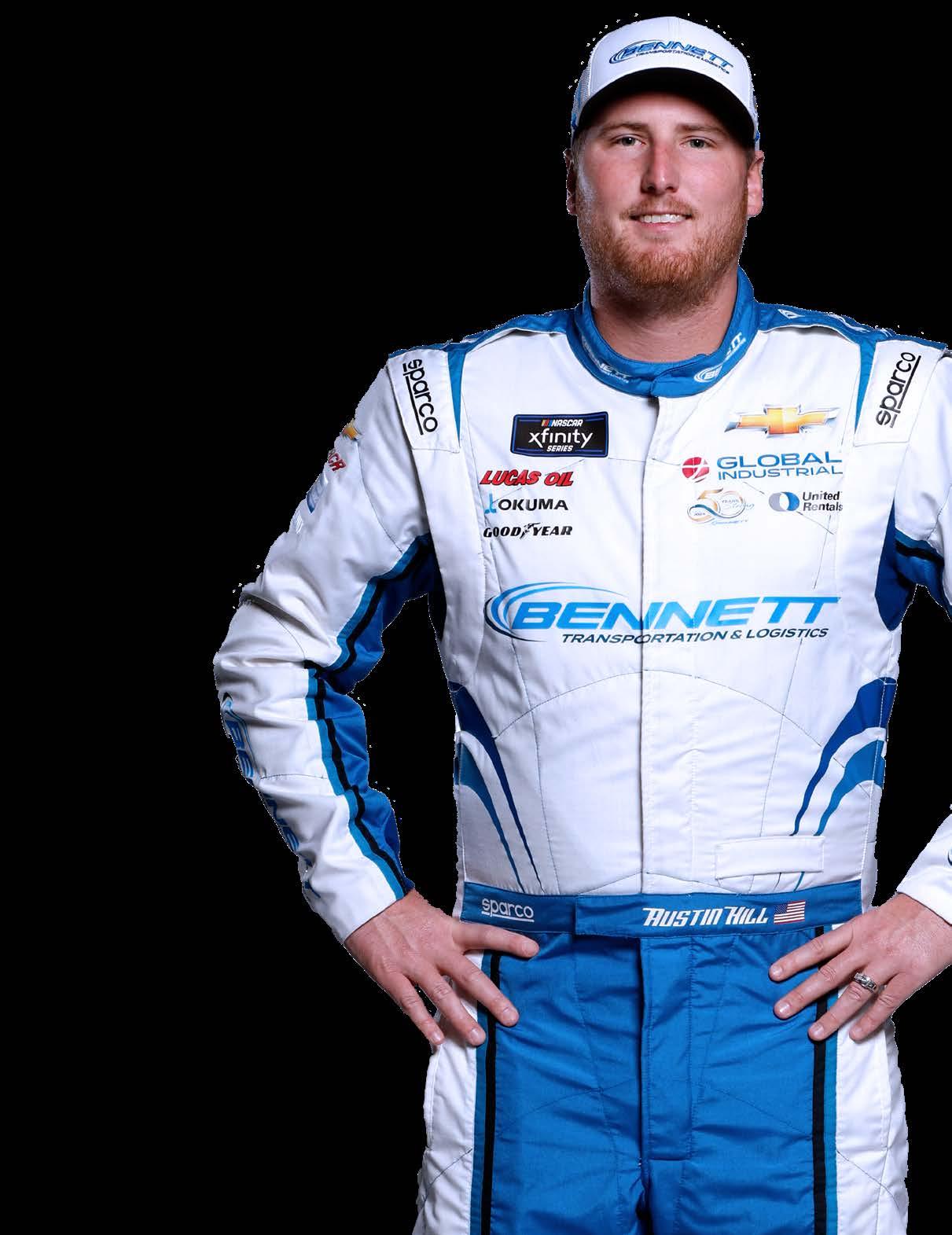



The following year – Hill’s first full year of Xfinity Series competition – he found himself once again knocking on the door of a Championship 4 appearance, finishing sixth in the standings on the strength of two wins as the rookie driver of the No. 21 Richard Childress Racing Chevrolet.
Hill took it up another notch in his sophomore season at RCR, capturing four trophies but again just barely missing the Championship 4 – this time on the way to a fifth-place points finish.
So, Hill’s main objective this season couldn’t be any clearer: He wants to qualify for the Championship 4 and be among the quartet of drivers who arrive at the final race with a chance to leave Phoenix toting some valuable hardware. To actually claim that hardware – a championship trophy – would kind of be the cherry on top for him.
“If I can just have a chance of winning the championship, whatever comes of that, I’m going to be happy with it,” Hill said. “Now if I run second, third or fourth and don’t win the championship, I am going to be disappointed, but at least I can go to sleep at night after the championship weekend and say, ‘Hey, I was there, I had a chance and we gave it all we had, and it just wasn’t enough.’”
Of course, if the final race of the season was to ever be moved to Daytona International Speedway or Atlanta Motor Speedway (both very unlikely possibilities), Hill would be a virtual shoe-in to come out on top.
His record at these two tracks since joining the Xfinity Series full time in 2022 has been nothing less than stellar. How stellar?
Put it this way: As of the midway point of the current season, Hill had recorded a total of eight career Xfinity Series wins. Six of those wins – three at Daytona and three at Atlanta – had come at those two tracks.
So, what’s the secret sauce that’s made Hill virtually unstoppable at these tracks?
“It definitely starts off with having fast race cars,” he said. “I know that Daytona and Talladega and even now Atlanta are kind of an even playing field in a sense, but it still helps having a race car as fast as the ones that I have that RCR, ECR (Earnhardt Childress Racing Technologies, which supplies Hill’s engines) and Chevrolet bring to the track for those type of races.”
Hill doesn’t give his equipment all the credit for his accomplishments at Daytona and Atlanta, however. Race strategy and driving skill augmented by his experience in the sport have certainly had a role to play, too.
“I feel like I’ve done a really good job of trying to place myself in maybe the right position and around guys that I feel like I can trust,” Hill explained. “That doesn’t always work out, but it’s about just trying to be one of the smartest guys on the race track. I think it goes back to just the mental game and being mentally sharp when you go to these races and knowing when to make the move and when not to make the move.”
If the fast superspeedway-style tracks have been Hill’s proverbial bread and butter since joining the Xfinity Series, the short tracks have been the biggest burr in his saddle. To really put this in perspective, consider that as of the midway point of the 2024 season, Hill had never won an Xfinity Series event at a track shorter than 1.5 mile in length.
Is the disparity between Hill’s results at short tracks and larger tracks a mere coincidence, or does it signify a weakness in the driver’s game?
“If you look at the stats and stuff, it’s not like we run well at mile-and-a-halves and we run well at the superspeedways and we don’t run well at the short tracks,” Hill said. “Last year, for example, at Martinsville late in the year we had as good of a chance as anybody to win that race, and it just didn’t work out at the end.
“So, it’s not like we haven’t shown the speed. It’s just when it comes to the end of these short-track races, things get crazy and it gets wild, and sometimes we end up on the short end of the stick. But I feel like, for the most part, that a lot of the races, we’re in the hunt.”
Whether in the hunt to win every weekend or not, Hill prides himself in being a driver who’s willing to wear his emotions on his sleeve and be completely authentic and honest in an era of the sport where many of his peers seem reluctant to ever share their true feelings.
On more than one occasion over the last few years, Hill has engaged in heated run-ins with fellow competitors. Among those who’ve been on the receiving end of some indignation from Hill are reigning NASCAR Xfinity Series champion Cole Custer and Xfinity Series driver Myatt Snider.
“The way I was raised down in Douglasville, Georgia, is you don’t really start any crap, but you definitely finish the crap that gets started. You’re not the one that starts it, but if you’ve got to finish it, you do it,” Hill noted. “I was raised by my parents to always be very straightforward with people, speak your mind and be honest even if my opinion isn’t necessarily the right opinion or maybe it doesn’t trend well with the rest of social media or whatever.
“I’m still going to speak my mind and speak my opinion on how I thought maybe a certain circumstance happened on the race track. Sometimes people don’t like that, which is totally fine with me. I’m not here to please everyone; I’m here to drive a race car and win races.”
And win races Hill has. Already locked into the playoffs, he’s just crossing his fingers that this is finally the year he can go into the final event with an opportunity to race for a title.
“Unfortunately, we’ve had a few bad races in the playoffs,” he said. “That’s kind of hindered us from getting into that Championship 4 and having a shot at the championship in Phoenix.
“Hopefully, this year’s different. I think we have as good of a chance as anybody to make it.”
BY DUSTIN ALBINO
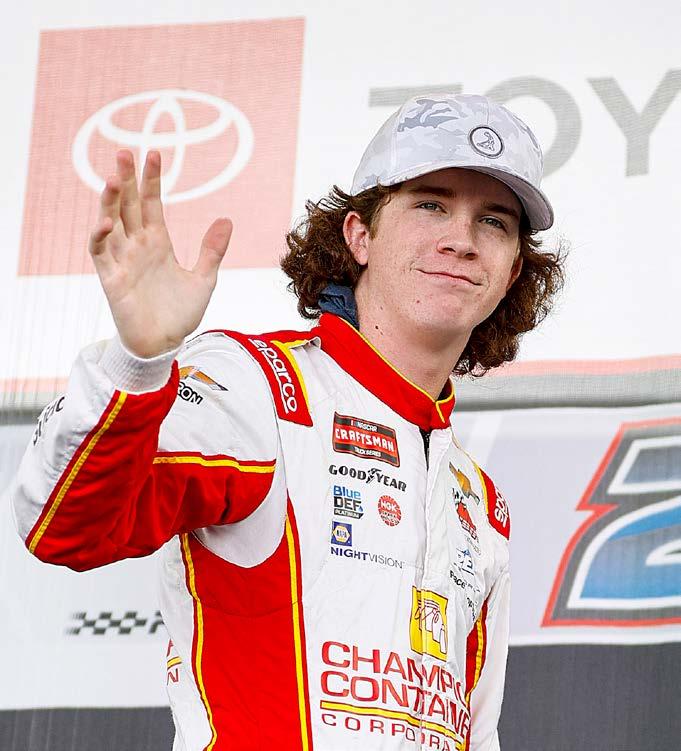
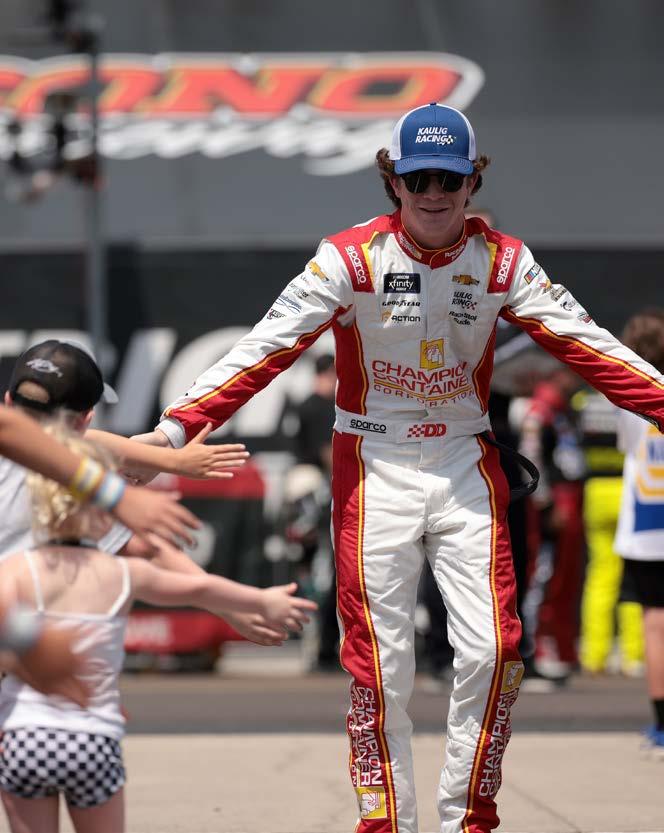
Daniel Dye grew up in DeLand, Florida, a historic community located some 20 miles from Daytona International Speedway. Each February and July, the youngster would attend the track’s NASCAR races with his father, Randy, who was involved in the automobile industry and raced at local short tracks around the state as a hobby.
“As a little kid, when you know what stuff is, seeing pictures of my dad with trophies in Victory Lane, I thought that was the coolest thing in the world,” Dye recalled. “The first thing that I ever wanted to be – when my stepmom asked me – I said, ‘A race car driver and a dad.’ I wanted to be exactly what my dad was.”
The younger Dye’s driving career started in Quarter Midgets at age 8 and he graduated to Late Model competition when he was 14. He made his ARCA Menards Series East debut two years later, driving a car owned by former driver and NASCAR executive Ben Kennedy.
Midway through the 2021 season, Dye jumped to GMS Racing. In addition to his Late Model schedule, he ran six ARCA Menards Series races, winning his second time out at Berlin Raceway in Michigan.
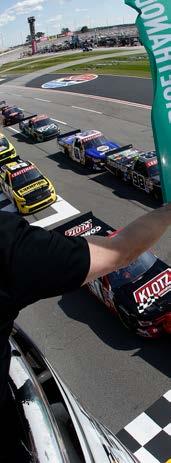


“I loved running for Ben’s team,” Dye said. “It was cool being able to run out of his shop; it was only 30 minutes from the house and I had a lot of fun.
“When Raphael Lessard ended up getting out of that truck (in 2021), GMS moved Jack (Wood) to the truck and now the 21 car for ARCA is open. My manager (Kevin Striegle) was friends with Mike Beam and Mike said, ‘Daniel has been doing a good job,’ and he talked to me a couple of times at the race track, just watching and knew the kind of equipment that I was in.
“I tested the GMS Late Model stock, and we went and finished sixth. Then, we went to Elko with the ARCA car and finished seventh, and then went to Berlin and spanked them.”
By joining GMS, an established team that raced in multiple series, Dye’s immediate future became clearer. He ran the full ARCA Menards Series schedule in 2022, tallying 17 top-10 finishes en route to a runner-up result in the championship standings to Nick Sanchez.
GMS officials promoted Dye to the Truck Series for the 2023 season.
“I feel like I had a lot of confidence going in, but I had a crew chief who wasn’t experienced and was put in a position where he had to try to be a crew chief,” Dye recalled. “I don’t think he was ready for that. We were always in a bad spot together. Once we made the switch to Blake Bainbridge, we came alive a little better.”
Compared to the ARCA Menards Series, where only a handful of cars can win, the Truck Series field is much deeper with a dozen competitors capable of visiting Victory Lane.
“The competition level was not even close,” Dye said. “The cars were similar, a lot of downforce. You could air out the trucks a little bit more and drive them a little bit harder and get away with it. The competition level was a whole different ballgame.”
In late August of last year, while Grant Enfinger was in a Championship 4 run, GMS officials announced they were shuttering the Truck Series operation at the end of the season. The decision was made to focus on Legacy Motor Club, the Cup Series team in which GMS’ Maury Gallagher is also an owner.
“(GMS) still gave Grant a chance to go chase that championship and that was cool for him,” Dye said. “They kept the foot down there. Rajah (Caruth) had a couple of good runs too and he had a complete team.
“My crew chief was doing a lot of the hands-on stuff and didn’t have time to be a crew chief. He had to be a little bit of a babysitter and do the rest of what a race team needs.”
Just over a month after the GMS announcement, Dye revealed he would join McAnally-Hilgemann Racing for the 2024 season. He’d be teamed with Christian Eckes, who won a series-high four races during the 2023 season. The operation also added veteran Tyler Ankrum and a rotating cast of drivers, including 2022 series champion Zane Smith, to wheel a fourth truck.
In late June at Nashville Superspeedway, Dye earned his first career top-five finish, as the No. 43 truck was next in class to Eckes, who led all 150 laps.
“It wasn’t much of a decision. I think it was super simple,” Dye said of his move to McAnally-Hilgemann Racing. “These guys won four races last year with that technical alliance with GMS, and they would outrun us a lot of weeks.”
Now a consistent top-10 threat, the 20-year-old Dye was in contention for a playoff spot after 13 of the 23 series races.
“My mindset is completely different,” he said. “Last year, I expected things to come to me and that’s not how life works. You’ve got to go get what you want. I want to win races and be a good race car driver. To do that, I’ve got to work my butt off in the gym, work my butt off at home looking at SMT data and watching races back and looking for the right things.
“I know that any day now I can win a race in the Truck Series. I know if you give me a truck that can restart in the first two rows late in a race, I’m going to give myself a pretty good shot of putting that thing in Victory Lane. That’s all of MHR, I think. If you put any of us up there, we’re going to have a shot.
“Last year, my confidence level was depleted and now I feel great physically, mentally. I don’t care a whole lot about what anybody says. Last year, I would worry about comments and all that, but who cares? I’m here racing for me; I’m not racing for JoeSmoe123 on Instagram saying, ‘He sucks.’ It’s because he’s played NASCAR Heat and won three races in a row on rookie mode. I don’t care about comments anymore.”
Dye earned his first pole at Atlanta Motor Speedway in the second race of the season. He’s run up front in a handful of events, and now it’s a case of putting a full race together.
“I know that I don’t suck and I know that I’ve got what it takes to win races at the highest level,” Dye noted. “I’ve just got to break through, get some of that experience and get some more seat time so that when I get into a position to win a race, I know what to do. I think I’ve got the speed; I just have to make sure I make the right decisions when the opportunity presents itself.”






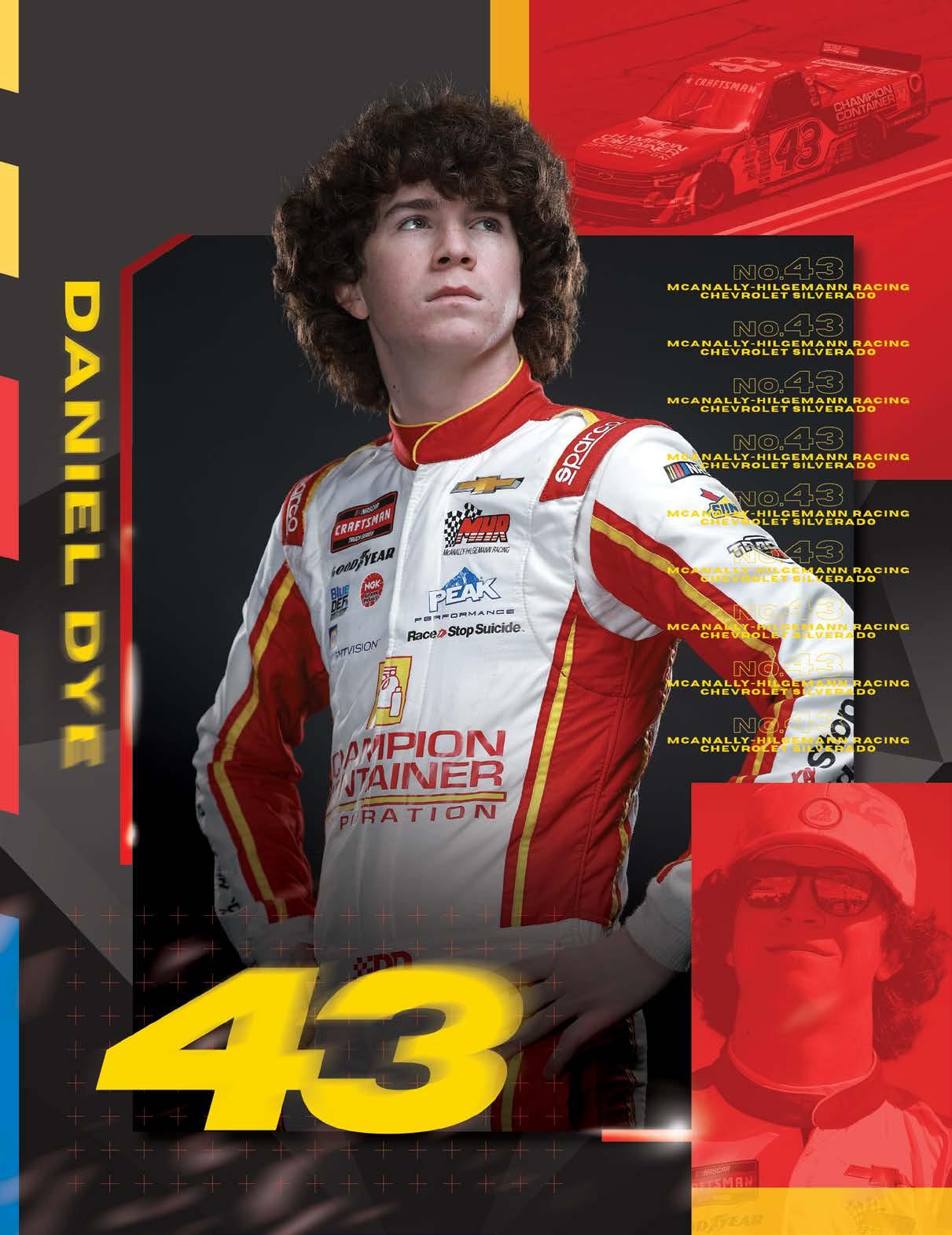
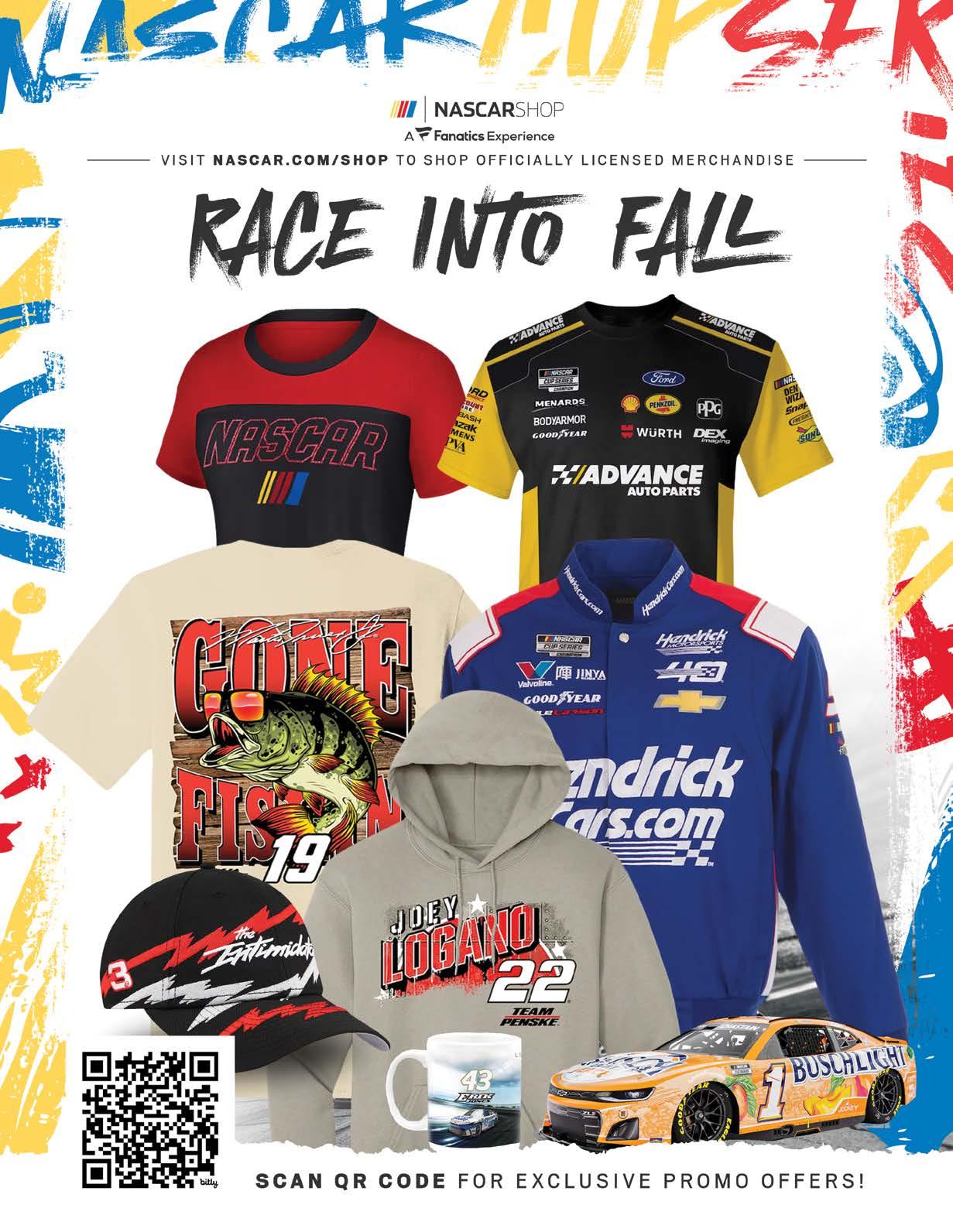
FOLLOWING THE SUCCESS OF the mega-popular Slime Licker®, Candy Dynamics is excited to announce the release of its new Slime Licker® Squeeze! With the same delicious tartness as the original Slime Licker® line, the Slime Licker® Squeeze™ brings a new consistency. Unlike their namesake, the 70g Slime Licker® Squeeze™ comes in three flavors: Blue Razz, Cherry and Green Apple. Each display contains 6 Blue Razz, 3 Cherry and 3 Green Apple tubes.

Sour candy lovers will love the way the Slime Licker® Squeeze™ paints their tongue and parents will be happy to see the colorful smiles coming from their kids!
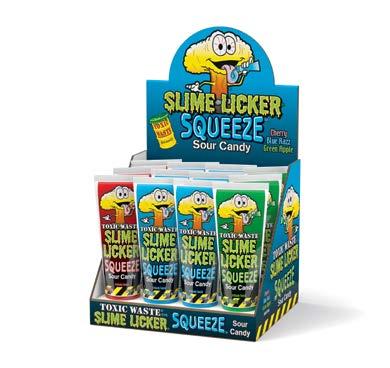
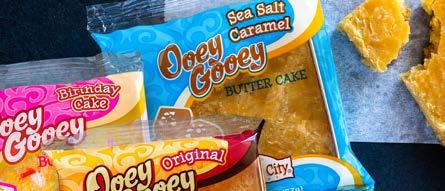
OOEY GOOEY BUTTER CAKES ARE A MUST-TRY FOR ANYONE WITH A sweet tooth. Whether enjoyed as a pre-race treat or as a post-race reward, Ooey Gooey Butter Cakes are the perfect way to satisfy your cravings. Originating in St. Louis, the bottom layer is a delicious buttery yellow cake, while the top layer is a rich mixture of cream cheese, sugar, and egg. With eight different flavors available, there’s something for everyone to enjoy.
So why not treat yourself to the deliciousness of an Ooey Gooey Butter Cake? Head to your local convenience store and grab a stack for race day – keep them for yourself or share with your racing friends.
WWW.PCBAKERY.COM

THE EXECUTIVE SERIES 8220LP TILT TANDEM AXLE TRAILER IS PERFECT FOR HAULING YOUR CLASSIC CAR! THE 8200LP PROVIDES PLENTY OF room with an 81” x 246” bed. A 40-inch axle spread and removable fenders help protect your classic car or truck. Executive Series trailers from Aluma have great features such as longer ramps for better loading angles. Plus, the trailers look great with black aluminum wheels. The Executive Series 8200LP trailer also features an LED GLO lighting package, cargo storage box and much more. Aluma offers the most complete aluminum utility and recreational trailer line available, including utility trailers, ATV trailers, car haulers, motorcycle and snowmobile trailers and more. Aluma trailers are built in the USA and sold through a nationwide network of dealers.
LEARN MORE AT WWW.ALUMAKLM.COM
K-Seal is a multi-purpose, one step, permanent coolant leak repair with more than 10 million bottles sold worldwide to date. It permanently seals leaks in the head gasket, block, radiator, heater core, freeze plug and water-pump casing.
Trusted by professional mechan ics, technicians and motorists alike, K-Seal is suitable for use with all water-cooled engines, including cars, motorcycles, commercial ve hicles and heavy machinery.
No need to drain or flush the sys tem or worry about what type of an tifreeze is in the cooling system; just shake, pour and get back on the road!
LEARN MORE AT KSEAL.COM
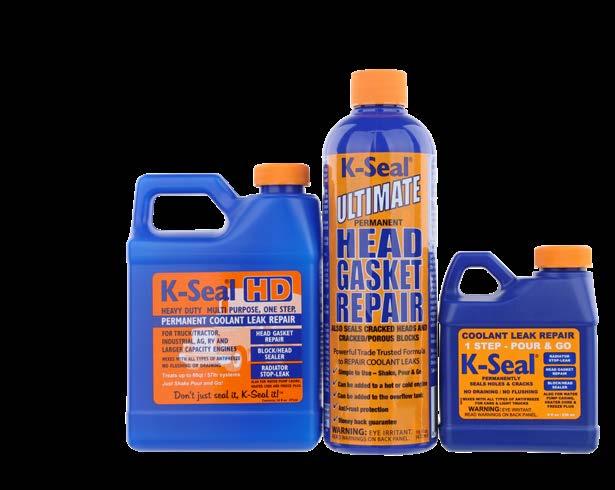
The Across the Board

NASCAR Car Racing Game will have your adrenaline pumping as your race car makes its way around a beautifully handcrafted oval race track!
To play the NASCAR Car Racing Game, line up the race cars at the starting gate, deal the cards and begin rolling the dice to disqualify your cars and start building your “pot.” The remaining cars race to the finish line. Hold the winning car’s card and you win!
LEARN MORE AT SHOP.ATBGAME.COM
WANNA GO FAST? THE XPEDITION EBIKE WILL LECTRIFY THE WAY YOU GET AROUND.
THE LECTRIC XPEDITION IS OUR MOST CAPABLE EBIKE TO date. This cargo eBike was designed to be the ultimate transportation solution, allowing riders to tackle even the most daunting of hills while holding up to 450 pounds.
The XPedition is perfect for a wide variety of riders providing power to cover 150 miles on a single charge. Our all-new Lectric PWR™ programming paired with a 1,310W peak motor, dualbattery and twist throttle makes for a truly robust and enjoyable riding experience. Whatever your transportation needs, the Lectric XPedition is ready to take on the experience with you!

THIS IS JOE’S ALL-PURPOSE Hand Cleaner, and it’s the cleaner you should have in your shop or garage. This industrial-strength waterless hand cleaner removes some of the toughest grease, grime and oils from your skin. It contains lanolin and petroleum jelly to help combat the drying and cracking effects from the overuse of water, and its gentle formula means you can use it multiple times a day. Just apply it to dry skin and then wipe it off with a cloth or towel. With its pleasant banana smell, you’ll be amazed at the way your hands look and feel after use: clean, conditioned, and without the greasy or dry feeling associated with most hand cleaners. CHECK




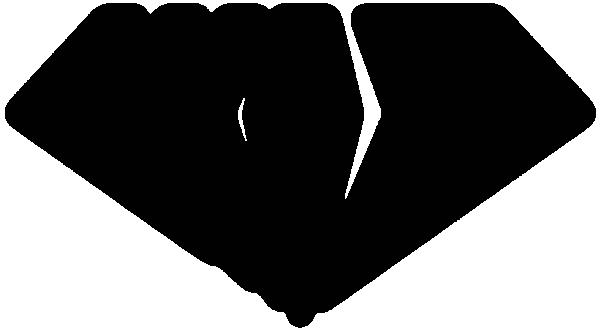
































































A sawmiller by trade, Glen Wood had no idea what was in store when he built his first race car in 1950 on the grounds of the family homestead in the mountain valley community of Buffalo Ridge, Virginia.
Born just down the road in Stuart, Virginia, on July 18, 1925, Wood became one of NASCAR’s most accomplished and beloved drivers and team owners prior to his death on Jan. 18, 2019.
Wood’s early efforts culminated in the formation of a NASCAR Cup Series team that has fielded cars for many of the sport’s most legendary names. Wood Brothers Racing has won 99 races and an owners’ championship in NASCAR’s premier division, and withstood the test of time.
How much time?
With second-generation driver Harrison Burton at the wheel of the No. 21 Ford this season, the Wood Brothers organization is entering its 75th season of continuous competition at NASCAR’s highest level.
But the first driver to hop in the No. 21 car was Glen Wood himself, who made 62 starts over 11 seasons as a part-time Cup Series competitor. But the 2012 NASCAR Hall of Fame inductee made the most of his relatively little time behind the wheel, winning four races, capturing 14 poles and finishing in the top 10 in more than half of the NASCAR premier series events he entered between 1953 and 1964.
Not all of Wood’s racing adventures took place in NASCAR’s headline division, however.

That first car Wood built was a dirt Modified that he raced locally, with his first start coming at Morris Speedway just outside of Martinsville, Virginia. Wood’s chief mechanic in those days was younger sibling and fellow future NASCAR Hall of Famer Leonard Wood. Together with Leonard and help from fellow siblings Ray Lee, Delano and Clay Wood, Glen captured the North Carolina Sportsman championship in 1954 and came home third in the NASCAR Convertible division points in 1957.
Then, in 1959, the affable Virginian was named NASCAR’s Most Popular Driver. The following year, he scored three victories in NASCAR’s premier series, taking the checkered flag first in each race at historic Bowman Gray Stadium in Winston-Salem, North Carolina. He recorded his final triumph – also at Bowman-Gray – in 1963 and made his last start the following year at Starkey Speedway in Roanoke, Virginia.
THIS IS NOT JUST ABOUT ME BEING INDUCTED IN THE HALL OF FAME. IT’S ALSO ABOUT THE WOOD BROTHERS. AND IT’S ABOUT NASCAR, AND I’M PROUD TO HAVE BEEN A NASCAR DRIVER AND CAR OWNER FOR THE PAST 60 YEARS, AND I’M PROUD OF THIS GREAT HONOR.
WOOD’S BEST SEASON AS A DRIVER was 1960 when he not only won three races but earned seven top-10 finishes –including six top-five runs – in only nine NASCAR Cup Series starts. That same year, Wood also grabbed four poles and led 766 of the 2,206 laps he completed in his family-owned car.
ENTERING ITS 75TH YEAR OF competition, Wood Brothers Racing carries the distinction of being NASCAR’s longest continuously operating team. Glen Wood, of course, was the visionary behind it all and the team’s first driver. Although Glen died in 2019, the Wood family continues to field their fabled No. 21 Ford.
WOOD IS WIDELY CONSIDERED ONE of NASCAR’s greatest innovators, having built his first race car under a beech tree at the family’s Virginia home seven-and-ahalf decades ago. Although the car burned up on the way home after his first race, Wood was able to repair it and returned to racing within three weeks.
Although he only raced three seasons in what is now the NASCAR Xfinity Series, the late Sam Ard is widely regarded as one of the division’s all-time greats.
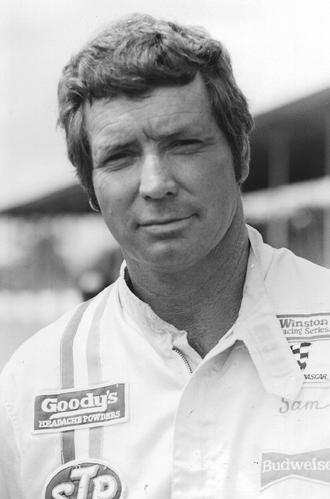
Born on Valentine’s Day in 1939, Ard was a big man with hands that seemed the size of garbage-can lids. Still, he was known as much for his typically calm demeanor outside his car as he was for his ferocity once behind the wheel.
Ard served a stint in the United States Air Force before turning his attention to racing full time. Having already established himself as a force to be reckoned with, Ard kept right on winning once what is now the NASCAR Xfinity Series was established in 1982.
Rival Jack Ingram edged Ard for the 1982 title by only 47 points. The following year, in 1983, Ard put together one of the most dominant seasons in the number-two national division’s history. He won four straight races late in the year, culminating in a victory over Dale Earnhardt at Charlotte.
Ingram was able to break the streak at Hickory, with Ard right behind in second place. Then, in the season finale, Ard won yet again to seal an 87-point margin of victory over Ingram in the championship standings.
Ard picked right up in 1984 where he’d left off the year before. He was this close to victory at Daytona when a clogged fuel filter killed power and dropped him to fourth in the final rundown. It was one of Ard’s few disappointments in 1984 until Rockingham, in the next-to-last race of the campaign, when he sustained career-ending head injuries in an early accident.
After a handful of seasons as a car owner for drivers such as Jimmy Hensley and Jeff Burton, Ard retired quietly to his home in Pamplico, South Carolina. He was inducted into the National Motorsports Press Association Hall of Fame in 1999.
He died on April 2, 2017, after a lengthy battle with Alzheimer’s.
I NEVER TOOK ANY TIME TO KNOW HOW MANY RECORDS I HAD SET OR ANYTHING LIKE THAT, BECAUSE ALL I DID WAS RACE. WHEN I WENT THERE TO RACE, I WENT THERE TO WIN. I DIDN’T
GO THERE FOR SECOND OR THIRD OR NOTHING LIKE THAT.
VERSATILE
BEST SEASON
ALTHOUGH HE WON two fewer races than the year before, Sam Ard’s eight-win 1984 campaign was one for the ages. Despite missing the season finale due to a career-ending injury, Ard nevertheless captured the championship by an astounding 426 points over runner-up Jack Ingram.
THE NO. 00 CAR RECORD-SETTER ARD WAS COMPETITIVE on basically any type of race track –superspeedways, intermediates and short tracks. Combine that with an extraordinary amount of physical toughness, and Ard was The Man.
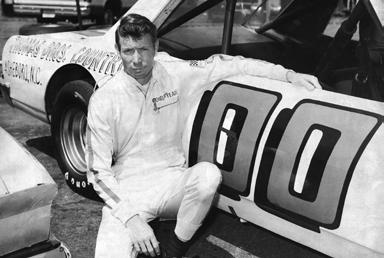
KNOWN FOR “(ARD’S) THEORY WAS that if you win every race, you ain’t gotta worry about points.” – Sam Ard’s crew chief, Gere Kennon
Along with David Pearson and Bud Moore, driver-turned-car owner Cotton Owens made up one-third of a triumvirate of NASCAR legends who based their operations in and around Spartanburg, South Carolina.
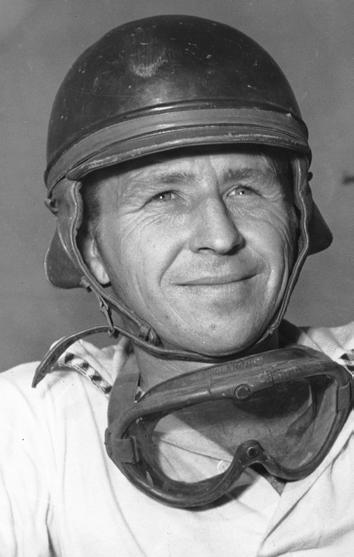
Born May 21, 1924, Everett “Cotton” Owens would’ve loved to have seen the sight of grandson Kyle Owens standing before the crowded ballroom.
Kyle’s job that night was to induct his grandfather into the NASCAR Hall of Fame’s 2013 class. How do you talk about a loved one in front of the sport’s elite? That’s easy. Just speak from the heart.
“This is a biased opinion, but in our family’s book, there was no greater racer than Cotton Owens,” Kyle said during his remarks. “My grandfather was one of the most humble, most loyal, hardest workingmen I’ve ever met. He took great pride in the fact that he could build a race car from the ground up, the engine, chassis, transmission, didn’t matter.
“You name it, he could build it, then he could drive it to the track and drive it at the track straight to Victory Lane. There’s not a whole lot of people that can say that. He was a wizard, truly, turning wrenches and behind the wheel.”
David Pearson was there that night as well. Pearson won the first of his three NASCAR championships in 1966 while driving for Owens, and despite parting ways midway through the following season, they remained friends for the rest of their lives.
Pearson, who was almost as legendary for his reticence as his astounding skill behind the wheel of a race car, spoke as well that grand night.
“(Cotton Owens) was not only a good guy to drive for but he was a good guy, he was a friend, and one of the best friends I guess I had as far as running with,” Pearson said. “Every Sunday after church I’d go by and pick him up and take him and his daughter out to eat, and it’s been that way for years, I guess. Everybody thought when we split up we would be mad at each other or something, but we were both happy.”
Owens died on June 7, 2012, about a year before his enshrinement.
POP LIVED HIS LIFE BY FOUR UNWAVERING PRINCIPLES THAT HE HELPED SAVOR … AND THAT WAS GOD, FAMILY, COUNTRY AND THE 426 HEMI.
- KYLE OWENS, AT HIS GRANDFATHER COTTON OWENS’ FUNERAL
DURING THE 1959 campaign, Owens made a visit to Victory Lane in what is now known as the NASCAR Cup Series. He scored a total of 22 top-10 finishes in 37 starts and finished second to fellow future NASCAR Hall of Famer Lee Petty in the championship standings.
FOLLOWING HIS WARTIME service in the United States Navy, Owens won more than 100 NASCAR Modified races during the 1950s. He then turned his attentions to what is now the NASCAR Cup Series, where he captured at least one victory in six consecutive seasons – 1957 - 1962.
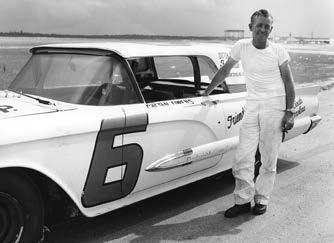
KNOWN FOR OWENS WAS A TALENTED driver. Of that, there can be absolutely no doubt whatsoever. As a team owner, Owens’ cars were driven by NASCAR Hall of Famers such as David Pearson, Buddy Baker, Ralph Earnhardt, Bobby Isaac, Junior Johnson, Benny Parsons and Fireball Roberts.
One of three Bodine brothers who left their mark on NASCAR, Geoff Bodine – older than siblings Brett and Todd – was by all measures the most successful of the trio, at least on the NASCAR Cup Series side.
Born in Elmira, New York, on April 18, 1949, Geoff Bodine began racing micro-midgets in 1955 and later achieved great success on the Modified Tour, finishing second in the 1977 national standings.
Bodine made his NASCAR Cup Series debut two years later with a three-race slate, but it wasn’t until 1984 that he ran his first full season.
His team that year? All-Star Racing, which later became Hendrick Motorsports. With legendary crew chief Harry Hyde calling the shots on his No. 5 Chevrolet, Bodine earned three Cup Series victories before his run with team owner Rick Hendrick concluded at the end of the 1989 season. That’s when he left to drive for an already legendary team owner in Junior Johnson.
After a terrific first year with Johnson’s team that saw him set career highs in multiple statistical categories, Bodine never again finished in the top five or even the top 10 of the Cup Series standings, but he continued to win races on occasion and went to Victory Lane three times in 1994 with his own team – the former Alan Kulwicki Racing – that he bought in May of the previous year.

Bodine’s 18th and final visit to a Cup Series Winner’s Circle came in August 1996 and, in most appropriate fashion, at Watkins Glen International — the 2.45-mile road course in upstate New York not all that far from where he grew up.
After retiring from full-time Cup Series racing at the end of the 1999 season, Bodine planned to compete in select NASCAR Craftsman Truck Series races.
However, he entered only one race — the 2000 season opener at Daytona, where he was caught up in the most vicious crash of his lengthy racing career. Bodine, whose truck landed upside down and on fire after going airborne and being struck multiple times at roughly 180 mph, was knocked unconscious but somehow survived.
“I wasn’t breathing when (the safety workers) came to me,” Bodine said during a March 2022 edition of the Dale Jr. Download podcast. “They undid my seatbelt and I started breathing, they said. … I’m very blessed to be alive.”
AT FIRST, THE OTHER TEAMS, DRIVERS AND CREW CHIEFS THOUGHT, ‘WELL, BODINE NEEDS POWER STEERING. HE’S JUST A LITTLE GUY. HE DOESN’T HAVE ANY MUSCLE TO DRIVE THESE BIG CARS WITHOUT POWER STEERING.’ SO, THEY KIND OF GAVE ME THE ‘WIMP SYNDROME.’
DRIVING JUNIOR
Johnson’s No. 11 Ford, Bodine went to Victory Lane three times in 1990 and finished what would be a careerbest third in the NASCAR Cup Series standings. In the process, he recorded 11 topfive results and 19 top-10 finishes, both of which were career bests.
BODINE SET THE qualifying track record – a mark that still stands – at Atlanta Motor Speedway in November 1997 with a lap at 197.478 mph on a freshly repaved and newly designed track. Previously, AMS featured a true oval configuration, but it was converted to a quad-oval layout during the summer of 1997.
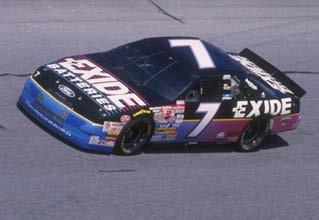
KNOWN FOR BODINE INTRODUCED power steering to NASCAR’s premier series in 1982.
Although some of his competitors were initially skeptical, power steering became a standard component.
“I’m kind of proud of that,” Bodine said. “It’s something I brought into the sport, and it’s really extended the career of a lot of drivers.”
Equal parts triumph and tragedy was the NASCAR career of the late Neil Bonnett, a friend of many and beloved driver who passed away on Feb. 11, 1994, from injuries suffered in a crash at Daytona International Speedway.
Born on July 30, 1946, in Bessemer, Alabama, Bonnett learned under the tutelage of 1983 Cup Series champion Bobby Allison – a racing legend who took Bonnett under his proverbial wing.
“Bobby really opened the door for me,” said Bonnett, who worked on Allison’s cars during his days as an aspiring Cup Series driver. “He gave me stuff that made me a winner.”
Bonnett made his NASCAR premier series debut on May 5, 1974, and went on to make 362 starts over 20 years. Along the way, Bonnett – who drove for the Wood Brothers and team owner Junior Johnson, among others – posted 18 wins that included victories at the some of the sport’s most fabled tracks. There were plenty of races, including the Daytona 500, that Bonnett didn’t win, however.
“I think the hardest thing in this sport is not to let losing whip you,” Bonnett once said.
Unfortunately, Bonnett’s career was marred by bad accidents, the first of which came at Darlington in the fifth race of the 1990 season. Bonnett suffered memory loss and was unable to identify some of his closest friends and loved ones for a period of time thereafter.
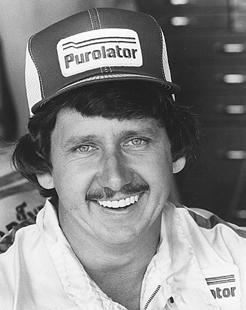
Eventually, Bonnett began regaining his memory and, once fully recovered, started his own TV show, “Winners,” in April 1991. Bonnett, who recorded the 30-minute weekly motorsports program out of his home, also spent time behind the microphone for live race broadcasts, which further endeared the already popular driver to fans. Being back at the track only fueled Bonnett’s desire to return to competition, though, and with help from close friend Dale Earnhardt and Earnhardt’s team at Richard Childress Racing, Bonnett did return on July 25, 1993, at Talladega but was caught up in a multicar crash that sent his car upside down, airborne and into a catchfence. Bonnett walked away uninjured and entered one more race for RCR that season before making plans to run a handful of races in 1994, beginning with the Daytona 500. That never happened, though, due to Bonnett’s death in practice at Daytona just days before the official start of the season.
WINNING IS PROBABLY ONE OF THE WORST THINGS THAT EVER HAPPENS TO A RACE CAR DRIVER. IT’S THE WORST AND THE BEST THING. ONCE YOU START WINNING, YOU CAN’T BE SATISFIED WITH ANYTHING LESS. I PUT OUT A WINNING EFFORT EVERY SUNDAY, AND WHEN I DON’T WIN, I’M MAD – AT NEIL BONNETT.
THE 1985 SEASON wasn’t Bonnett’s winningest effort at NASCAR’s highest level, and neither was it the season where he recorded a career-high in laps led. But taken altogether, ’85 was his best Cup Series effort. Bonnett won twice, finished a career-best fourth in points and posted 18 top-10 finishes.
DESPITE RUNNING ONLY
four full seasons over a 20-year career in NASCAR’s premier series, Bonnett posted 18 wins and 20 poles – both impressive numbers for a driver who made limited starts. Had Bonnett been able to go racing more often, it’s hard to imagine how many wins and, perhaps, championships he might’ve collected.

KNOWN FOR
AMONG OTHER THINGS, Bonnett is known for pulling close friend and longtime racer Red Farmer from the wreckage of a helicopter that crashed in the Talladega Superspeedway infield in July 1993. Bonnett also tried to pull the pilot, Cup Series driver Davey Allison, from the wreckage but was unsuccessful.
Along with Sam Ard, Jack Ingram was one of the two greatest drivers in the earliest years of what is now the NASCAR Xfinity Series.
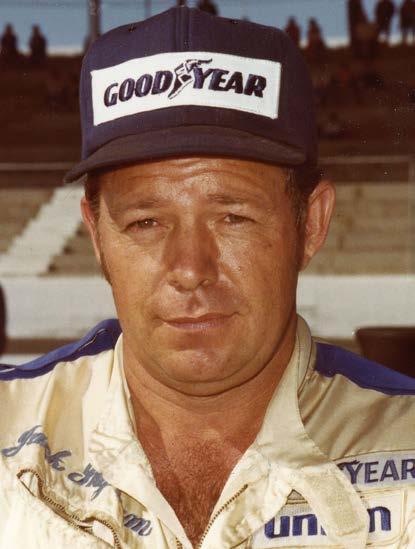
Born on Dec. 28, 1926, Ingram was a proud man.
The easiest way to get Ingram going was to hint that his career started in 1982, the first year of what is now the NASCAR Xfinity Series. Not so, he’d insist in no uncertain terms whatsoever.
The resident of Asheville, North Carolina, had been racing for years before then with countless wins and three national championships in NASCAR Late Model Sportsman competition. But once the division was reorganized in 1982, those records no longer counted – and Ingram didn’t like it one little bit.
He and Sam Ard were fierce – but friendly enough – rivals during the 1982, ’83 and ’84 seasons. Ingram captured the first and Ard the second and third championships in the new division’s history, although Ard missed the final race of the 1984 season due to a career-ending accident.
“I didn’t want to win a championship, races or anything in the future without Sam Ard, but that’s the way it ended up being,” Ingram said years later.
Of course, Ingram was notable for more than just his rivalry with Ard. In 1984, he became one of the first drivers in the series to be backed by a national, corporate sponsor when U.S. Tobacco’s famous Skoal brand came on board.
Ingram went on to a second title in 1985 and was atop the standings when he was suspended for two late-season races for his involvement in a controversial skirmish during a Late Model Stock event in his hometown of Asheville, North Carolina.
He got fired up about that one, too, right up until his final days. Ingram died June 25, 2021.
No one could compete with me as a driver. I was so good on the race tracks we were going to. When I went to South Boston, Orange County, Hickory or wherever, it was a ‘gimme’ almost because Sam wasn’t around.
BEST SEASON
KNOWN BEST AS A short-track ace, Jack Ingram also won a 1975 NASCAR Late Model Sportsman event at Daytona International Speedway.
Series.
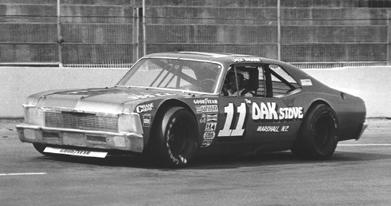
KNOWN FOR INGRAM CAPTURED three consecutive championships (1972, ’73 and ’74) in the NASCAR Late Model Sportsman Series, the precursor to what is now the NASCAR Xfinity Series.
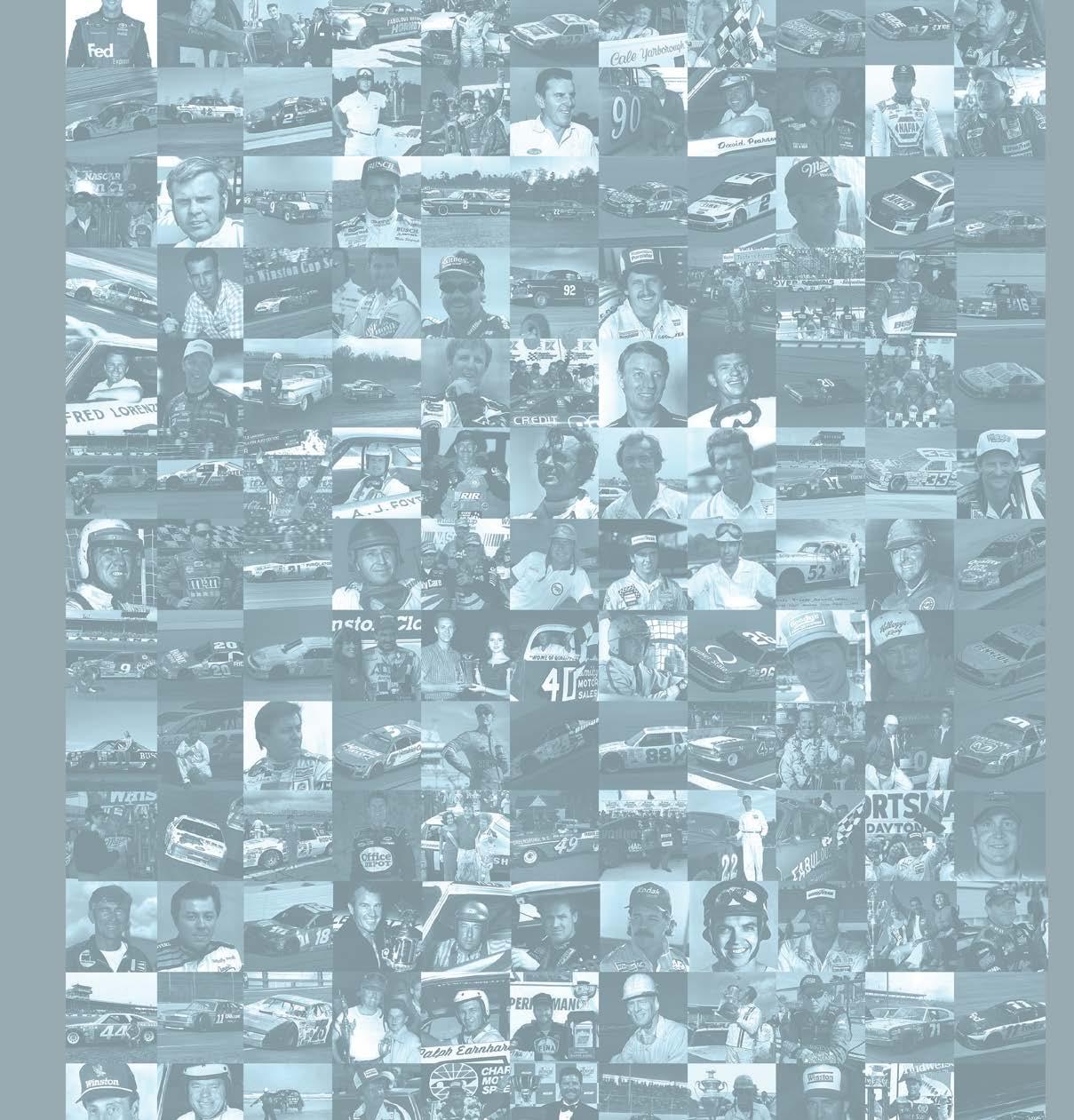

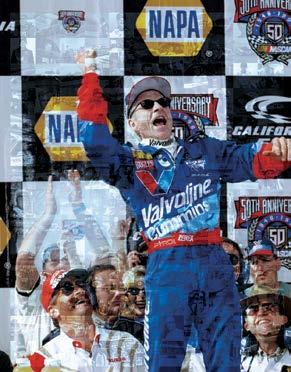
Driving the No. 27 Blue Max Racing Pontiac owned by drag racer Raymond Beadle, short-track sensation Rusty Wallace claimed six victories as he edged Dale Earnhardt to claim his lone Cup Series crown.
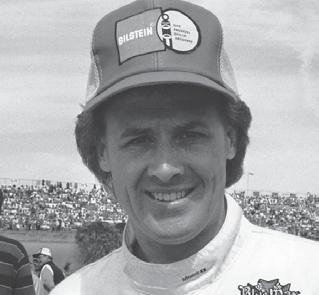
Wallace came to NASCAR’s top series determined to make a name for himself as he had done on the short tracks near his home in Missouri and with promoter Rex Robbins’ American Speed Association.
Wallace’s first venture into NASCAR’s premier series came in 1980 when he finished second to Earnhardt at Atlanta Motor Speedway while driving for auto racing icon Roger Penske. Even though unknown and untested, Wallace’s performance that day resulted in him being recognized as a possible future star.
After earning Cup Series rookie-of-the-year honors with team owner Cliff Stewart in 1984, Wallace continued with Stewart in 1985 with little success. Then, in 1986, NASCAR team owner and drag racing legend Raymond Beadle called.
Race wins began to accumulate and in 1988, Wallace made a strong challenge for the Cup Series championship. Come 1989, Wallace and crew chief Barry Dodson were cocked and ready to win the coveted title.
Wallace was challenged throughout the year by three-time champion Earnhardt. Both drivers amassed virtually identical numbers when it came to success on the track. They were close on wins, top-five finishes and top-10 results, so much so that only 12 points separated them when the checkered flag fell over the final race of the season at Atlanta Motor Speedway.
Wallace entered the finale with a 78-point lead but problems dropped that lead to 12 at the checkered flag. Earnhardt won the race but it wasn’t enough to overcome the deficit.
RUSTY WALLACE, driver of the No. 27 Blue Max Racing Pontiac, won six races en route to securing the lone Cup Series championship of his 26-year career. Wallace was second in points in June at Pocono Raceway. He took the lead with five races remaining and held it for the remainder of the season. After his final victory of the year at Richmond Raceway in September, Wallace logged eight top-10 finishes in the final eight races.
BEST RACE
DRIVING THE NO. 28
Robert Yates Racing Ford, second-generation wheelman Davey Allison took the lead from Morgan Shepherd with nine laps remaining and beat Terry Labonte to the stripe by threecar lengths to win the May 7 Winston 500 at Talladega Superspeedway. Revised carburetor specifications for this race resulted in slower speeds and tight racing. Mark Martin’s pole speed was nearly 20 mph off the track record.
RUSTY WALLACE
drove Raymond Beadle’s No. 27 Blue Max Racing Pontiac to six victories and 20 top-10 finishes in 29 races.
The familiar No 3 Richard Childress Racing Chevrolet driven by Dale Earnhardt had five wins and 19 top-10 results.
DATE
Feb. 15
March 1
LOCATION WINNER
Daytona International Speedway Bill Elliott
Rockingham Speedway Dale Earnhardt
March 8 Richmond Raceway Dale Earnhardt
March 15 Atlanta Motor Speedway Ricky Rudd
March 29
Darlington Raceway Dale Earnhardt
April 5 North Wilkesboro Speedway Dale Earnhardt
Apr. 12
Apr. 26
May 3
May 24
Bristol Motor Speedway Dale Earnhardt
Martinsville Speedway Dale Earnhardt
Talladega Superspeedway Davey Allison
Charlotte Motor Speedway Kyle Petty
May 31 Dover Motor Speedway Davey Allison
June 14
June 21
June 28
Pocono Raceway Tim Richmond
Riverside International Raceway Tim Richmond
Michigan International Speedway Dale Earnhardt
July 4 Daytona International Speedway Bobby Allison
July 19
July 26
Pocono Raceway Dale Earnhardt
Talladega Superspeedway Bill Elliott
Aug. 10 Watkins Glen International Rusty Wallace
Aug. 16
Aug. 22
Michigan International Speedway Bill Elliott
Bristol Motor Speedway Dale Earnhardt
Sept. 6 Darlington Raceway Dale Earnhardt
Sept. 13 Richmond Raceway Dale Earnhardt
Sept. 20 Dover Motor Speedway Ricky Rudd
Sept. 27 Martinsville Speedway Darrell Waltrip
Oct. 4 North Wilkesboro Speedway Terry Labonte
Oct. 11
Oct. 25
Charlotte Motor Speedway Bill Elliott
Rockingham Speedway Bill Elliott
Nov. 8 Riverside International Raceway Rusty Wallace
Nov. 22 Atlanta Motor Speedway Bill Elliott
PRESIDENT George H.W. Bush
NO. 1 AT THE BOX OFFICE
Batman NO. 1 SONG
“Look Away” by Chicago
POP CULTURE
ABC’s coverage of Game 3 of the World Series was interrupted when an Earthquake struck San Francisco.
GALLON OF GAS
$1.02
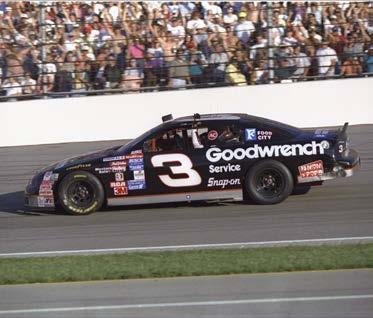








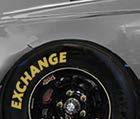

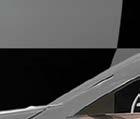
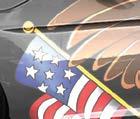

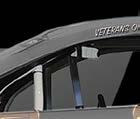
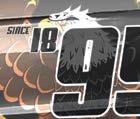

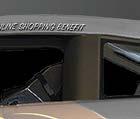
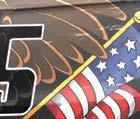
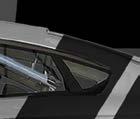
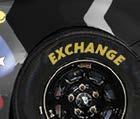

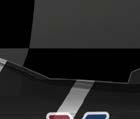
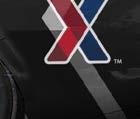





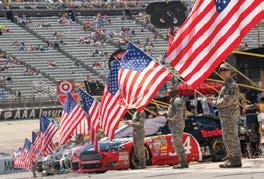






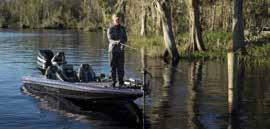


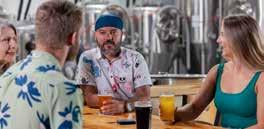
Are you ready for an adrenaline-packed escape? Look no further than Putnam County, Florida! Whether you like the rugged outdoors or are a thrill-seeker, we’ve got something for everyone. Ready to make memories? Pack your gear and head to Putnam County, where the wild meets the welcoming.
Fishing Paradise: Cast your line into the renowned St. Johns River. Catch trophy bass, catfish, and more. The thrill of the catch awaits!
Off-Road Adventures: Rev up your ATV and hit the trails. Explore lush forests, muddy paths, and challenging terrain. Get your heart racing!
Hunting Haven: Putnam County offers prime hunting grounds. Deer, turkey, pheasant, wild hogs and gators. It’s a hunter’s paradise. Make your adrenaline roar!
Water Sports Galore: Kayak, paddleboard, or jet ski on our many waterways. Enjoy the sun on your skin and the natural beauty of the water. Immerse yourself in Nature!
Skydiving: Are you ready to defy gravity and feel the rush of the freefall. Soak in breathtaking views on your descent. Experience the thrill!
Local Brews & Eats: After a day of adventure, unwind at a laid-back brewery or wine bar. Sip on craft beers or savor mouthwatering cuisine!